Home •This week’s blog • Time for tea • Blackbirds • Border collies
I was never happy visiting zoos as a child, but after reading Gerry Durrell’s books in my teens I longed to go to the zoo he established on Jersey. His aim then, and ever afterwards, was to provide a sanctuary for endangered species.
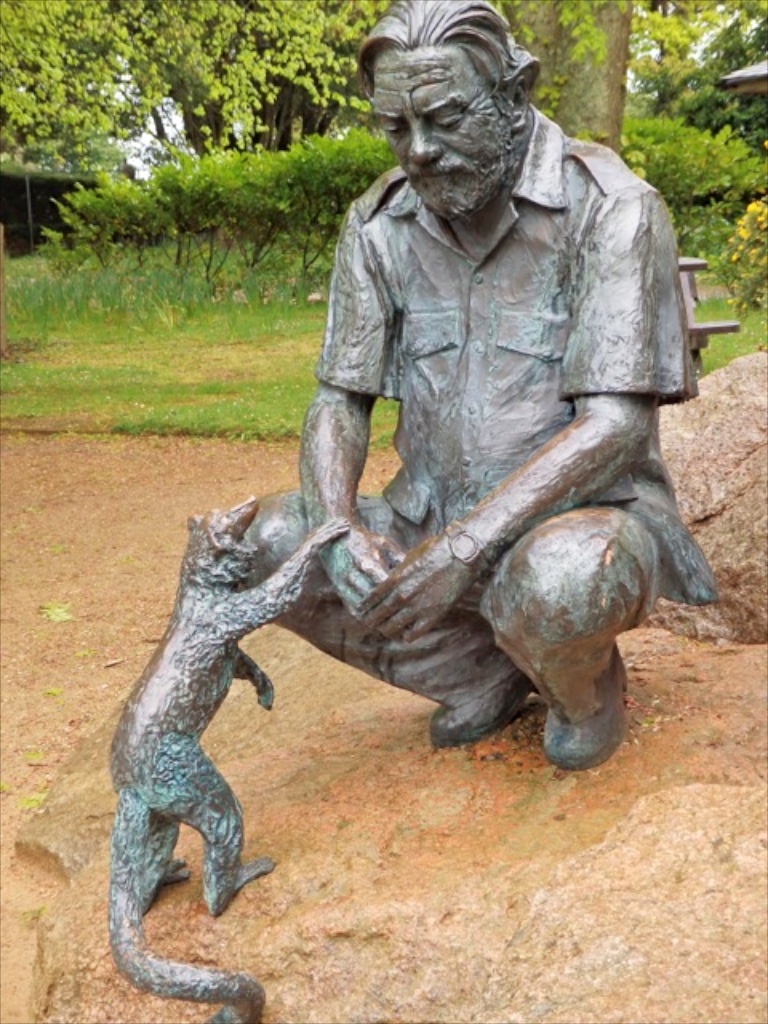 This was to be a place where they could be kept in safety, and where they could be studied to improve their chances both of breeding there in a suitable environment and of eventually being returned to their original habitat when the time was right. It was also to be a place where conservationists from round the world could be trained to help the animals of their native countries.
This was to be a place where they could be kept in safety, and where they could be studied to improve their chances both of breeding there in a suitable environment and of eventually being returned to their original habitat when the time was right. It was also to be a place where conservationists from round the world could be trained to help the animals of their native countries.
It was some years before I got to Jersey zoo, which is now the Durrell Wildlife Park, home to the Durrell Wildlife Conservation Trust – both named in Gerry’s honour after his death. To many people, of course, it is still simply Jersey Zoo.
I’ve been going for many years now, staying for a few days on the island each time, and spending every possible hour at Durrell watching the animals. Visits were on hold for a few years, as I couldn’t leave Tirn, my old dog, for days at a time, but now Bryn, my young Border collie, whizzes happily into kennels and I’m free once again to visit the creatures at Durrell. And of course it isn’t just endangered species from other countries that I see here, but ones from our own too – it was here that I first saw a red squirrel.
Below are accounts of what I see now, and one day, possibly soon if I’m organised, I’ll write up my diaries of my earlier visits. As this page is getting rather big, the older articles on particular species – starting with bears and otters – are being moved to archive pages, which can be accessed from the list of contents below.
The Ark's inhabitants
Bats 1
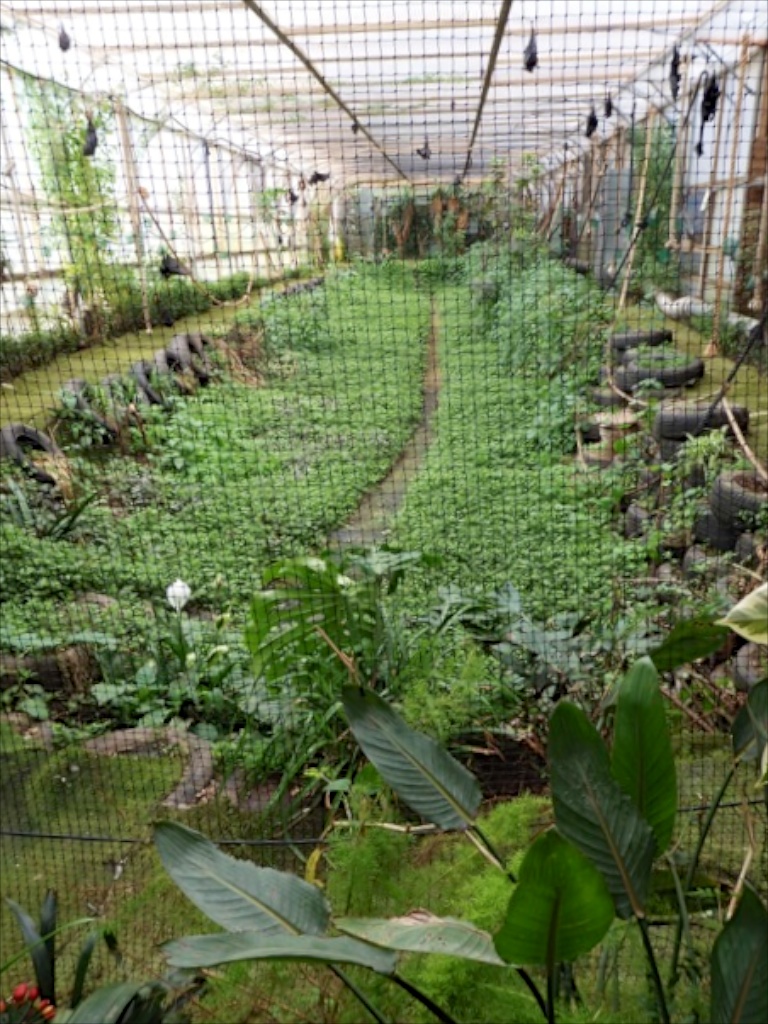 It’s one long stretch of luxuriant greenery growing in steamy warmth around the shallow rectangular declivity in the ground and creeping towards the ropes that make the open centre a huge version of a spider’s web. The side walls and roof of this tunnel-like enclosure are plastic, letting the sun’s warmth in. Once in, it’s retained by the earth-filled tyres that create the banks around the tunnel and make up the end walls of the enclosure, which are lightened here and there with patterns created by bottle ends.
It’s one long stretch of luxuriant greenery growing in steamy warmth around the shallow rectangular declivity in the ground and creeping towards the ropes that make the open centre a huge version of a spider’s web. The side walls and roof of this tunnel-like enclosure are plastic, letting the sun’s warmth in. Once in, it’s retained by the earth-filled tyres that create the banks around the tunnel and make up the end walls of the enclosure, which are lightened here and there with patterns created by bottle ends.
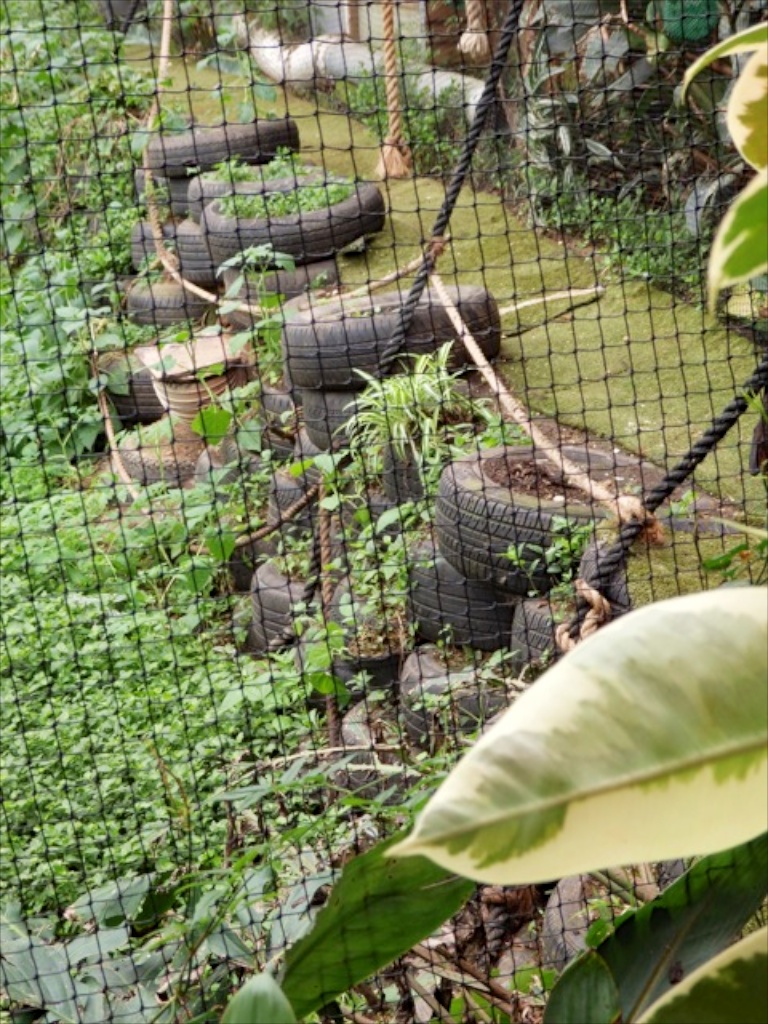 The tyres create a heat sink that releases heat into the structure long after the sun has gone, and the warmth of waste fires is sometimes channelled into the tyres to top up the heat level in colder months. The system has been so successful that there have been no heating bills since the enclosure was built. And the creatures that live here can revel in the warm moist atmosphere that they need.
The tyres create a heat sink that releases heat into the structure long after the sun has gone, and the warmth of waste fires is sometimes channelled into the tyres to top up the heat level in colder months. The system has been so successful that there have been no heating bills since the enclosure was built. And the creatures that live here can revel in the warm moist atmosphere that they need.
They are everywhere, hanging like misshapen black fruits from the roof, climbing with remarkable speed up and down the hanging ropes, or crawling with unexpected speed across the turf-covered ground. Their main aim when moving is to reach or defend 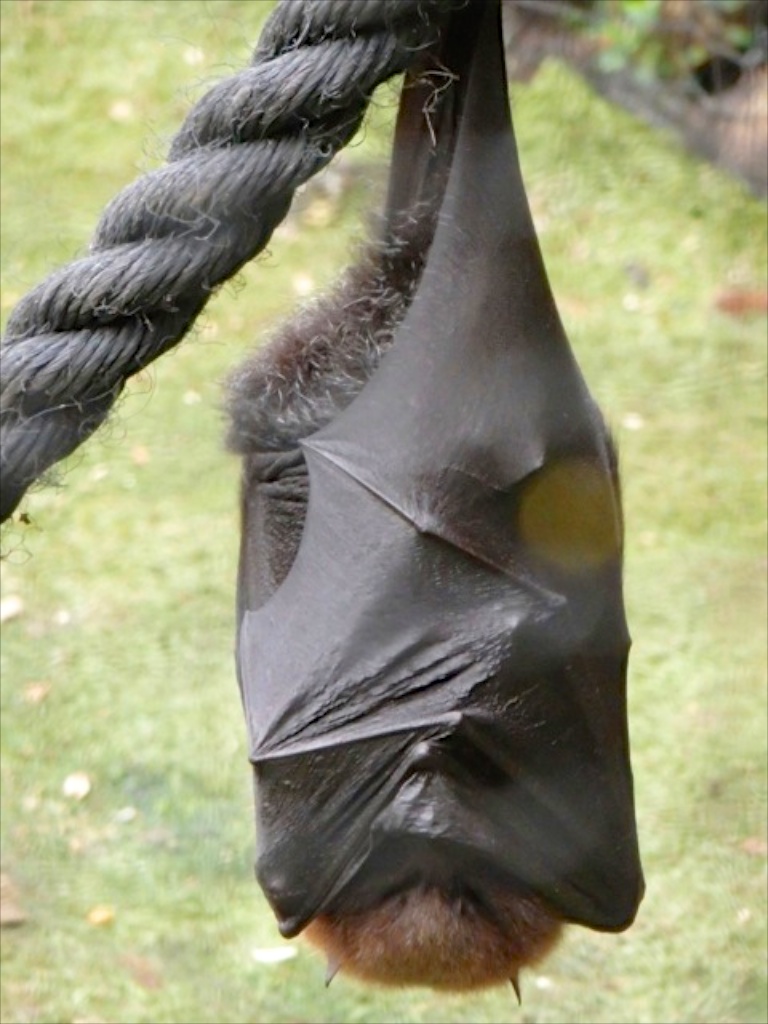 the chopped fruit that is stuffed into hanging baskets, or the orange halves spiked temptingly around the enclosure, or the beakers of nectar that stand halfway up the walls, for these are fruit bats.
the chopped fruit that is stuffed into hanging baskets, or the orange halves spiked temptingly around the enclosure, or the beakers of nectar that stand halfway up the walls, for these are fruit bats.
Those living here are mainly Livingstone fruit bats, black with a pale gold crescent on their backs. They share the enclosure with Rodrigues fruit bats, who are conspicuously different with their golden heads. Both kinds are active in the day, needing light to operate as they don’t have echo location radar, so the enclosure is always a scene of activity.
Bird Tunnel
Heavy footsteps sounded on the plastic roof, walking slowly and deliberately in an unsteady line across it. Looking up, the imprint of large webbed feet marked the seagull’s route, first out, then back again as it marched along the perimeter of Durrell’s bird tunnel.
Within the netting pagoda ringed by the plastic was a lush wilderness of plants, surrounding the tree ferns that stretched up to the roof. A small stream trickled through the thick greenery, running through earthen flats covered with leaf litter. A wren perched on the edge of a bush, her beak full of nesting material. 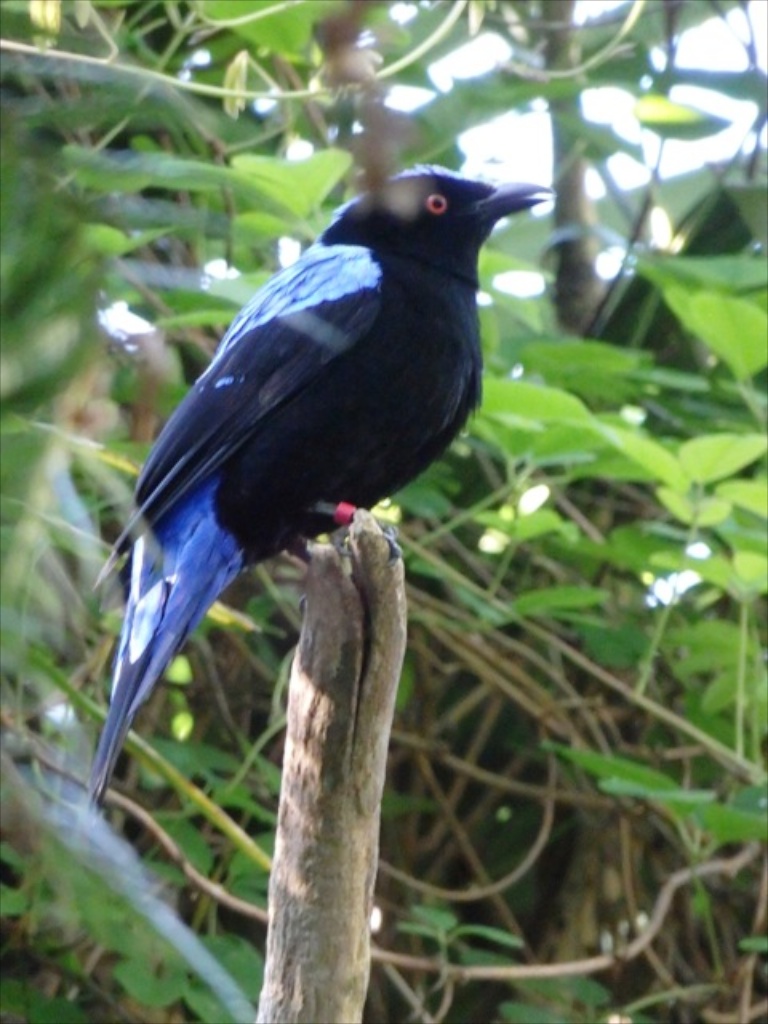 She has crept under or through the netting and is the only bird in here that I would normally see outside.
She has crept under or through the netting and is the only bird in here that I would normally see outside.
In the little central clearing, where dead branches reared to different heights, a bird the size of a song thrush perched on the top of the tallest prong. He lifted his head to stare at the footsteps, for his mate sat on a nearby nest. As he moved, his bright red eyes alert, sunlight lit his lovely blue back and tail, for he was a fairy bluebird (left), appropriately named in this place where the brightly coloured birds seem like magical variations of the ones I can see outside.
There are in fact thrushes here, and one of them squats on the ground staring at me. 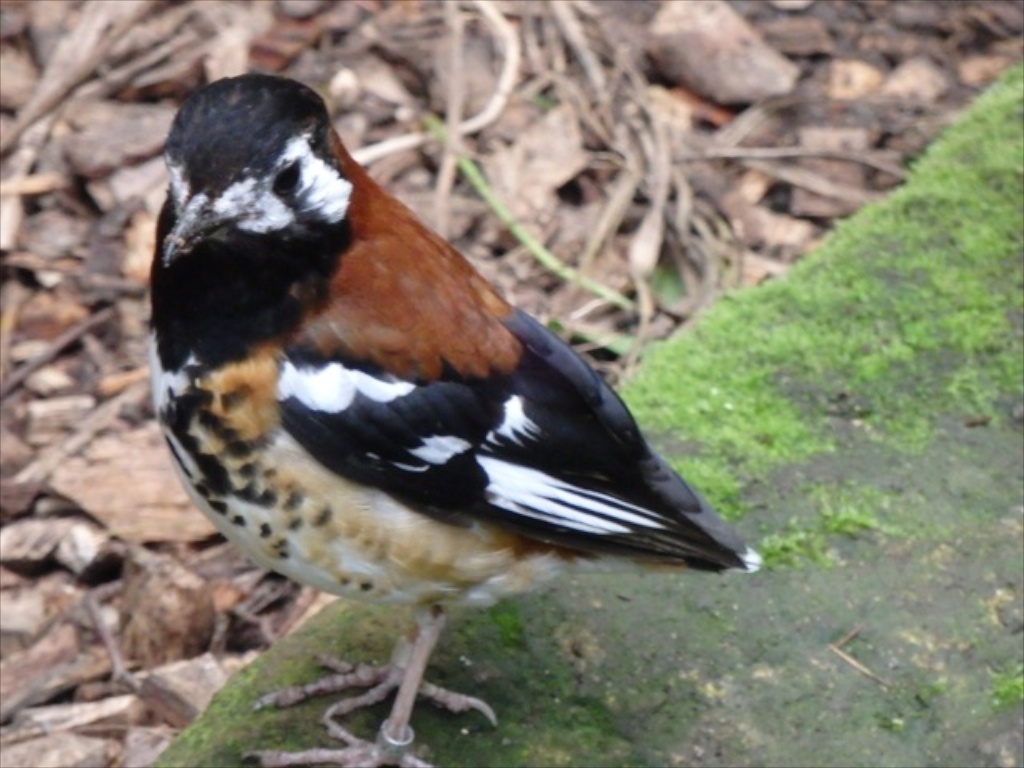 He’s a small creature with an imposing presence, perhaps from the white chest vividly marked with blotches, perhaps from the fixed eyes that seem to watch me quite belligerently from the white mask he wears across his black head. Probably his attention is fixed on me because this chestnut-backed thrush (right) also has a mate sitting nearby, whom he’s busily feeding with tiny grubs.
He’s a small creature with an imposing presence, perhaps from the white chest vividly marked with blotches, perhaps from the fixed eyes that seem to watch me quite belligerently from the white mask he wears across his black head. Probably his attention is fixed on me because this chestnut-backed thrush (right) also has a mate sitting nearby, whom he’s busily feeding with tiny grubs.
The robins here look as if a child has taken his colouring crayons to a drawing of a fat British robin, 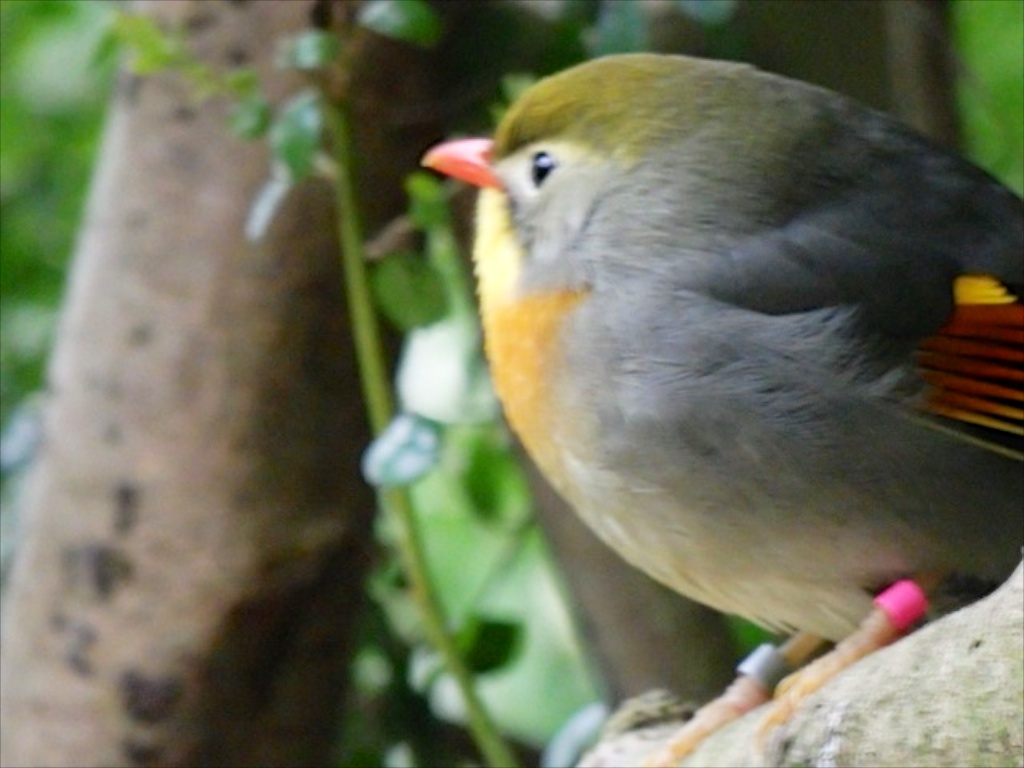 then life has been breathed into them so there they are, with their orange and yellow chest and wings, splashed with vivid pink to match their lip-sticked beaks (right). The Pekin robin stare is inquisitive, rather than challenging or belligerent, but its effect is magnified by numbers, because the three males here currently seem to stick together.
then life has been breathed into them so there they are, with their orange and yellow chest and wings, splashed with vivid pink to match their lip-sticked beaks (right). The Pekin robin stare is inquisitive, rather than challenging or belligerent, but its effect is magnified by numbers, because the three males here currently seem to stick together.
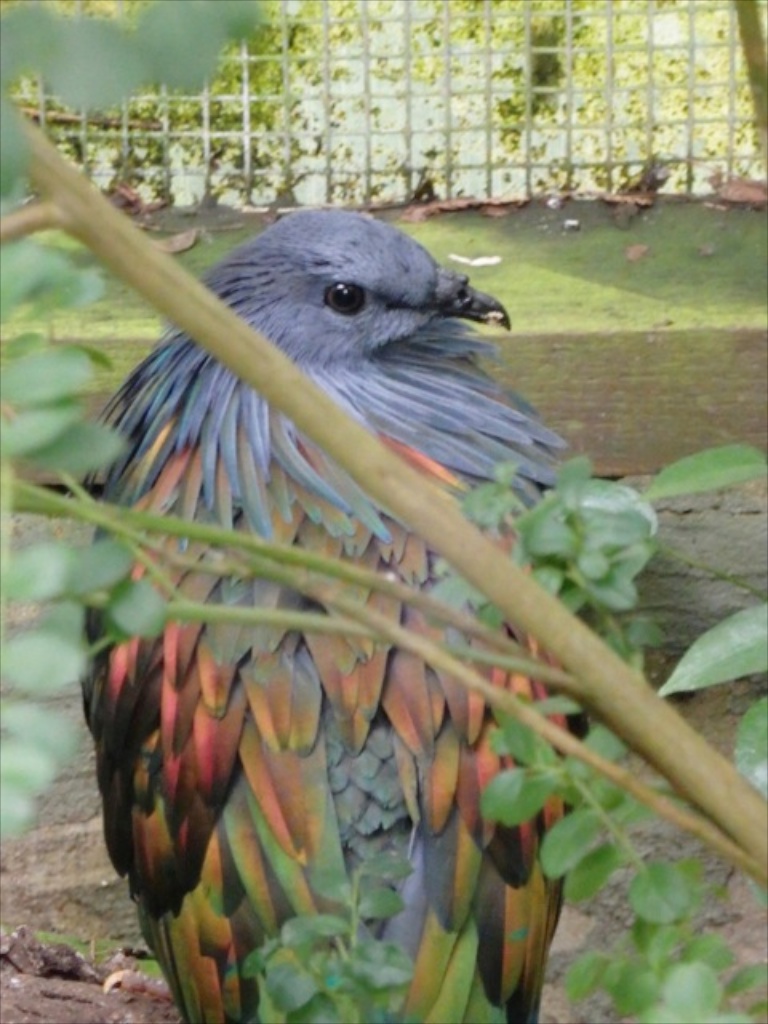 The pigeons come as a pair, as do the wood pigeons in my garden. But these Nicobar pigeons (left) have an iridescent coat of many colours, topped by the semblance of a carnival mask with a wide fringed edging, more conspicuous in the male, which flaps gently as he struts about the ground.
The pigeons come as a pair, as do the wood pigeons in my garden. But these Nicobar pigeons (left) have an iridescent coat of many colours, topped by the semblance of a carnival mask with a wide fringed edging, more conspicuous in the male, which flaps gently as he struts about the ground.
The bleeding heart doves (right) look as though they should be part of a Catholic religious festival. Their creamy buff chests are marked startlingly with a vivid red stain, 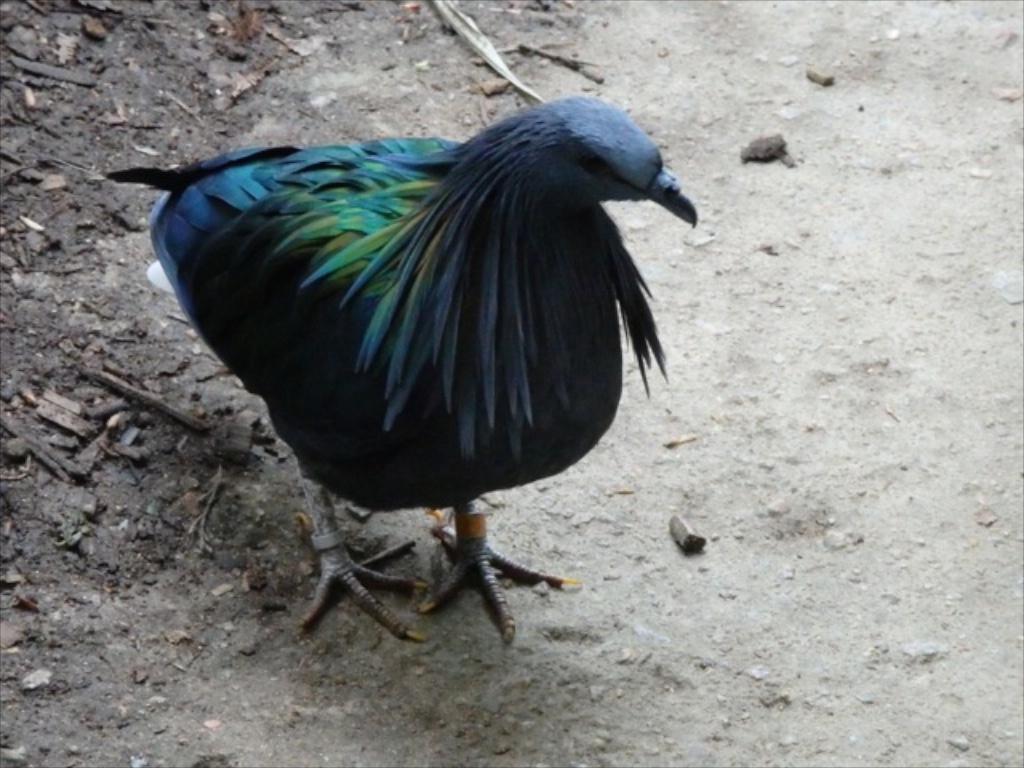 often in the shape of a heart, as striking a sight as the wounds of many plaster images of martyred saints. The deepness of the colour contrasts with the bird’s main shades of soft pinky-brown back and pale turquoise neck, but its overall appearance is very different to the pink and grey worn by my garden doves.
often in the shape of a heart, as striking a sight as the wounds of many plaster images of martyred saints. The deepness of the colour contrasts with the bird’s main shades of soft pinky-brown back and pale turquoise neck, but its overall appearance is very different to the pink and grey worn by my garden doves.
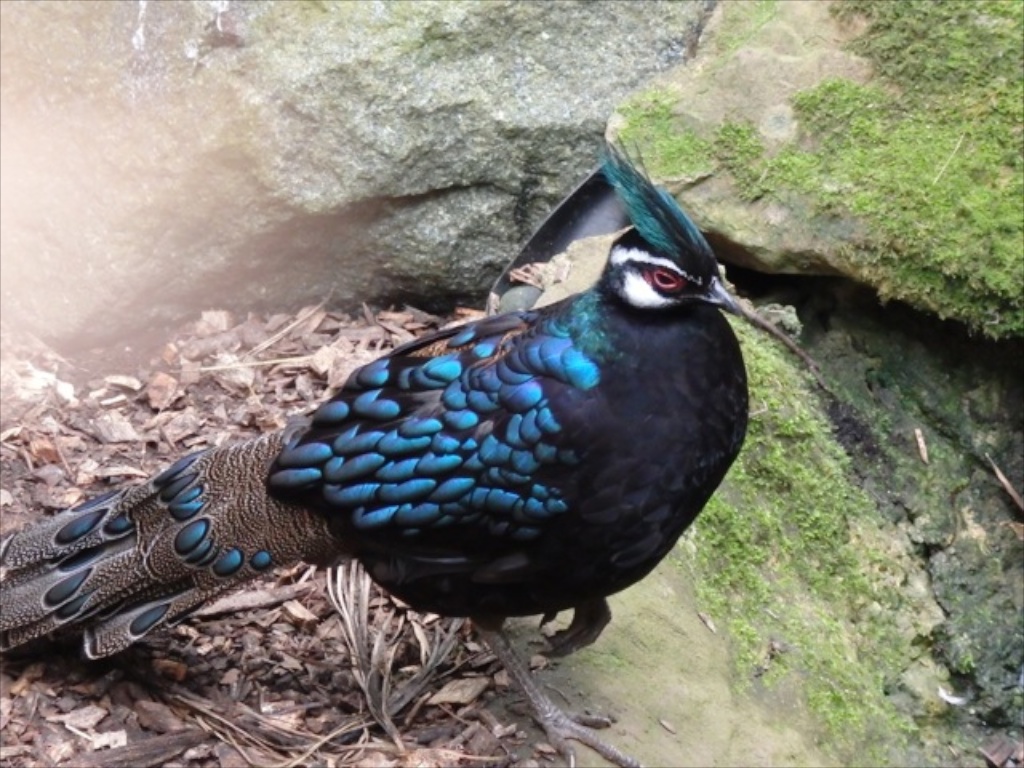 Even the pheasant here is a peacock-pheasant (left). It’s roughly the size and shape of the pheasants I see in England, but has stunning turquoise feathers in its wings, and turquoise eye markings on its tail, hence the name.
Even the pheasant here is a peacock-pheasant (left). It’s roughly the size and shape of the pheasants I see in England, but has stunning turquoise feathers in its wings, and turquoise eye markings on its tail, hence the name.
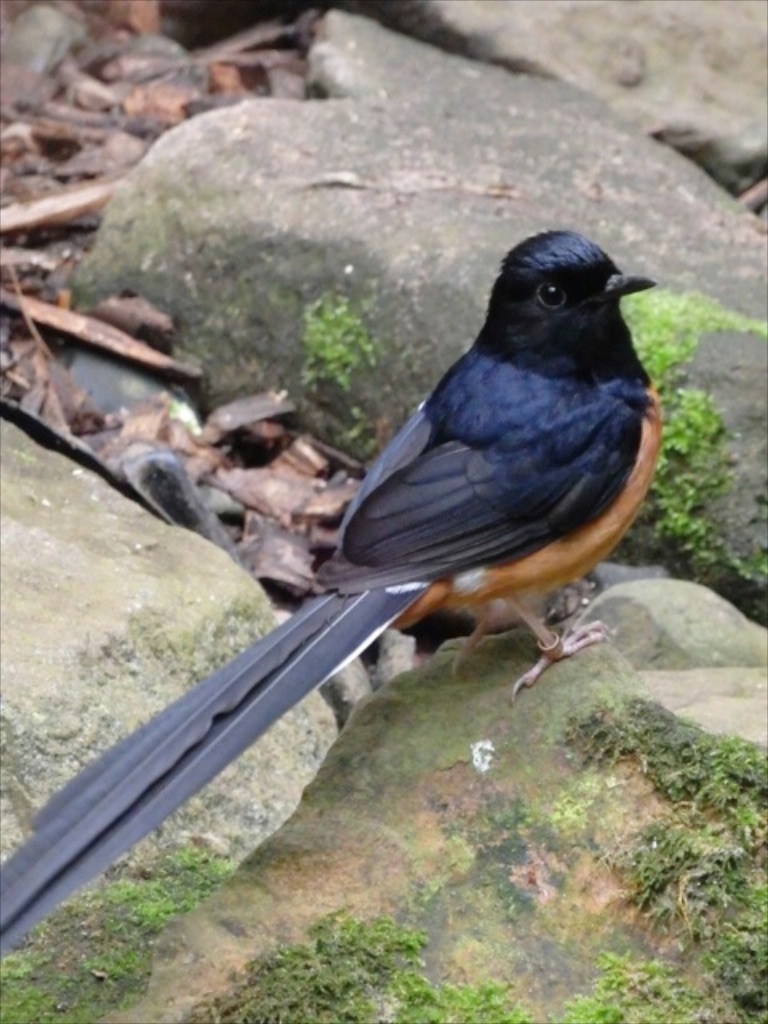 The musician of the bird tunnel is not a thrush or a robin, but a bird that has no obvious English equivalent. It is a white-rumped shama (right), whose name belies his elegant chestnut chest and black back. He perches in the open, his long tail balancing him on the branch as his liquid warbling fills the air in a solo that can be listened to for a long time.
The musician of the bird tunnel is not a thrush or a robin, but a bird that has no obvious English equivalent. It is a white-rumped shama (right), whose name belies his elegant chestnut chest and black back. He perches in the open, his long tail balancing him on the branch as his liquid warbling fills the air in a solo that can be listened to for a long time.
In the bird tunnel 2
In Durrell’s bird tunnel a local wren was singing piercing notes, perched on a branch near the entrance, so close that I could see the markings on the feathers splayed out in his tail, and see his beak moving. 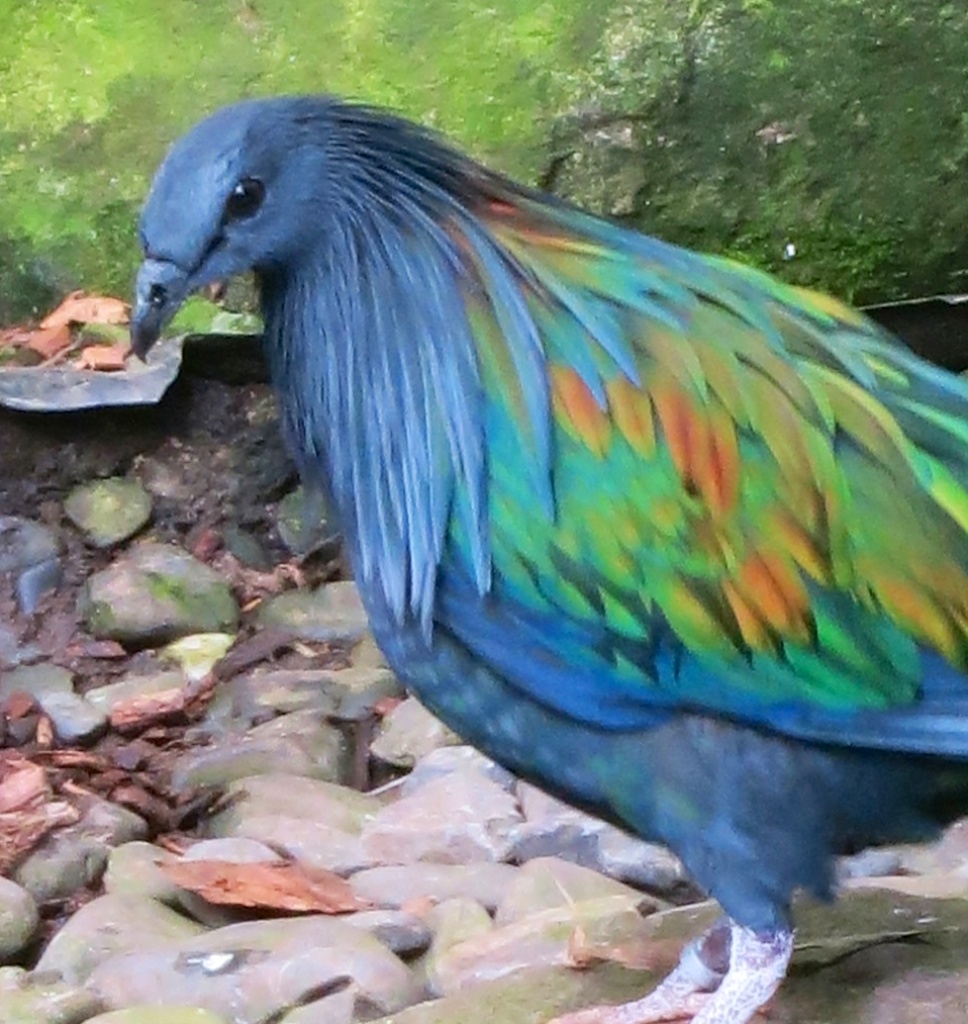 The other birds around him were more exotic.
The other birds around him were more exotic.
The pigeons were Nicobars (right), with their plumage of beautiful subdued colours and elegant crests that nodded as they pottered around on the ground. The doves that seemed to be everywhere wore bleeding heart marks on their chests. They scurried around on the ground by the stream, and wove through the stems of the bamboo thicket. They flew low through the undergrowth or perched on branches, where one glowered at me, and a nearby pair copulated briefly.
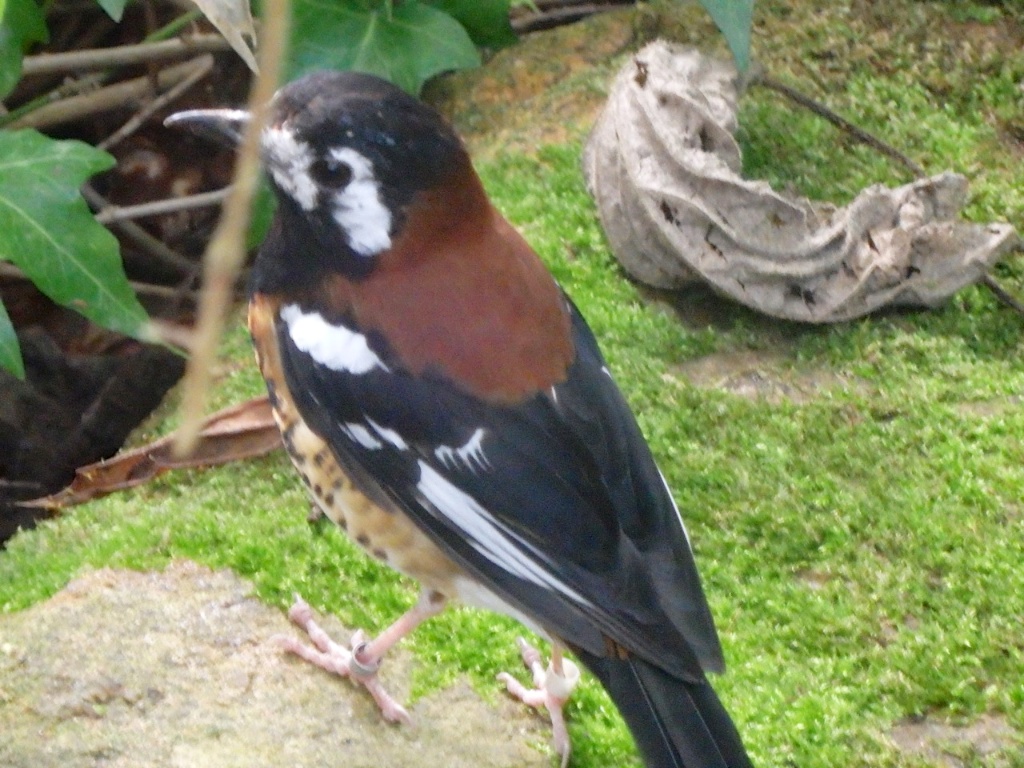 Mating was the main preoccupation. A male chestnut-backed thrush (left) stood in the pebbly streambed, feeding worms to a female. One of the many Pekin robins sat on the ground fluttering his wings and clicking his beak enticingly. Another robin perched briefly in a shrub, with strands of what looked like hair in her beak, presumably to thread into her nest. Nearby a female shama (below left) was collecting shreds of bamboo to build her own.
Mating was the main preoccupation. A male chestnut-backed thrush (left) stood in the pebbly streambed, feeding worms to a female. One of the many Pekin robins sat on the ground fluttering his wings and clicking his beak enticingly. Another robin perched briefly in a shrub, with strands of what looked like hair in her beak, presumably to thread into her nest. Nearby a female shama (below left) was collecting shreds of bamboo to build her own.
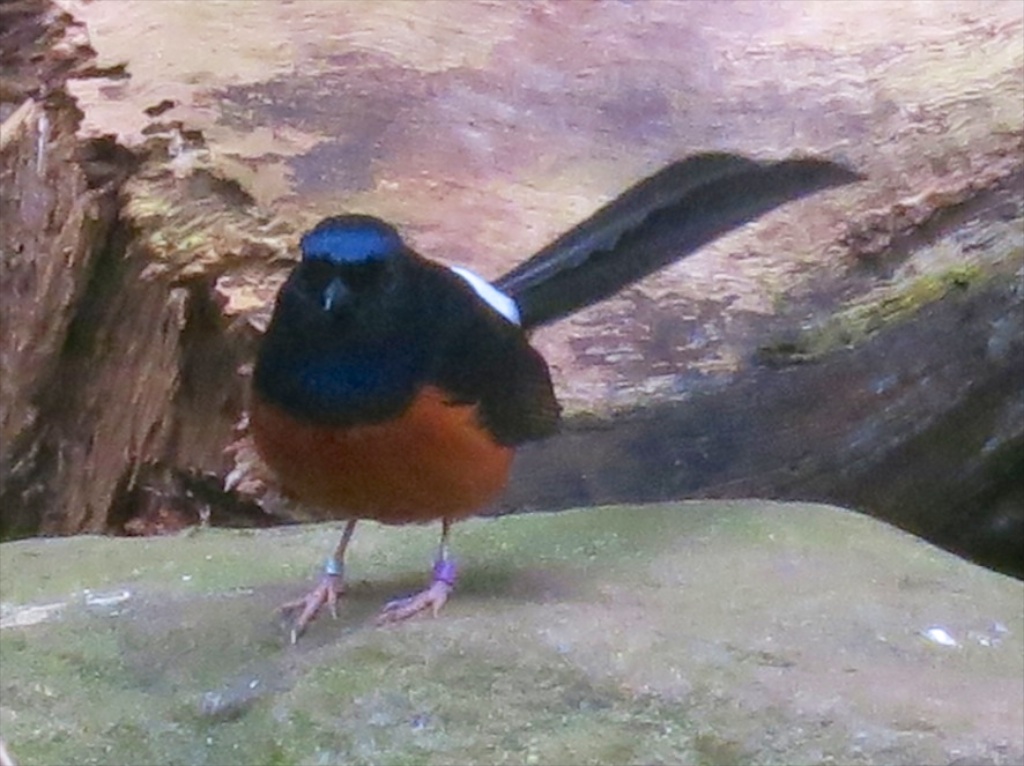
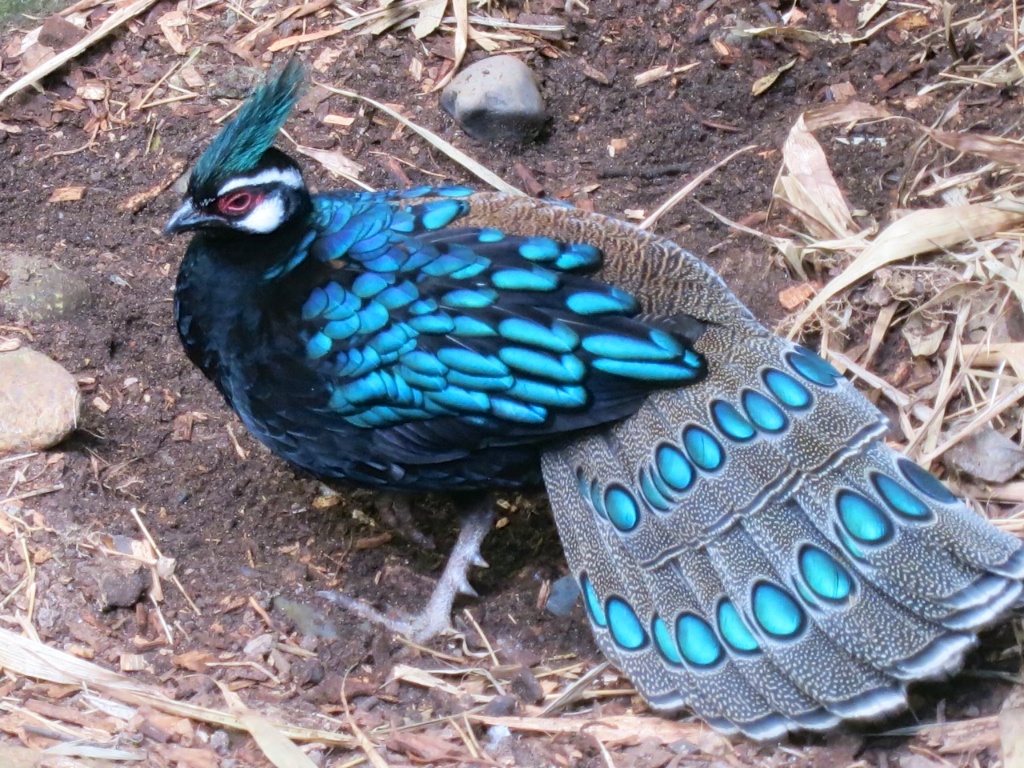
The wren was not the only bird to give voice in the bird tunnel. The Palawan peacock pheasant (above right) was constantly giving its alarm call, pausing only briefly to scratch up earth and peck through it.
15 April 2015
Lemurs
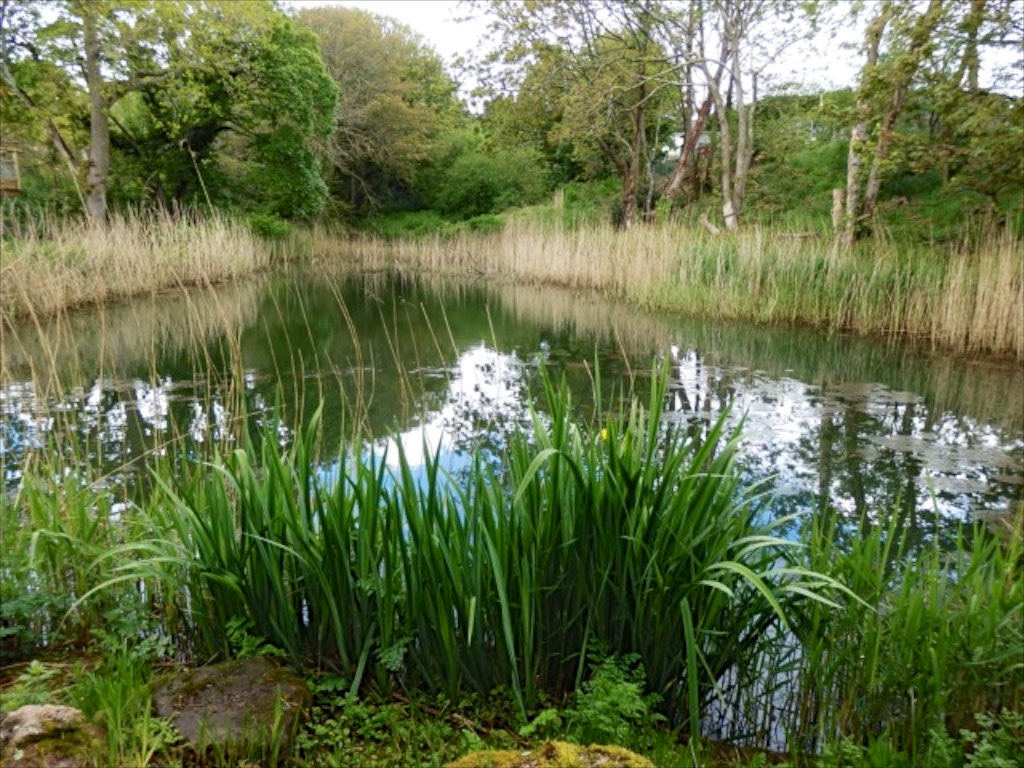 There’s a lake that runs between high sloping banks, thick with green shrubbery and shielded by the spreading canopies of oaks and sycamores. Yellow iris ring the edge of the water, pink Herb Robert and bright golden buttercups thread the grass in the open glades. Narrow beaten earth paths curve through the trunks on the eastern side, winding away into the distance. A great tit works his way over the bark crevices in a nearby oak, a robin searches through the grass, pausing occasionally
There’s a lake that runs between high sloping banks, thick with green shrubbery and shielded by the spreading canopies of oaks and sycamores. Yellow iris ring the edge of the water, pink Herb Robert and bright golden buttercups thread the grass in the open glades. Narrow beaten earth paths curve through the trunks on the eastern side, winding away into the distance. A great tit works his way over the bark crevices in a nearby oak, a robin searches through the grass, pausing occasionally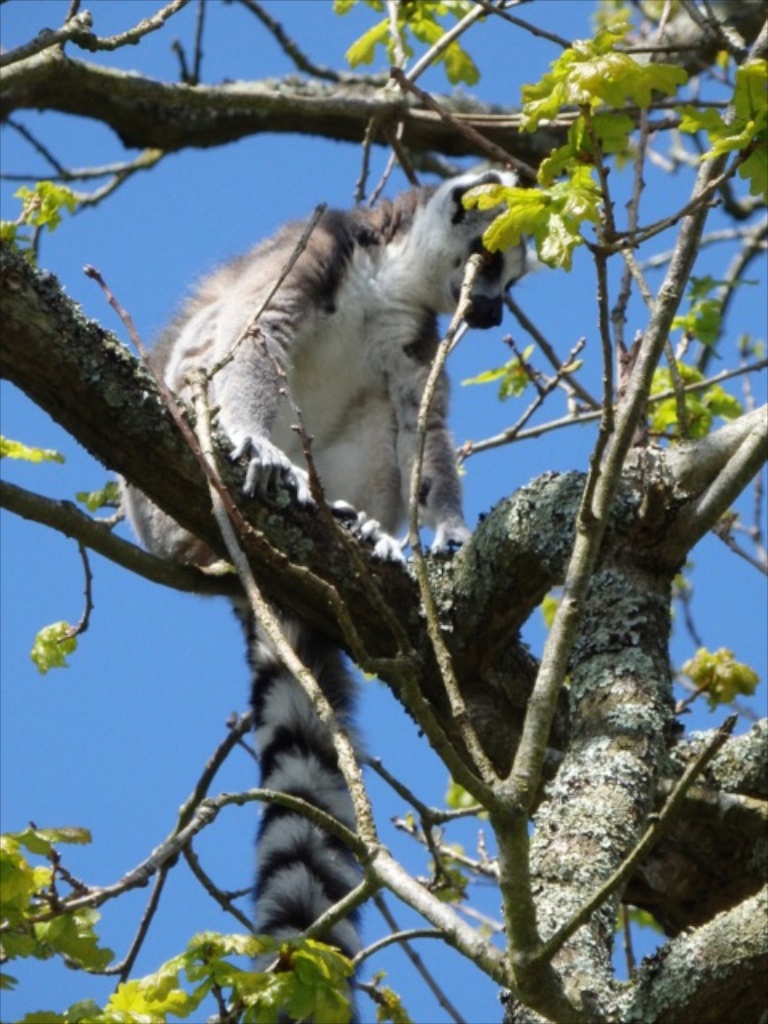 , his head cocked, to listen. He’s cautious, aware of the unusual look-outs perched at the ends of the topmost branches, betrayed only by the long black-ringed tails hanging down through the leaves.
, his head cocked, to listen. He’s cautious, aware of the unusual look-outs perched at the ends of the topmost branches, betrayed only by the long black-ringed tails hanging down through the leaves.
The two ring-tailed lemurs sit still for a short time, scanning the water below, but mainly watching activity on the far bank, where more of their kindred share space with a pair of black and white ruffed lemurs. The black and white ruffed lemurs look at first glance oddly like smaller, more slender pandas. There’s a low platform in the woodland where they like to huddle together sleeping, oblivious to the emerging spring beauty around them. But any strange noise and a pointed head lifts, golden eyes staring around accusingly, to see what’s going on. They seem to promote togetherness, so that where one goes the other follows.
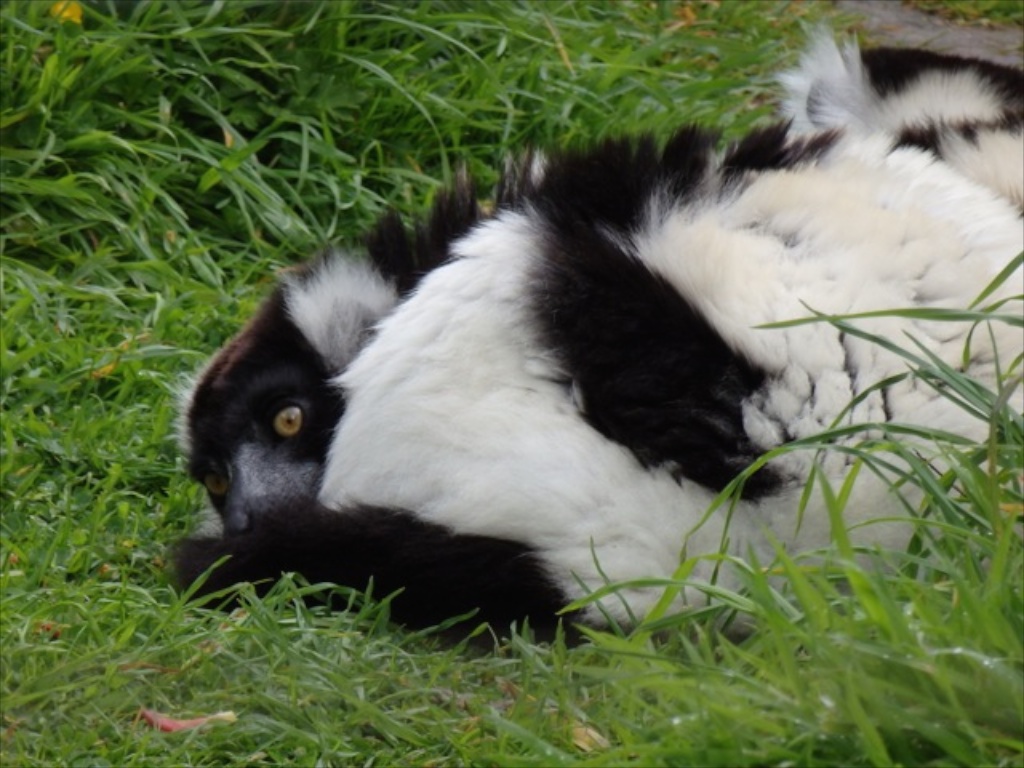 The watching ring-tailed lemurs across the lake stiffened with excitement when their larger cousins went wandering along a woodland path. Their pace quickened until the bulky bodies were gambolling along at speed, one chasing the other. They were positively frisky by the time they reached their upper house, and began to climb the wire of the enclosure. Before long the exertion was over, and they rested, dangling from the wire by all four feet.
The watching ring-tailed lemurs across the lake stiffened with excitement when their larger cousins went wandering along a woodland path. Their pace quickened until the bulky bodies were gambolling along at speed, one chasing the other. They were positively frisky by the time they reached their upper house, and began to climb the wire of the enclosure. Before long the exertion was over, and they rested, dangling from the wire by all four feet.
Lemurs 2 – Alarm!
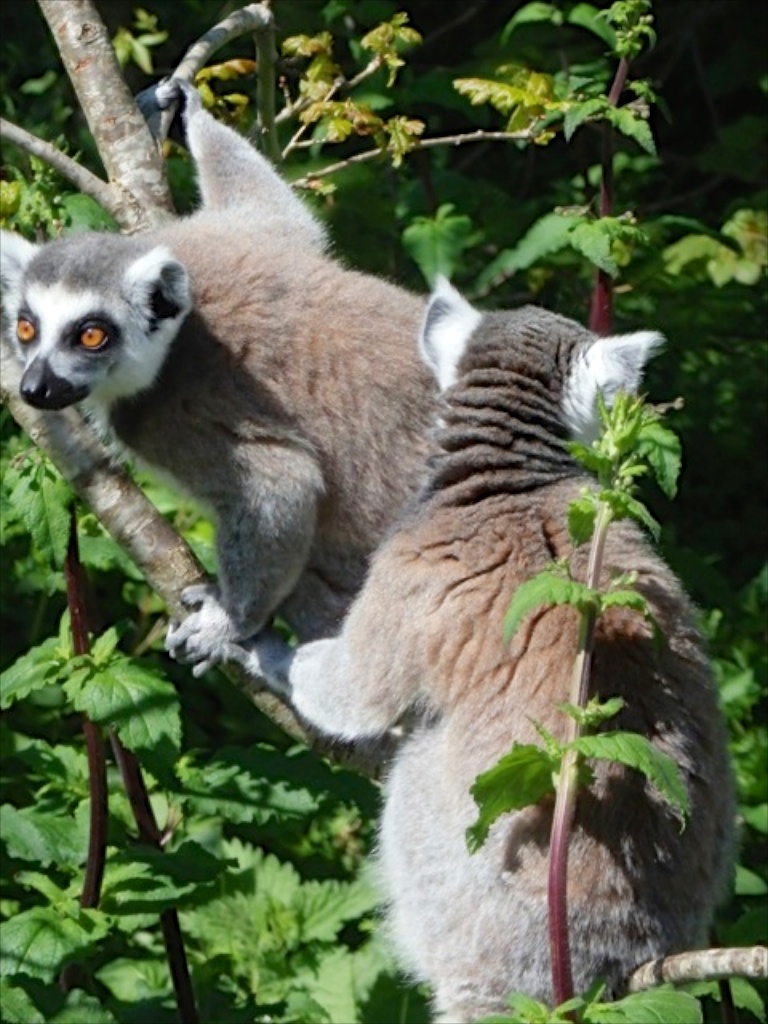 Loud screaming sometimes fills the park. It comes from the lemurs, who like to make lots of noise when they are annoyed or giving the alarm. Certainly nobody could be unaware that they’ve been disturbed.
Loud screaming sometimes fills the park. It comes from the lemurs, who like to make lots of noise when they are annoyed or giving the alarm. Certainly nobody could be unaware that they’ve been disturbed.
The ring-tails like to sunbathe on a shelf high on the wall of the hut on one side of the lake, with a view of all that's going on below. They saw a squabble break out on the far side between the two black and white ruffed lemurs. One was resting awkwardly on a across a rope that ran through a slender oak sapling, 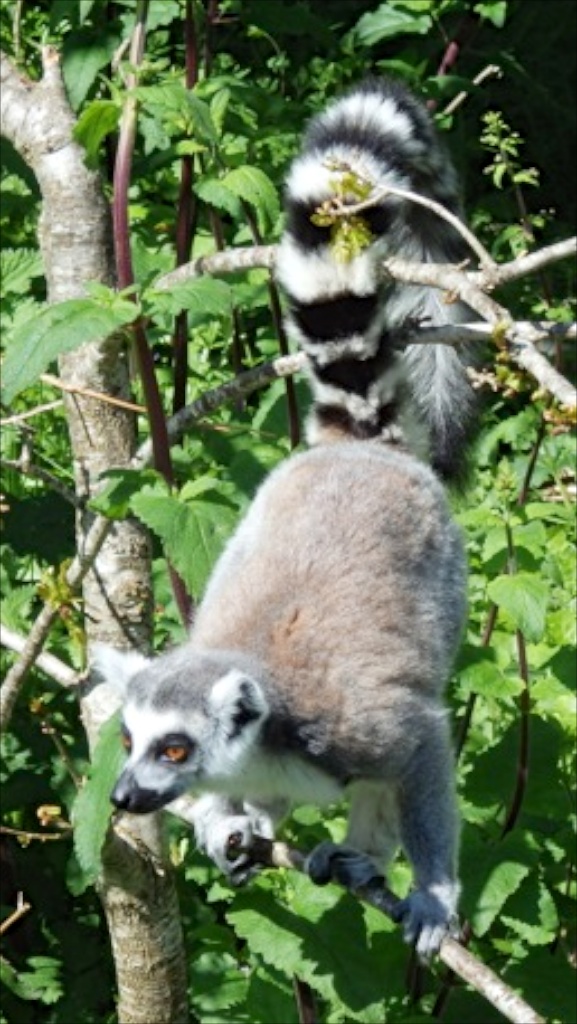 and loudly objected to the other’s attempts to join her on such a precarious perch. As soon as their spat began the ring-tails were screaming and screeching, whether in alarm or encouragement it was impossible to tell at first.
and loudly objected to the other’s attempts to join her on such a precarious perch. As soon as their spat began the ring-tails were screaming and screeching, whether in alarm or encouragement it was impossible to tell at first.
Then it became obvious that they were sounding the alarm as the ring-tails on the same side of the lake as the black and white ruffed lemurs were startled out of dozing on their own hut shelf. All the masked faces pointed upwards, the noise rising to a startling pitch. It was enough to drive away the large crow that had flown into the upper branches of an oak just above the female black and white lemur.
30 April 14
Meerkats
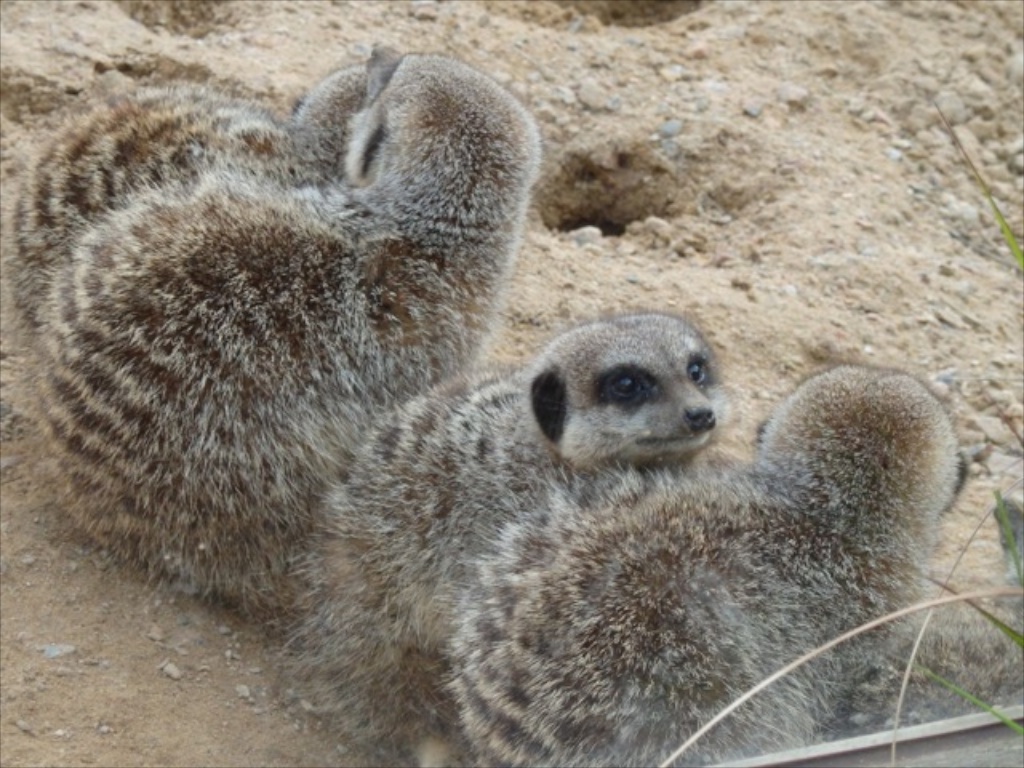 A row of little sentinels perched rigidly upright on the dust-coloured rocks in the desert landscape. Each little creature in the enclosure blended into the background, except for these guards. They were very visible even from a distance as they stood at their posts high on the pile of rocks that ran in a carefully disorganised reef across the miniature desert. Each sentinel’s head pointed upwards in a different direction, making sure that danger didn’t approach unobserved.
A row of little sentinels perched rigidly upright on the dust-coloured rocks in the desert landscape. Each little creature in the enclosure blended into the background, except for these guards. They were very visible even from a distance as they stood at their posts high on the pile of rocks that ran in a carefully disorganised reef across the miniature desert. Each sentinel’s head pointed upwards in a different direction, making sure that danger didn’t approach unobserved.
Around them the rest of the meerkat family went about daily life. They sunbathed in little groups, they groomed each other in tightly wrapped pairs, they scampered around peering under rocks and scratching the dry soil. But if one of the sentinels sounded the alarm the whole family bolted underground in one swift concerted movement.
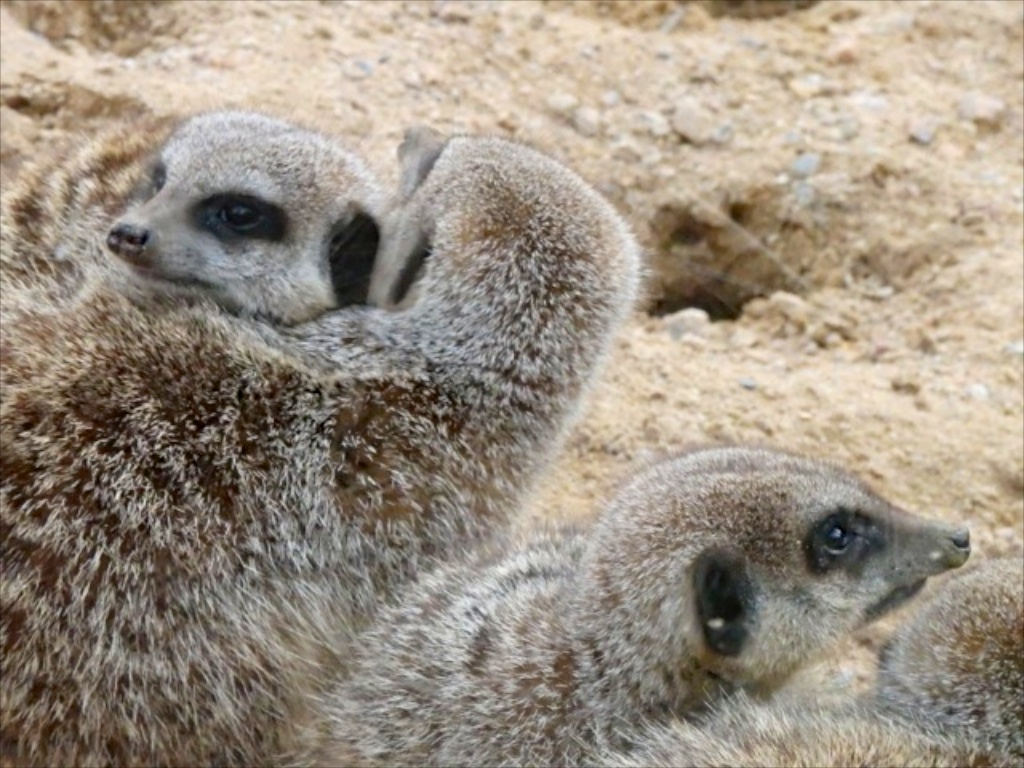
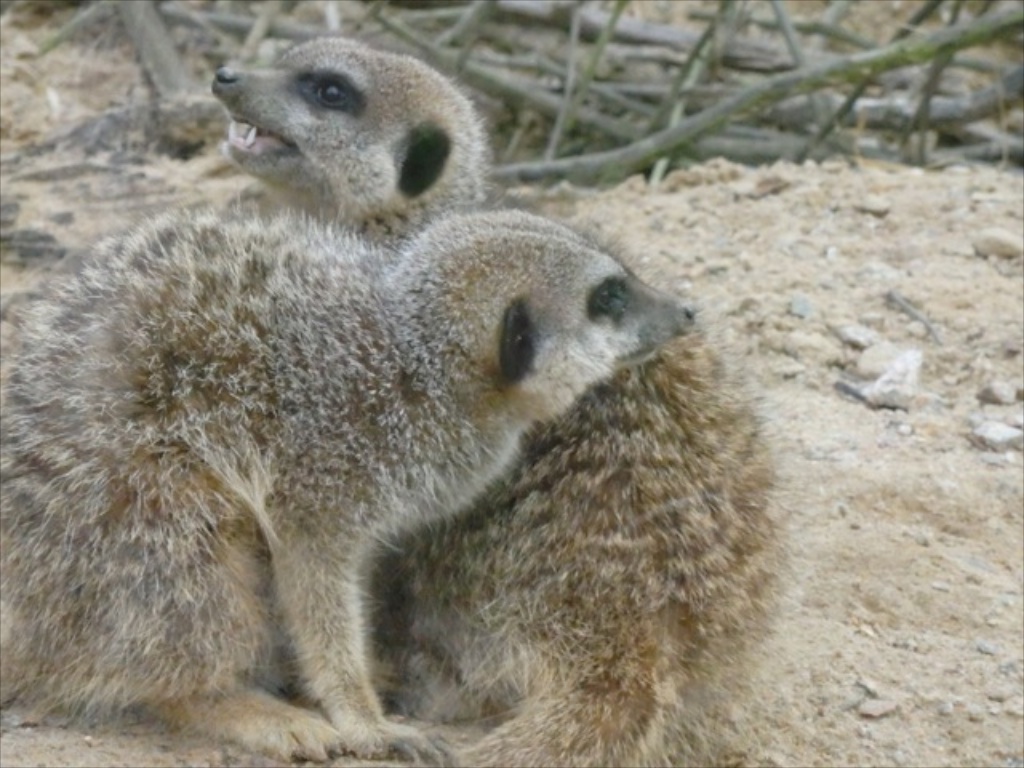
Adders
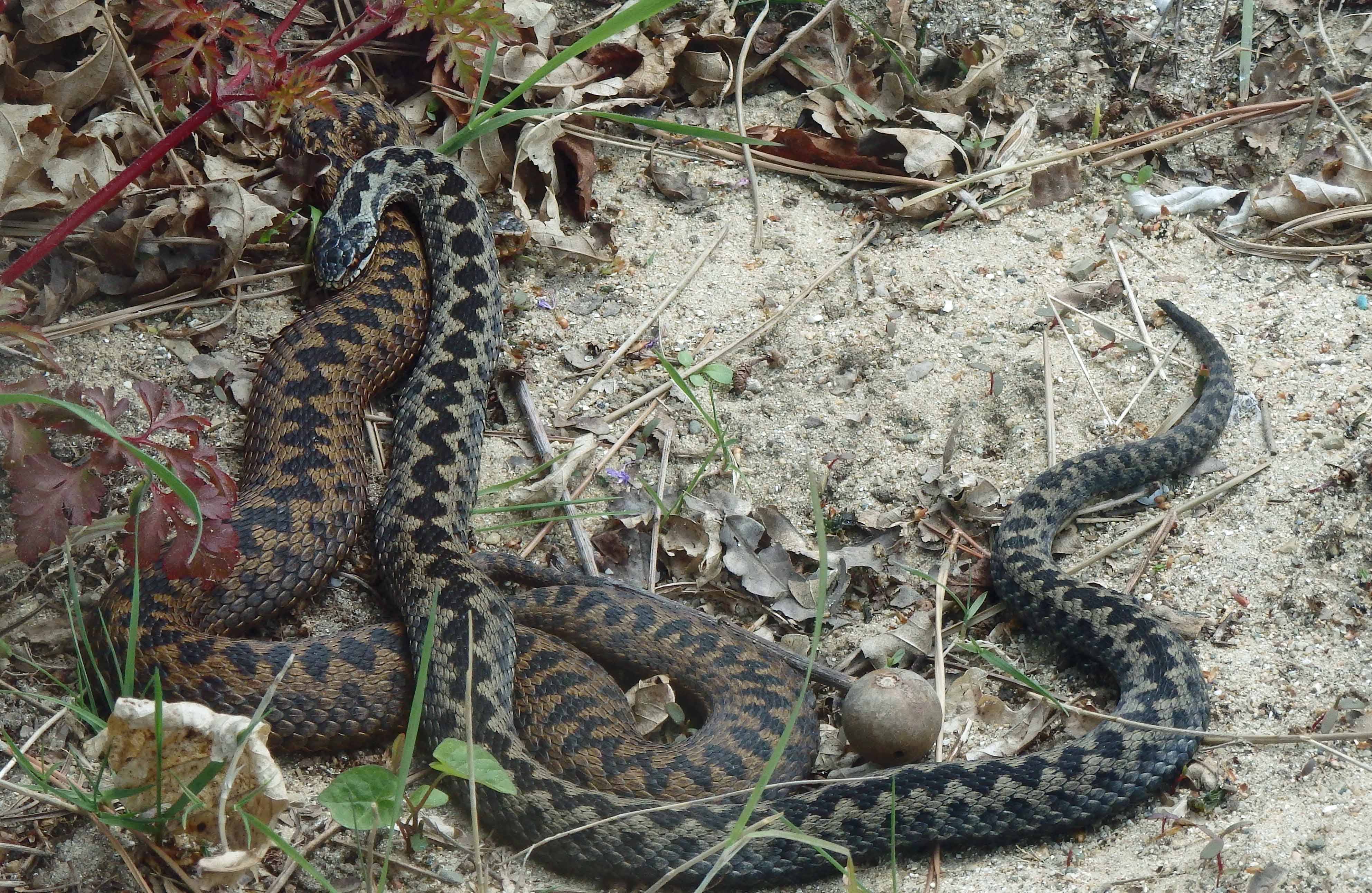
Two male adders were curled up in the sun in their outdoor space. One was on the ground, the other nearby in leaves under a bush. They were let out two weeks ago when the weather improved and had acclimatised to their surroundings in the fresh air.
Today three females were released into the enclosure at the end of their hibernation. They were larger and more active than the males, and very keen to meet them.
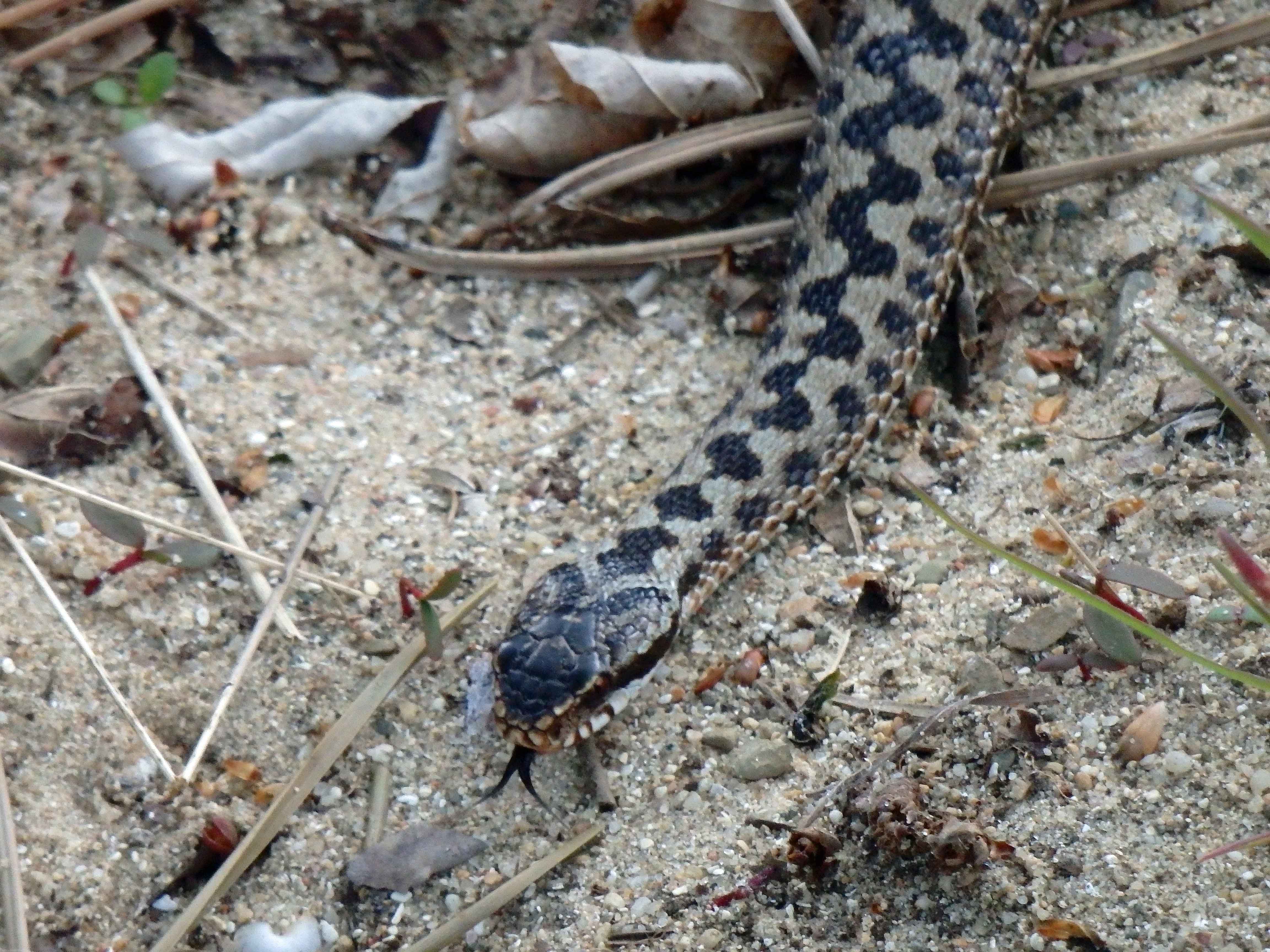
One female immediately slithered towards the male on the open ground, and he curved away, perhaps startled by her sudden appearance.
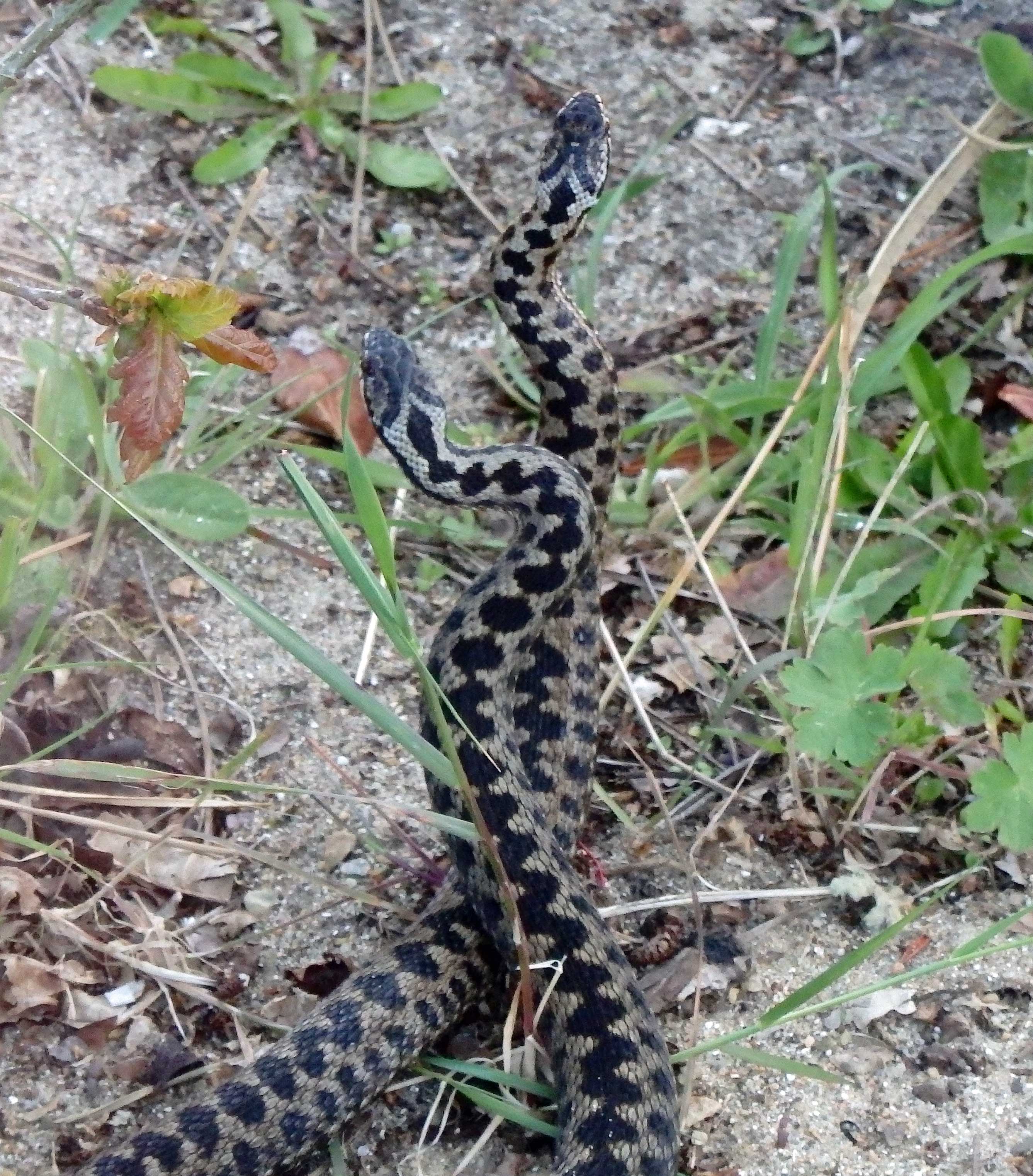 The second female made a beeline over logs for the second male, who reacted quite differently to the other male. When she came close this one lifted his head to watch her pass. She wove around, her head slightly lifted, tongue darting and flickering, then moved away. He lowered his head, but kept it out of his coils.
The second female made a beeline over logs for the second male, who reacted quite differently to the other male. When she came close this one lifted his head to watch her pass. She wove around, her head slightly lifted, tongue darting and flickering, then moved away. He lowered his head, but kept it out of his coils.
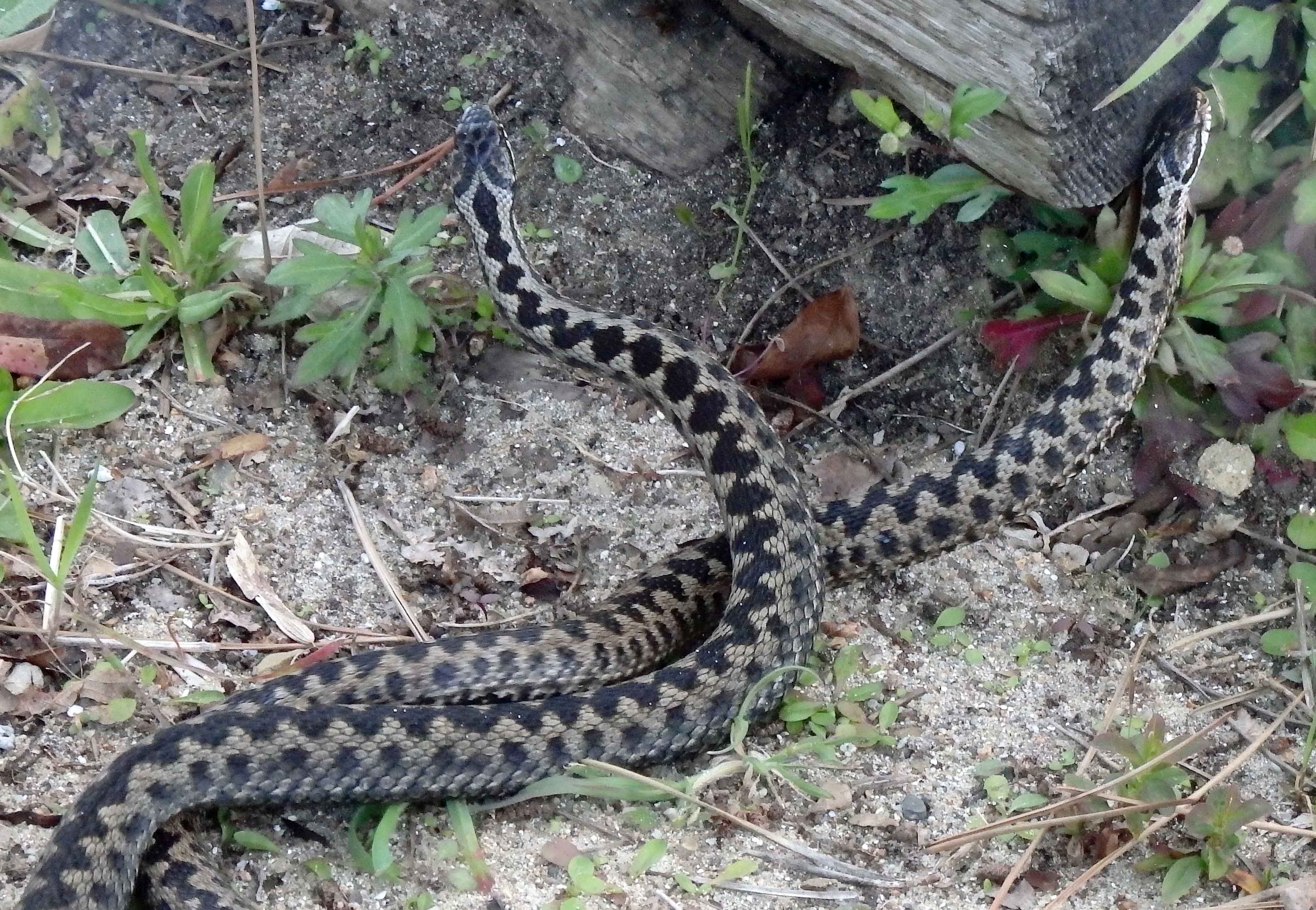
It was twenty-four hours later that I saw them again and their interaction had changed pace. A sleeping female was joined by a male. They rested together in dried leaves after she’d brought her head around to his. Another male slide over the two, and the first male moved off with him to struggle for dominance. At last number 1 retreated and number 2 went in triumph to join the female who had moved away during the males’ struggle. But number 1 wasn’t totally vanquished and followed 2’s tail tip, so that the pair of them moved off together again, struggling across the path and out of sight. The female didn’t move from her waiting position.
27/28 April 2016
Narrow-striped mongoose
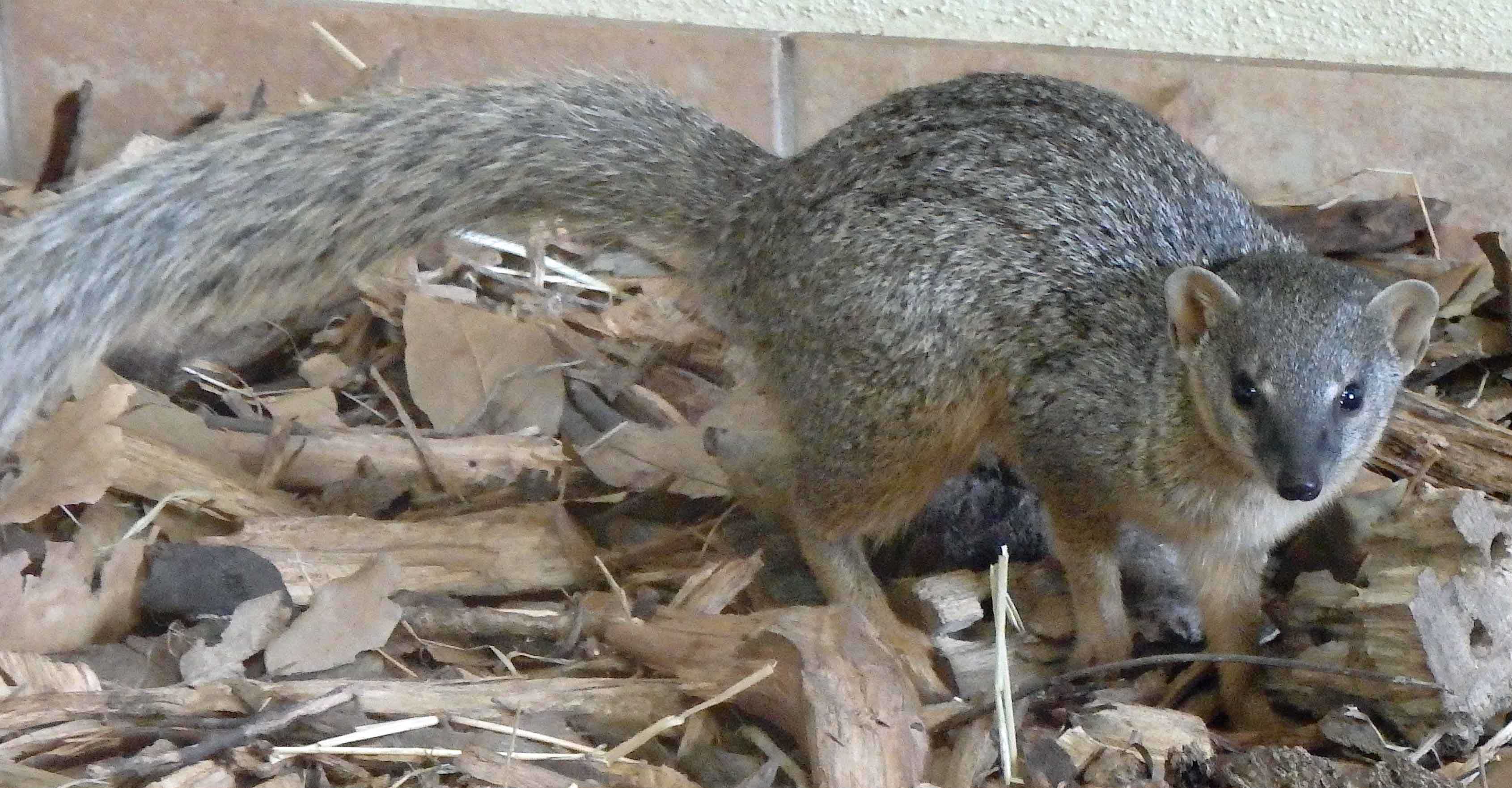
Last year’s narrow-striped mongoose baby survived. He’s a male called Hades and, as he’s nearly sexually mature, he will soon be moved on possibly to Chester to join two females.
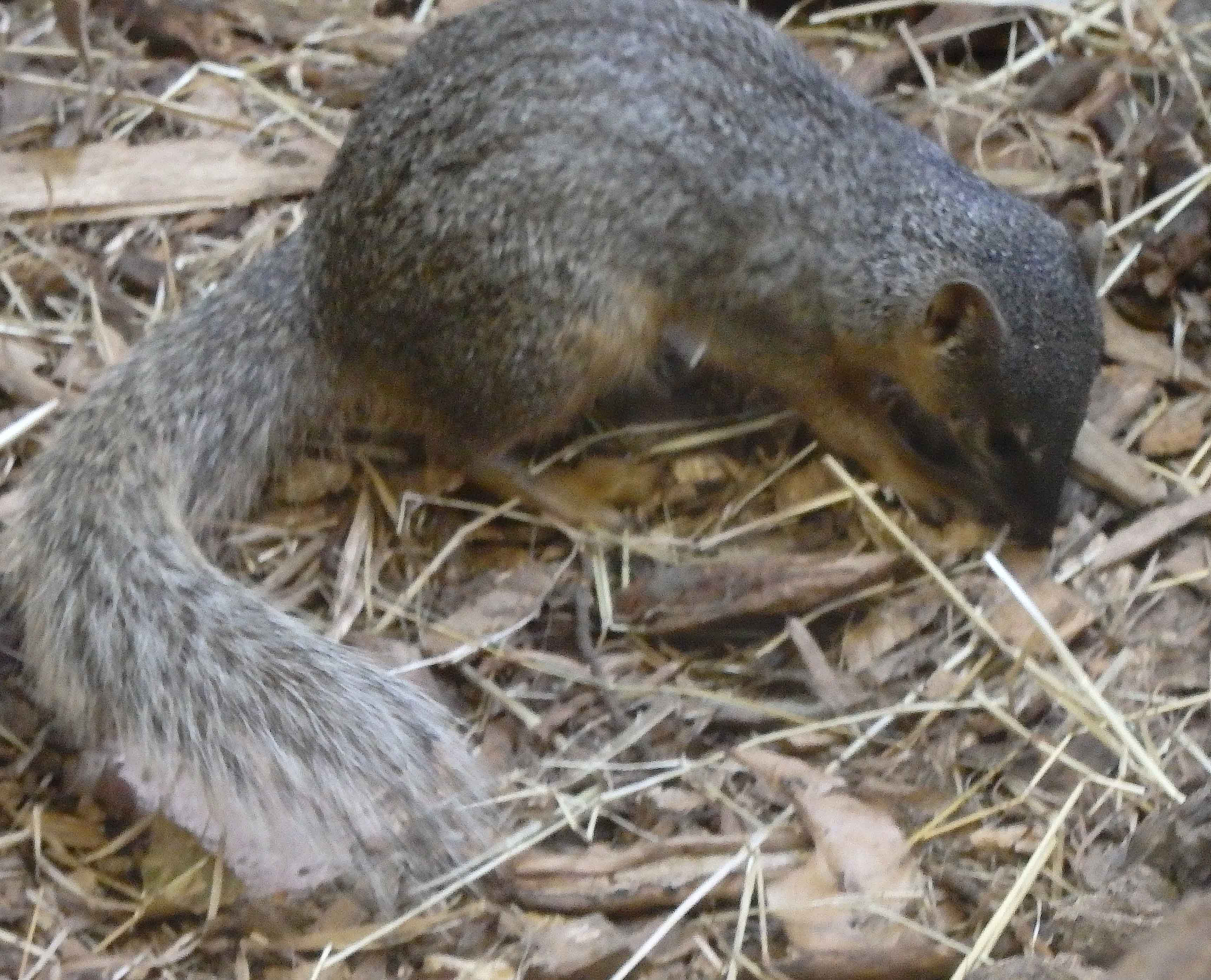
These mongooses are beautiful creatures, one of Gerry Durrell’s ‘little brown jobs’. They have very faint bronze stripes along their speckled brownish-grey bodies and a tail like a mist of grey thistledown, nearly as long as their bodies.
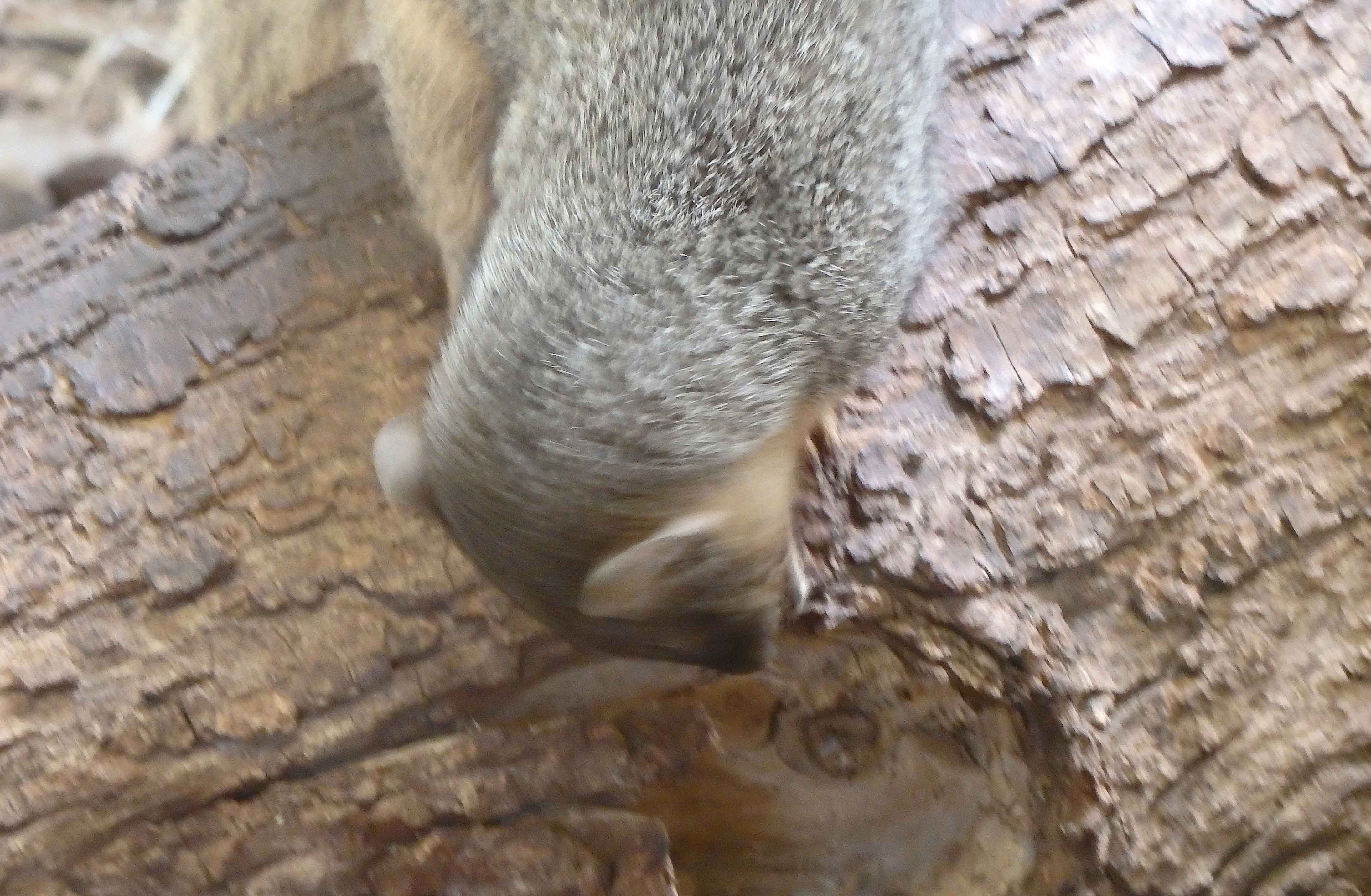
They are coming to grief in the wild as their habitat is lost to logging, so young Hades is very precious.
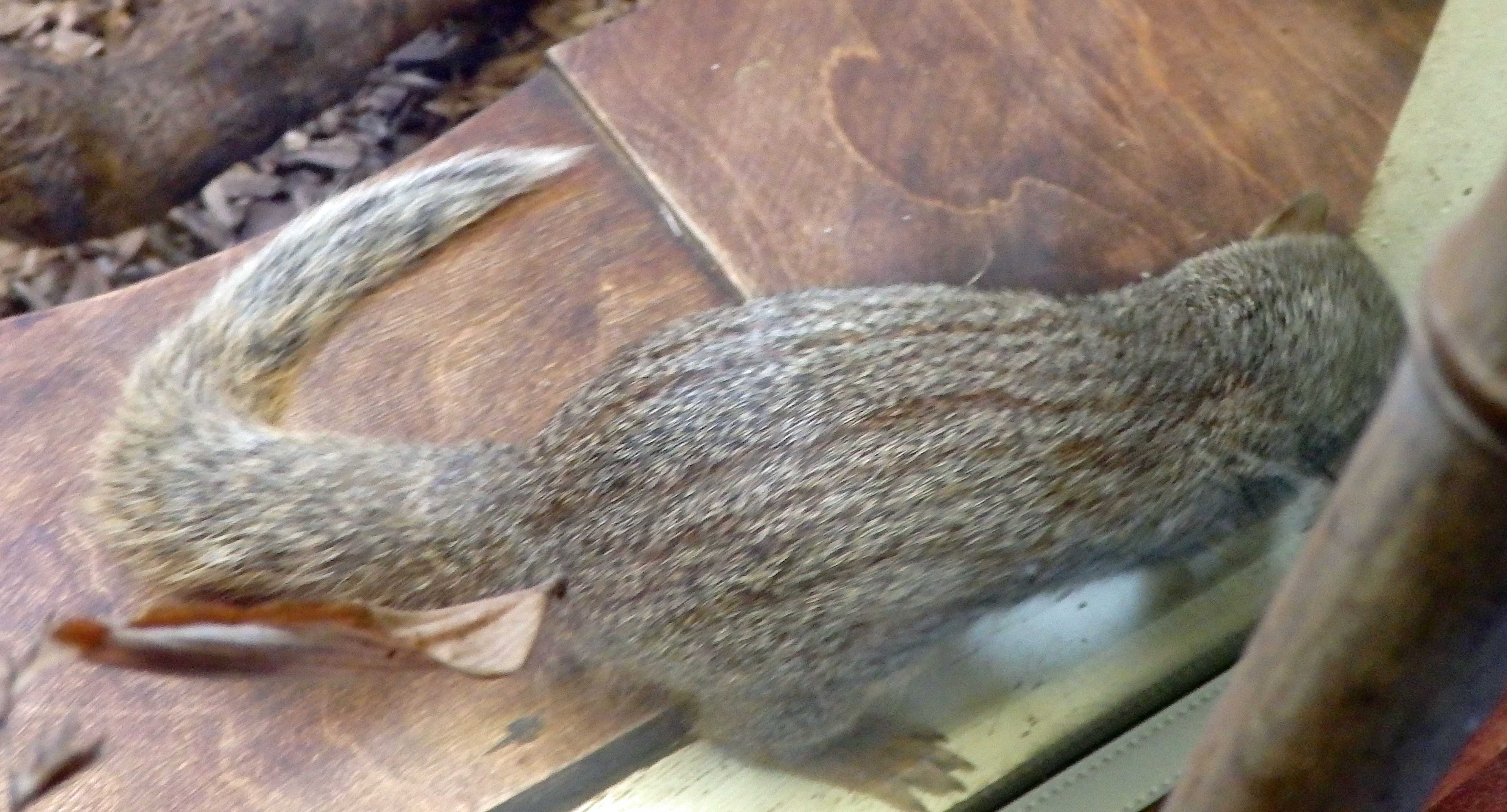
He’s like any youngster, curious about his environment. I watched him dig away at a log with excited persistence until he pulled out what looked like a piece of glass. 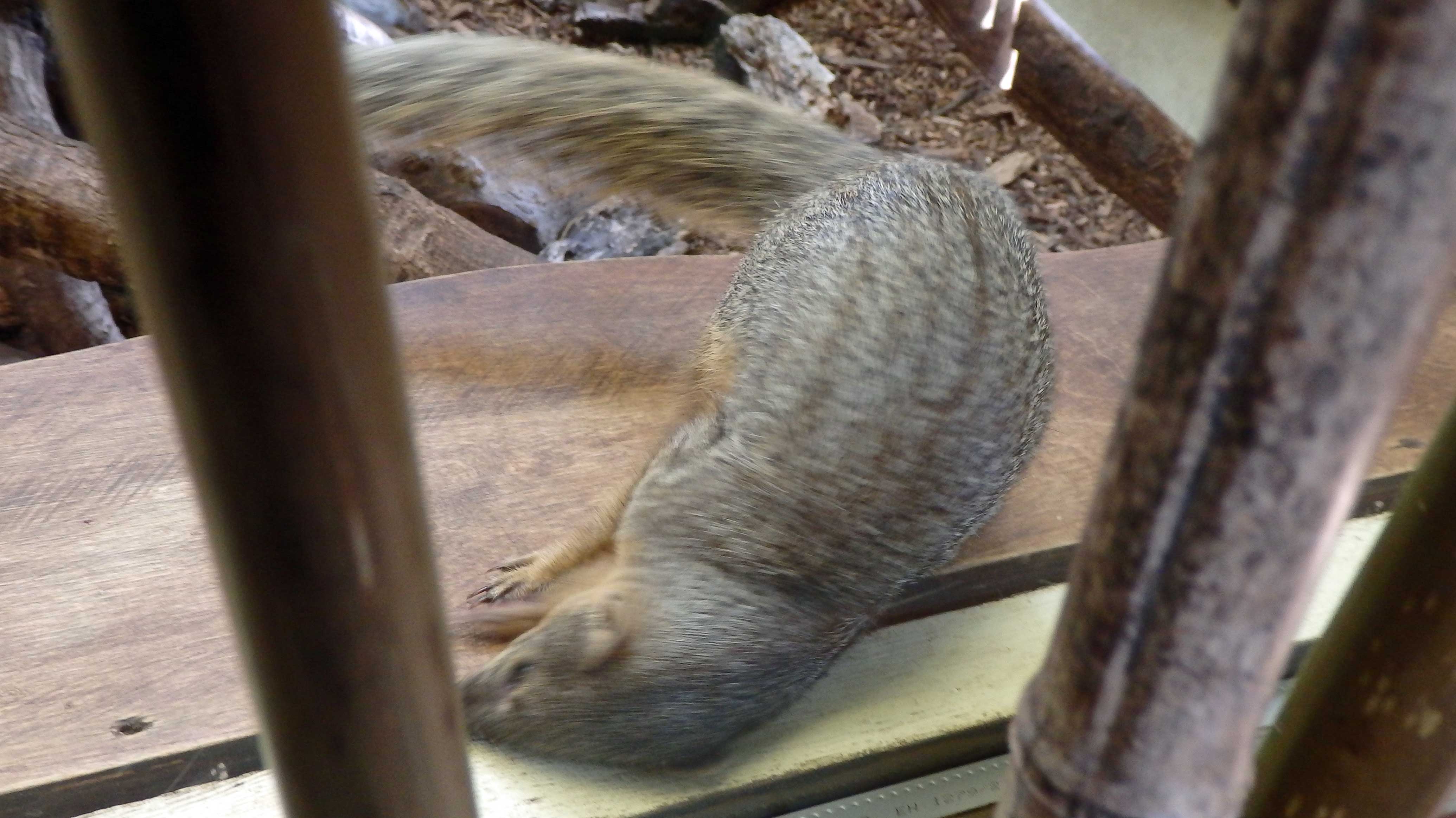 He kept losing it down the crack by the window shelf and fishing it out, and later he took it into his den.
He kept losing it down the crack by the window shelf and fishing it out, and later he took it into his den. 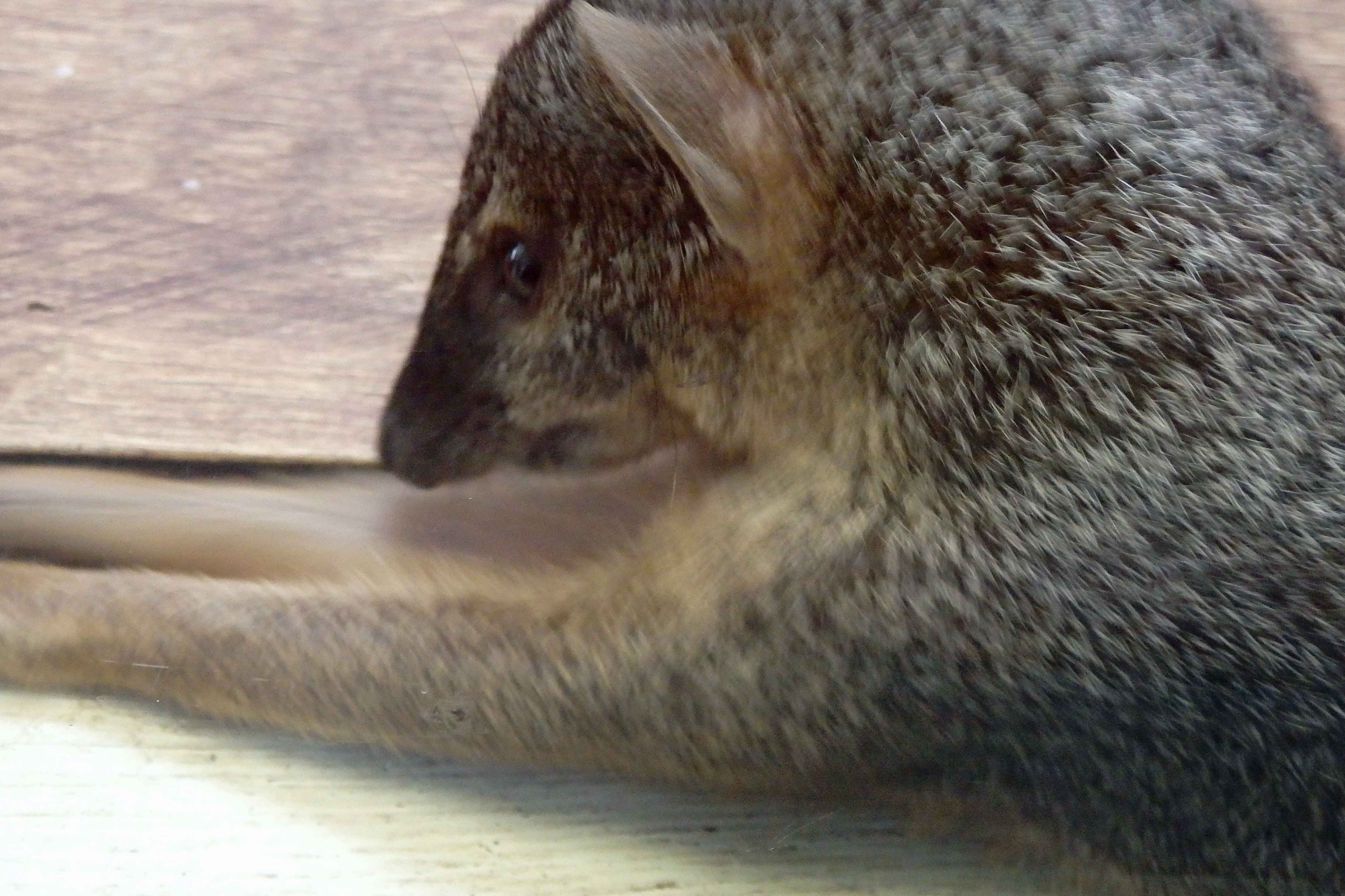 It turned out to be a piece of plastic, but all the tree trunks in the enclosure were going to be checked in case there was more of it.
It turned out to be a piece of plastic, but all the tree trunks in the enclosure were going to be checked in case there was more of it.
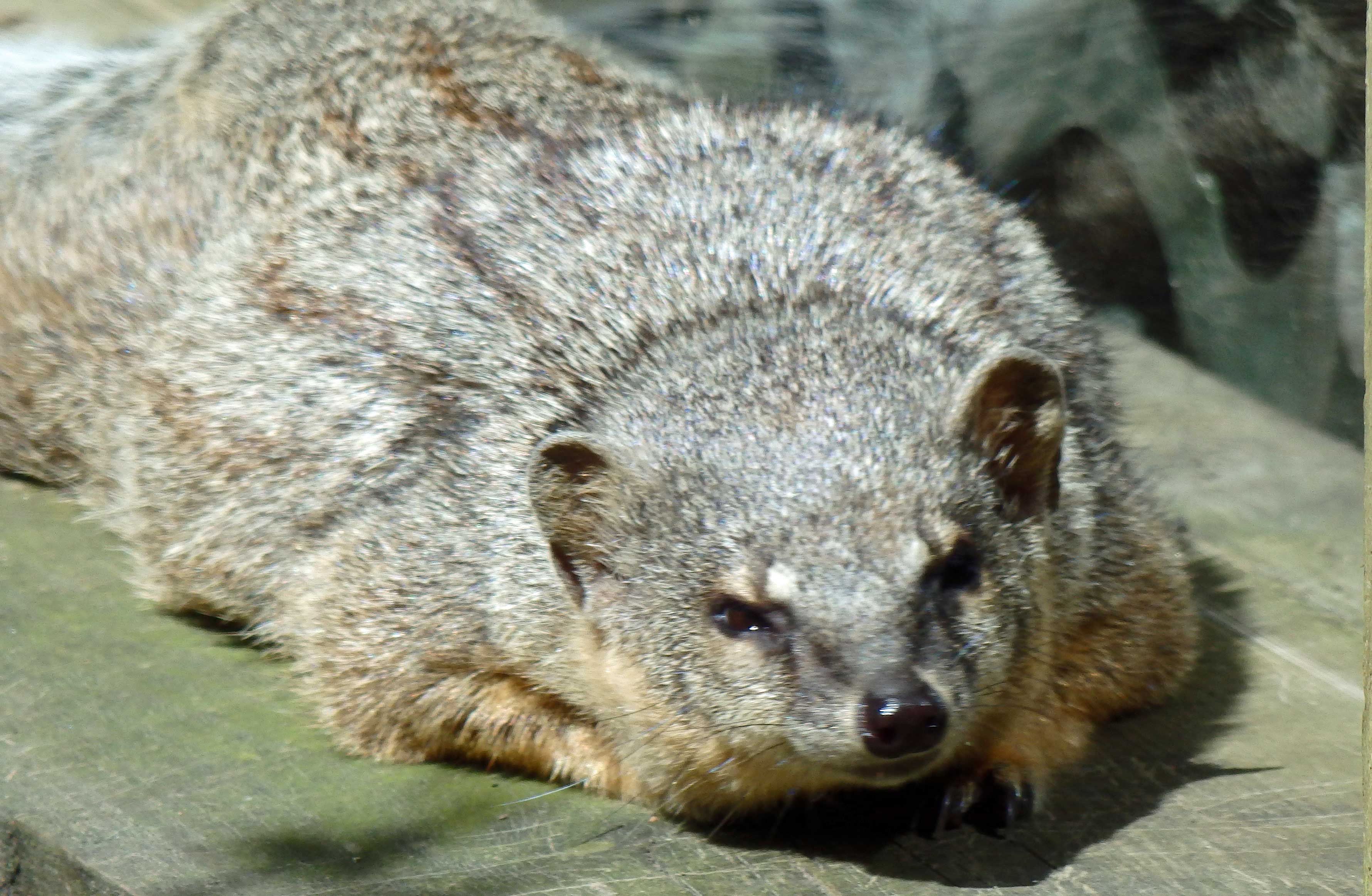
There are four older mongooses, two pairs, including Hades’ mother Jeanette, who’s nine years old. There’s hope that she may breed again with her sixteen-year-old male companion. They and the other pair take it in turns to use the arboreal outdoor enclosure, where they can be seen laying nose to tail in the sun on the windowsill of the indoor enclosure.
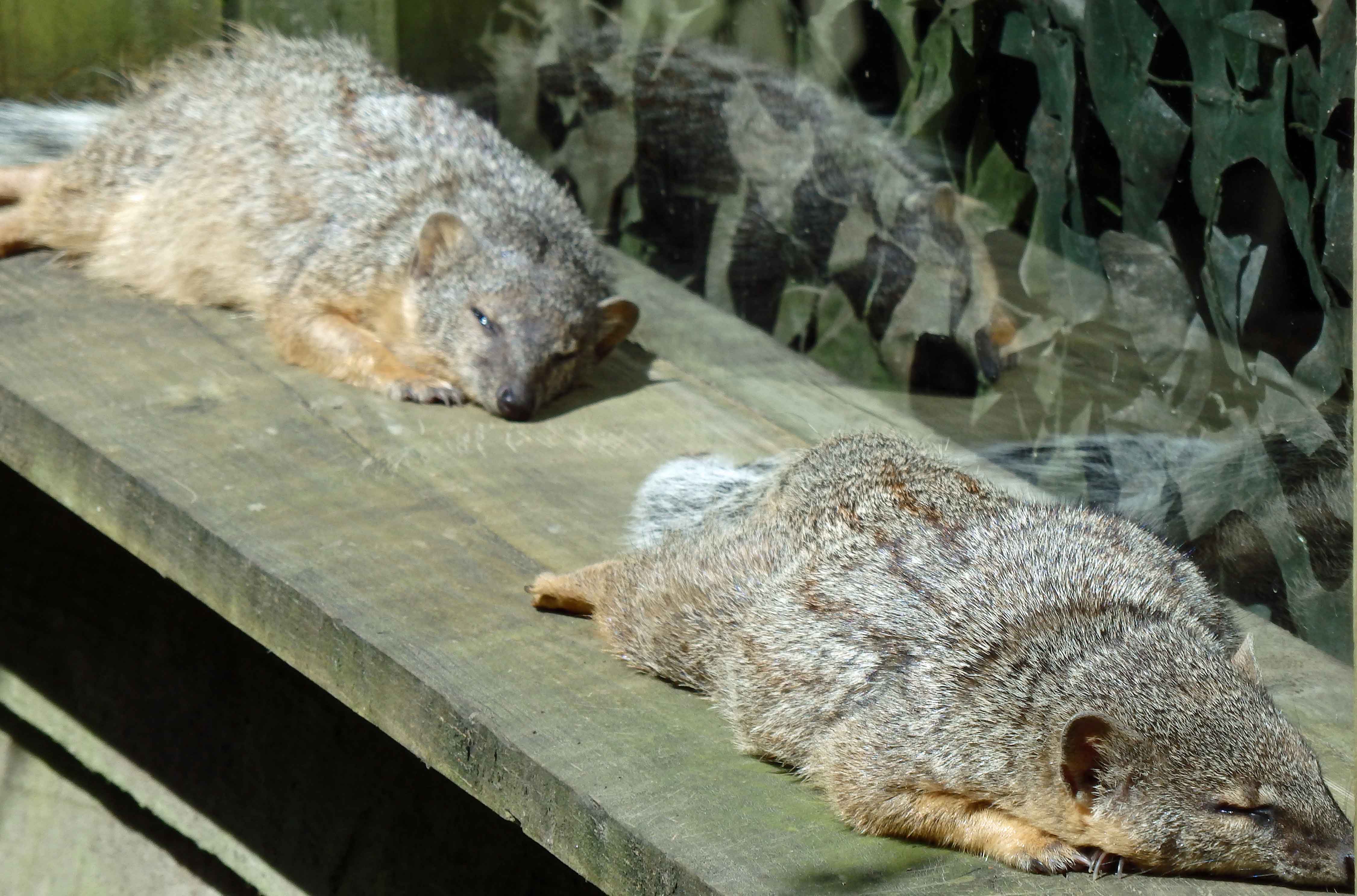
26/27 April 2016
Tortoises
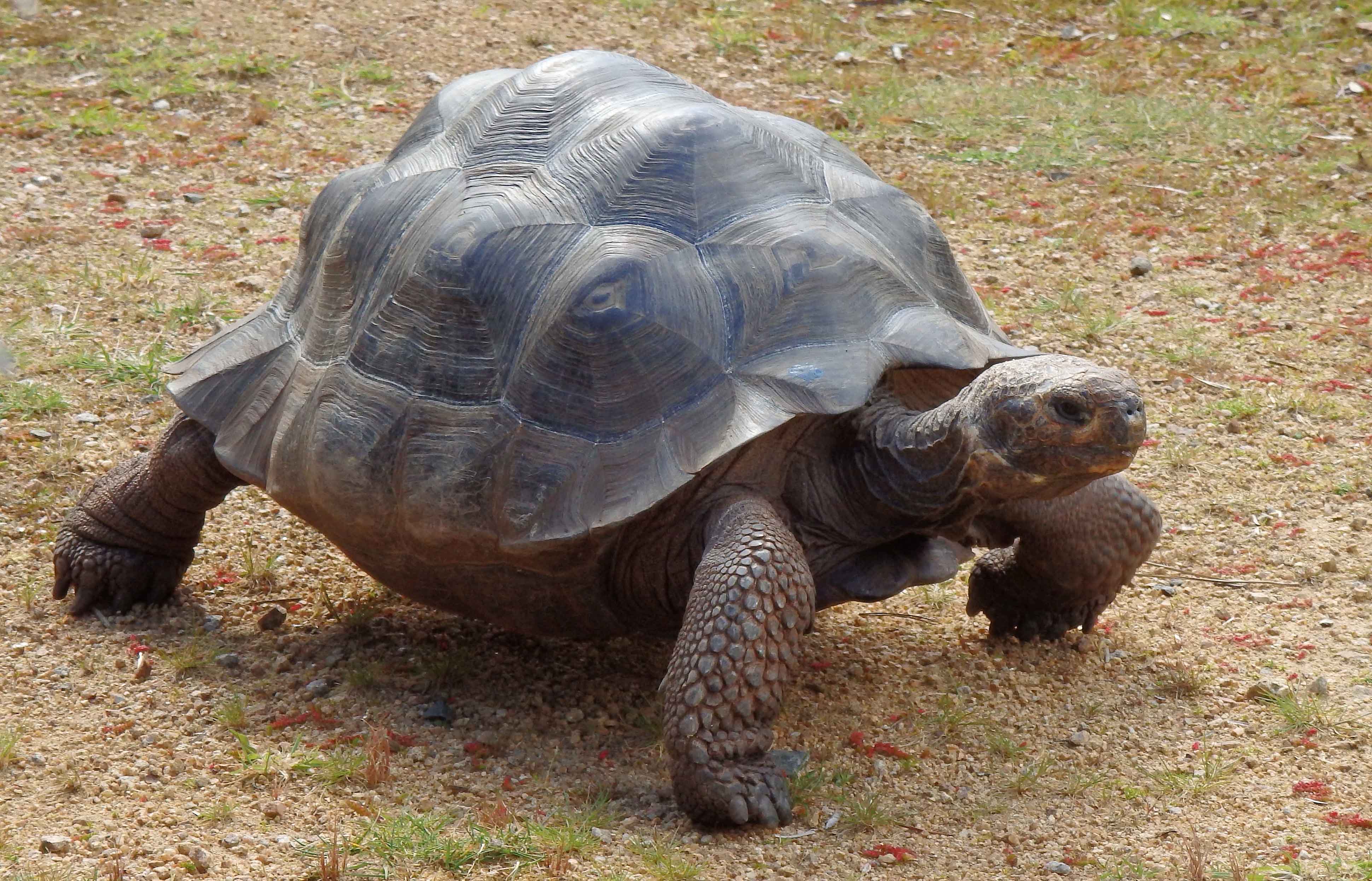
The tortoises were very active in their sunny outdoor enclosures.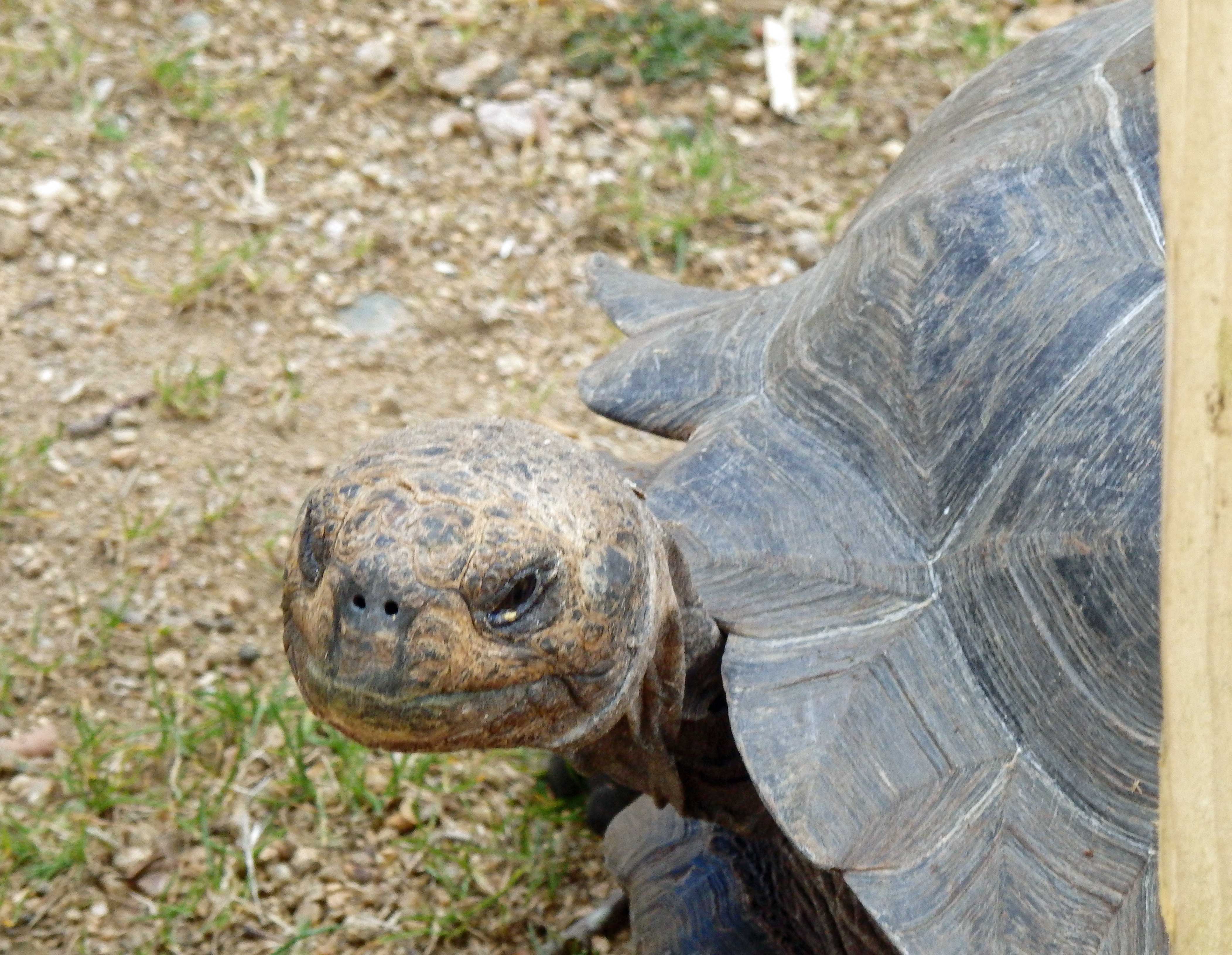 There were giants from Galapagos and their radiated cousins with shells marked with bursts of bright yellow like painted suns.
There were giants from Galapagos and their radiated cousins with shells marked with bursts of bright yellow like painted suns.
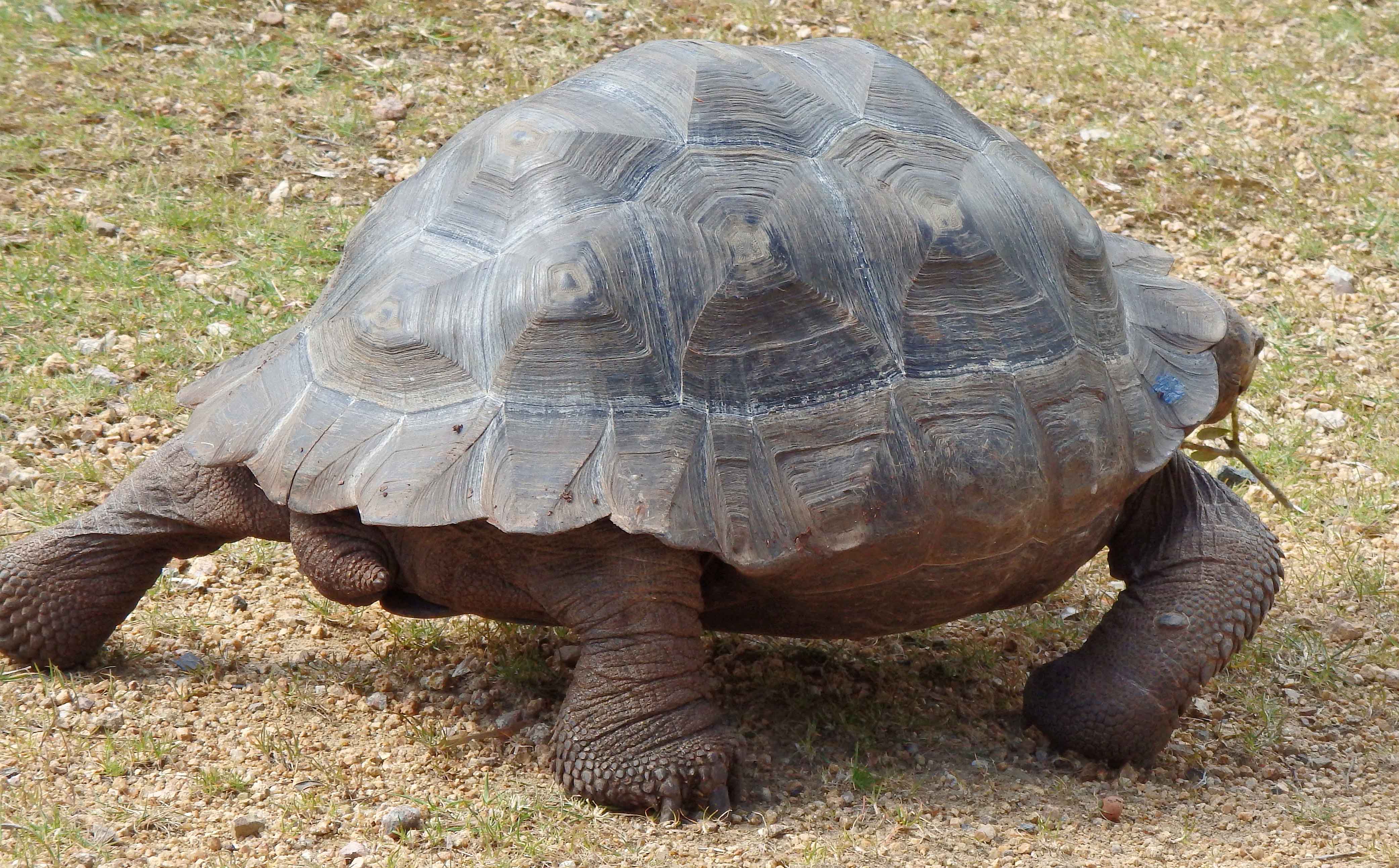
In the same way as the neighbouring adders they seemed to be invigorated by the warmth of the spring day and were moving with more speed and purpose than I’ve seen before.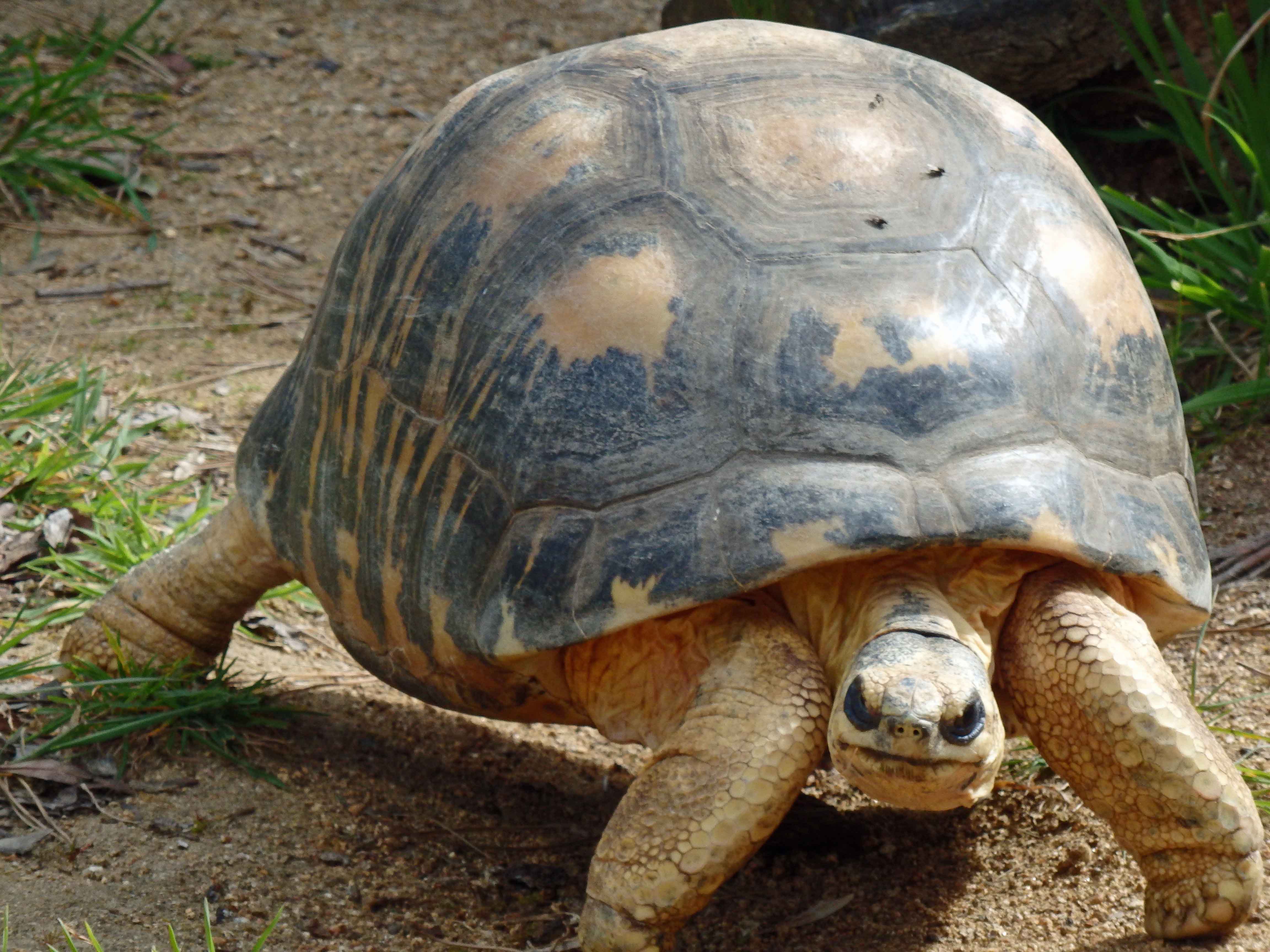 A rapid turn of speed took them on tiptoes around the enclosures, with only an occasional pause to stare at me or sample a stem of leaves. Even the food was taken away to eat on the move.
A rapid turn of speed took them on tiptoes around the enclosures, with only an occasional pause to stare at me or sample a stem of leaves. Even the food was taken away to eat on the move.
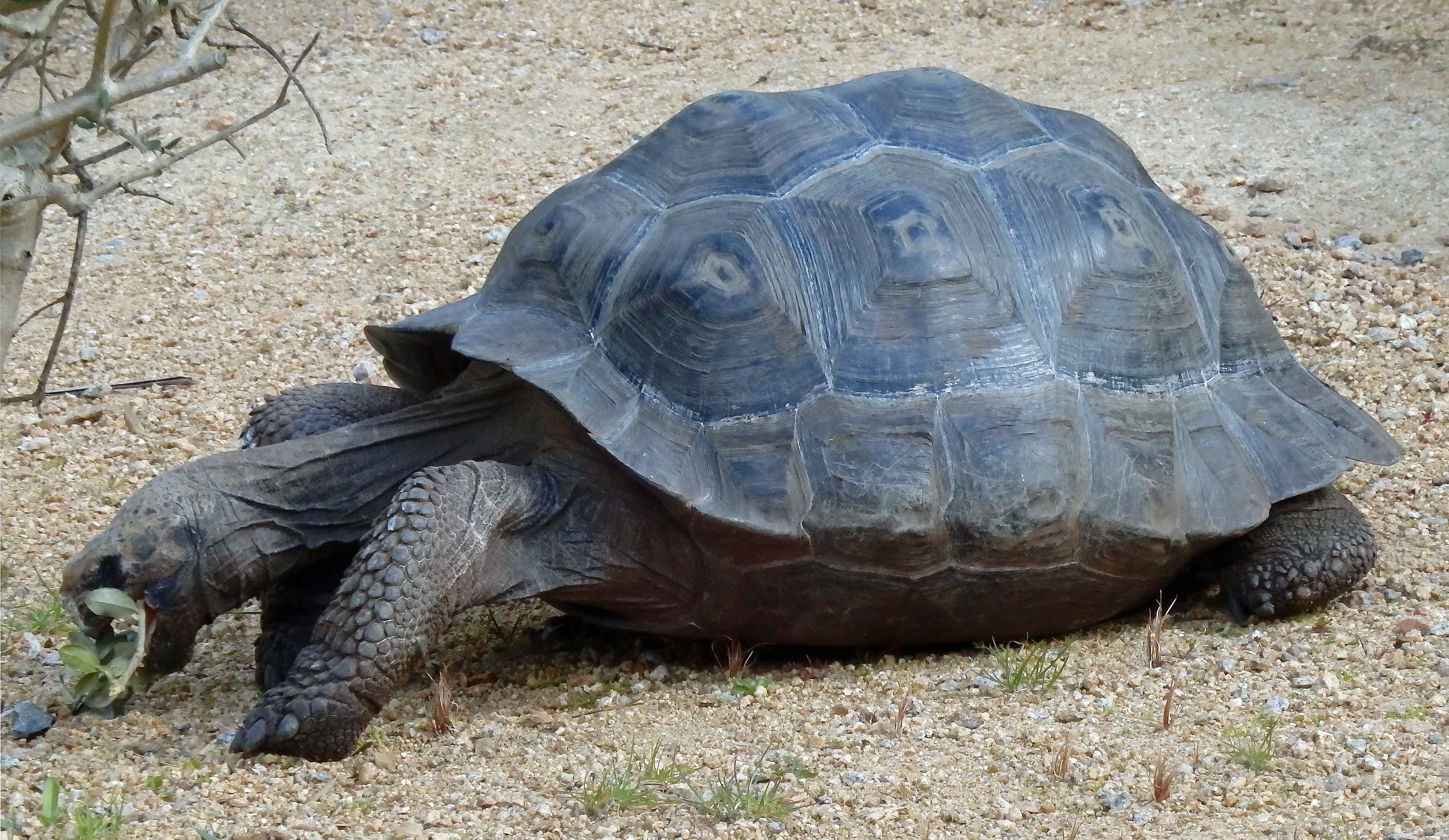
26 April 2017
Aye-Aye
It was as if a pale ghost moved through the dimly lit branches, as Pan the aye-aye flitted through her enclosure, her long feathery tail floating like a shadowy cloud behind her. The whiteness of her ears on her fox-like head was her most distinctive feature, more sparsely furred than her grey body, and her large eyes could see in the gloom so much better than I could at first.
For an instant I thought she was being stalked by a second aye-aye, but it was her shadow, thrown beautifully against the pale wall. She walked equally well along the top of a branch or underneath it, her long fingers curling round it for grip, her tail giving her balance.
Constantly in motion, she went in and out of her den flap, never seeming to settle inside or out, all in total silence. She was intensely interested in the locked hatch into the neighbouring enclosure, sniffing around it from time to time, and trying occasionally to unlatch it.
Otherwise she paused only once, upright on the floor right in front of me, to claw at the bark on a trunk. She was probing it with the distinctive long curved finger which is unique to this nocturnal lemur, searching for grubs, although she’s partial to a sweetcorn treat too
24 April 2016
Gorillas
The gorillas were indoors when I first saw them this time. The silverback has his favourite female in the same part of the spacious quarters, where they have separate nests. His is the leather hammock in the top corner.
The other females are next door and include the mother of the young male, Indigo (Indie). She has one lopsided breast, a result of mastitis after his birth. He’s nearly four now, and she’s weaning him, sometimes pushing him away when he tries to feed. He has his own indoor den for feeding, as his mother takes food from him if she can.
*
The older female in the group has been relegated by the new favourite, but she brought up Indie’s mum, who stands by her in squabbles, unless the male is involved. Later, outside, the male chased the eldest female away from food, which she’d waited for in an isolated spot, knowing the keeper would feed her there. It was the new favourite who spotted her there and came over, followed by the male.
The older female ran off, but she knows where to find all the feeding spots and sometimes gets to one and waits for the keeper there before the dominant female arrives.
*
A film crew were trying to install cameras around the outdoor enclosure. The silverback didn’t like the cameras, and could throw food or a lump of earth or wood to knock them down, so the technicians were trying to mount them on poles hidden in bamboo stands around the perimeter.
26 April 2016
Lemurs
3 Tails and food
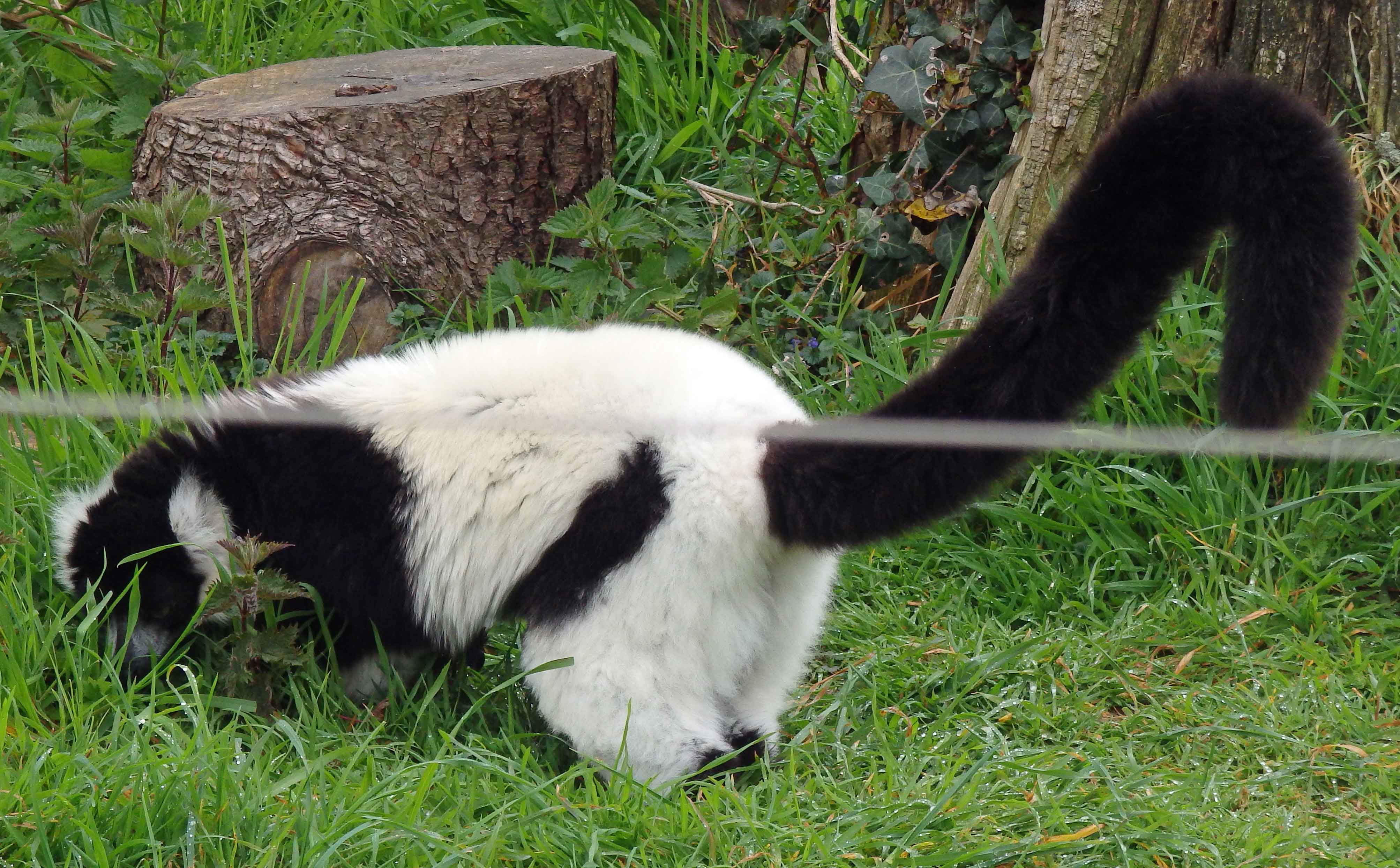
Both the black and white ruffed and the ring-tailed lemurs distinctively walk along paths in a line with their tails raised in curling question marks, as they patrol their wooded lake-side habitat. When the black and whites raise their very thick black tails their bodies, seemingly plump and bulky, suddenly become much slimmer and their faces more pointed and distinctively lemur-like.
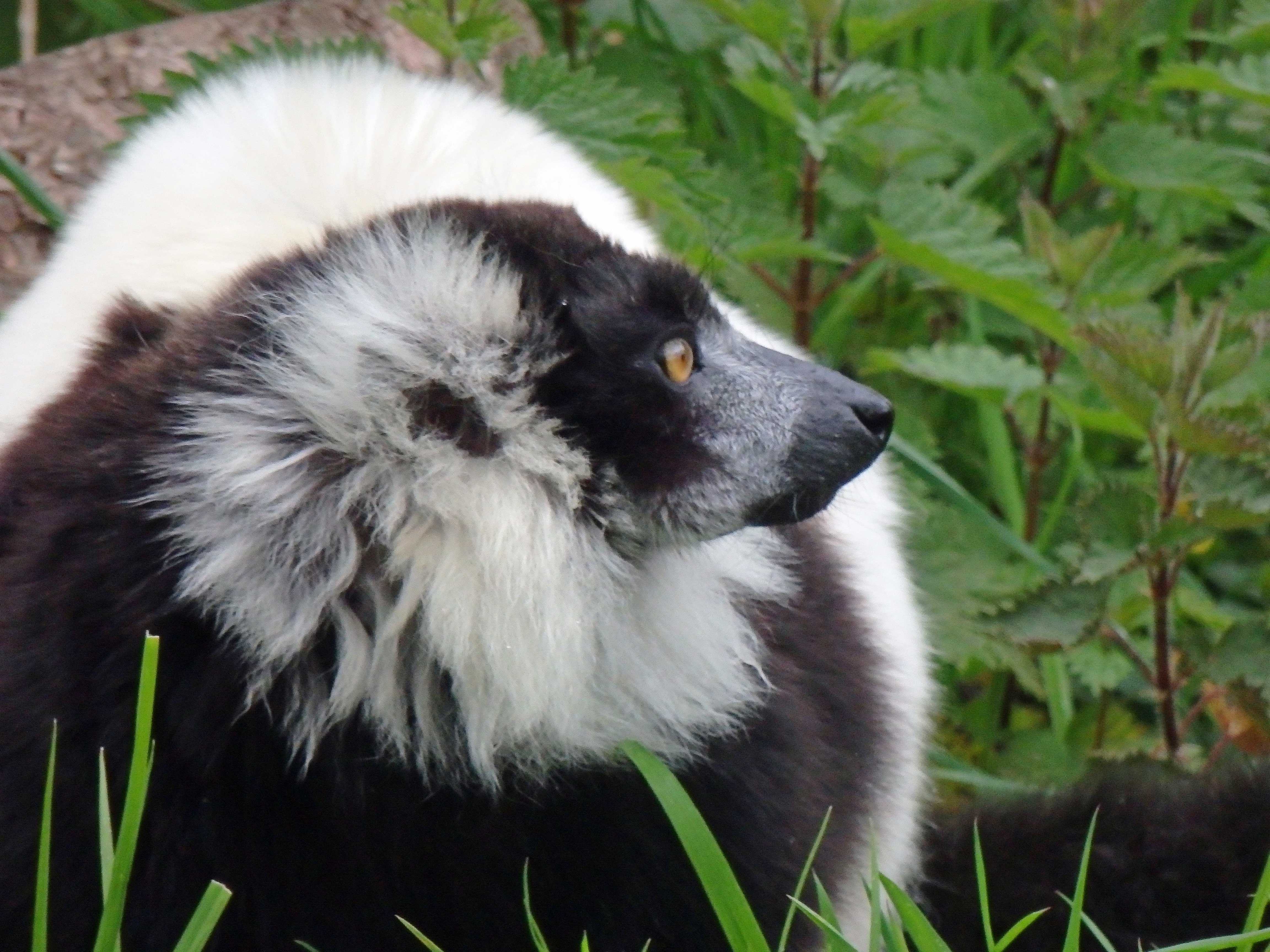
The black and whites are surprisingly agile given their size and shape – there was one in the open branches right at the top of a slender tree. A second was also at the top of another tree, perched in a nest-like jumble of branches. Both were making loud squabbling sounds.
Below the group of ring-tailed lemurs appeared in a line, one by one. They approached their indoor enclosure in a leisurely fashion, their tails curved into those question marks and seeming to float independently over the grass. One went up a tree, again to the very top, to nibble at leaf shoots, but the others stayed on the ground, either grazing or going into indoors.
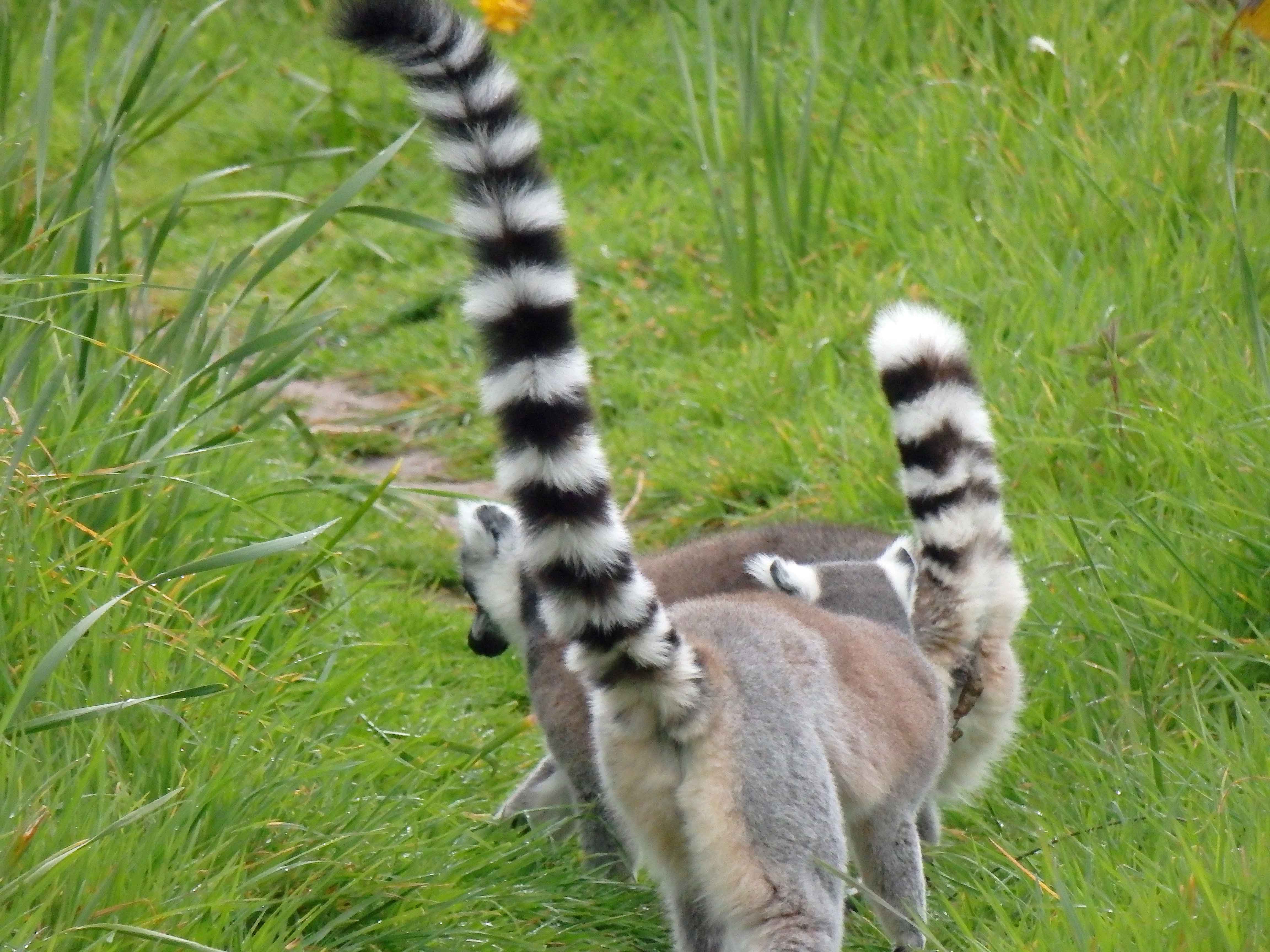
There are only two black and whites here, but they intimidate the ring-tailed, who always move away when threatened. Two of the ring-tailed lemurs have previously lost half their tails in fights elsewhere with black and whites, which may have made them wary.
But when the black and whites make their loud territorial calls, they are instantly backed up a screaming cacophony from the ring-tailed in the enclosure, as well as the red-ruffed lemurs from the territory on the far side of the lake.
*
The gentle lemurs are much smaller and quieter and inconspicuous with their brown fur. They live living in an enclosure below the others, one full of hawthorn and willow shrubs. Shoots from these are cut to feed the lemur groups, as well as to clear more space for the new inhabitants – a resident female who is about to meet the male who has just finished his quarantine period.
Willow goes to the resident gentle lemurs and to the red-ruffed lemurs up by the lake, who have it threaded through the ropeways of their enclosure to encourage them to climb and forage.
Hawthorn was for the black and whites and ring-tailed lemurs, who have them tucked into the crevices around tree stumps. The ring-tailed finish eating, and sit in the sun, turning their white-furred tummies towards the heat.
24 April 2016
Bats
2 Finding mum
A baby Rodrigues bat was searching for her mother, approaching every nearby bat, and being brushed off, until at last she found her parent and was wrapped up tight, like the contents of a parcel – her own tiny wings clasped her mother’s body, and her mother’s wings completely enfolded her. Only the four feet hanging from the rope betrayed her presence – two adult ones, two baby ones.
Two other bats flew up separately to hang together from the roof. Their movements across the netted roof were neat and fast. One clawed fingertip reached out, followed by the one on the other side, wings were spread out like an opening umbrella, then the body swung round to hang upright for a quick pee before upending to hang from the feet, wrapping wings round the body for a quiet nap.
There was some work being done nearby, drilling for electric cables for a film crew. Some of the bats were disturbed by this, a baby flew away, followed by his mother and a couple of neighbours. The remainder rustled uneasily and spread their wings ready for flight, but then refolded them and stayed where they were, alert for any further disturbance. Their heads projected from their wings, their bright brown little eyes were open, their ears pricked in a distinctive outline against the sky.
25 April 2016
Orangutans
7 Jantho
Jiwa, the young male with development difficulties, has found a place in the orangutan group, chiefly as playmate, guardian and mentor to the male baby Jantho. Jantho’s mother, Annette, tolerates Jiwa’s time with her son, although she moves away herself if Jiwa comes too close. The other orangutan mother, Dana, doesn’t like him near her or her baby Kea, of whom she is very protective.
Jiwa was out on one of the islands playing with Jantho when I first arrived, while Annette was having some personal time alone on the other island. The boys rolled around, clung together, pulled apart, getting thoroughly coated with sawdust. Jantho was very lively, hiding in a sack, rolling around in it, peering out, emerging and dragging it behind him over the floor and up the ropes. One of my favourite moments was the sight of him rolling sideways or head over heels, completely enveloped in his sack. Eventually he went to join his mother, who was by then sharing her island with the two gibbons who live here.
Later, Jantho and Jiwa were playing together indoors until Jantho went outside on his own. Jiwa didn’t follow him immediately, so mother Annette came bounding over to glare indignantly across the bridge at her babysitter. She’d been having a peaceful break, snacking delicately, and now she was unexpectedly on duty again, following Jantho around, appropriating his sack and generally supervising him until Jiwa appeared to take over again.
Jiwa demonstrated three different ways to descend a rope. Jantho watched him closely and copied his actions. He learns from, and pesters, Jiwa, for a little later I saw the pair, partially screened by bushes, as Jantho practised with a tiny erection on a patient Jiwa. Jiwa soon grew bored and wandered off, so Annette came again to watch over her baby.
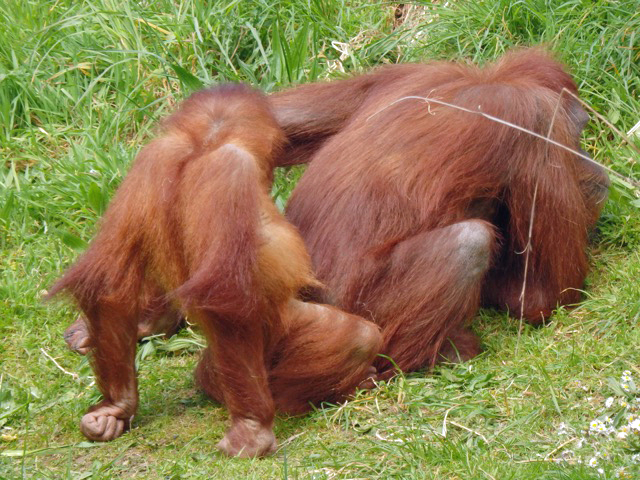
Although Jantho doesn’t spend as much time with his mother as Kea does, he is still often in company with Annette and imitates her too. They frequently come to sit on the weighing machine by the window in one of the indoor enclosures, eating their food and watching passersby. Food was the paramount interest and so they occasionally went to hoover the floor in search of more titbits. They moved over it on hands and feet, heads bent to the ground, sniffing and sucking, and inadvertently sweeping the sawdust on the floor with them.
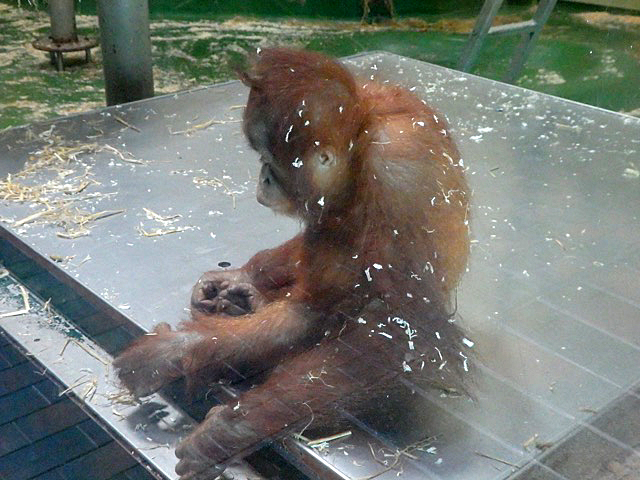
Annette frequently vomited, and Jantho came to help her daintily pick through the mess and scoop it up to swallow again. This happened three times, and the keeper said it was a deliberate action, one that gorillas do too. More appealingly, Annette fished with a straw for termites in a log, and Jantho came to imitate her so she passed her straw to him. He already knows how to pick through the greens that he had taken up to their nest and choose his favourites, but he was easily distracted last thing in the evening by the proffered drink from the kitchen door. Annette took over the greens, clearly not expecting extra food supplies herself.
24-28 April 2016
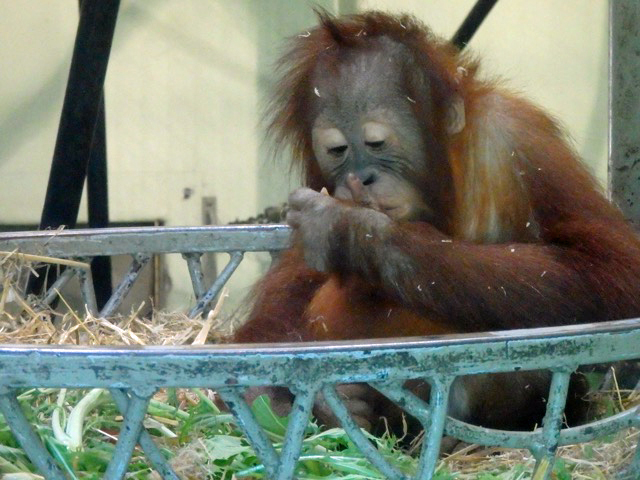
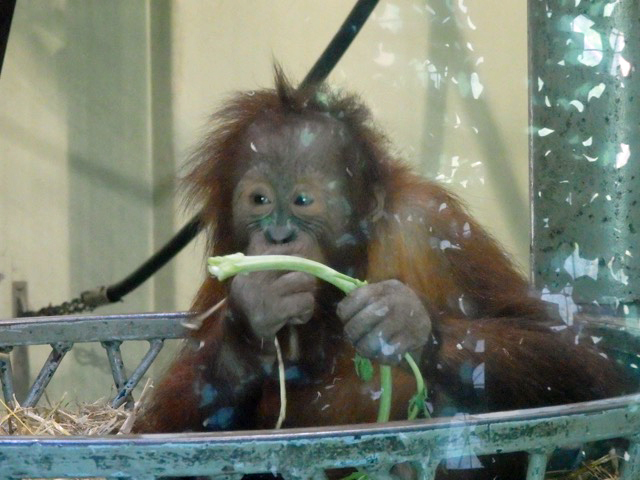
8 Youngsters steal the scene
The orangutangs like to make eye contact through the glass of their enclosure. Annette and her young son Jantho came to look at me, and Jantho put his hand on the glass above mine. Next door, Dana had released her baby Kea, who came to the window, responding to a visitor’s tapping by copying him and holding out her hand to touch the glass where his was.
Jantho had grown bored with the game and wandered away, but came over again when he saw Kea in action. He sat right in front of a small boy, holding out his apple piece temptingly, knowing it couldn’t be reached. He moved on to more mischief, hiding behind a pillar to reach through the wire and filch some of Dana’s food. Dana spotted this, and reached her hand through from the other side, fingers spread out to retrieve the food.
Dana and her baby Kea
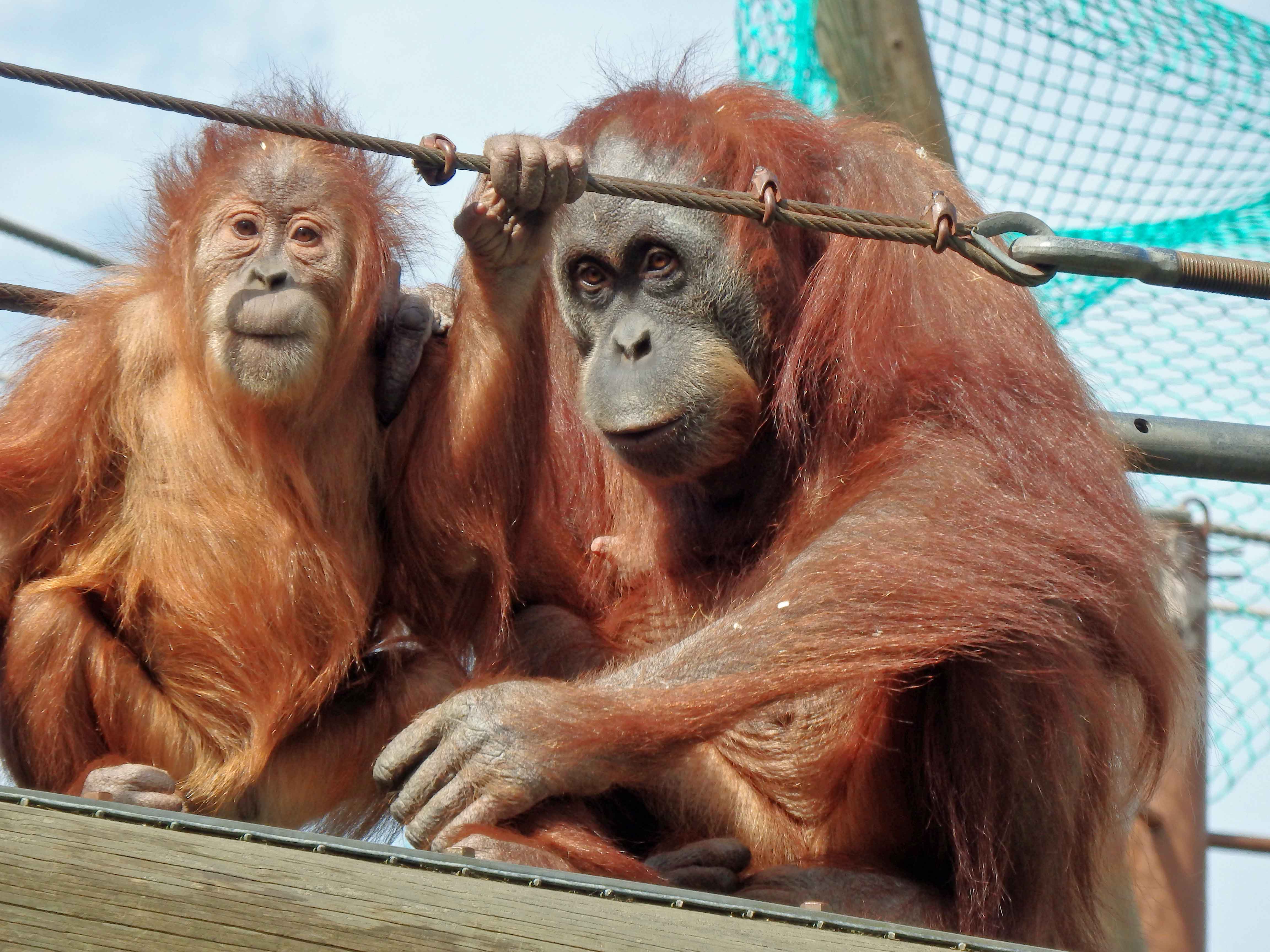 share their enclosure with Dagu, the dominant adult male.
share their enclosure with Dagu, the dominant adult male.
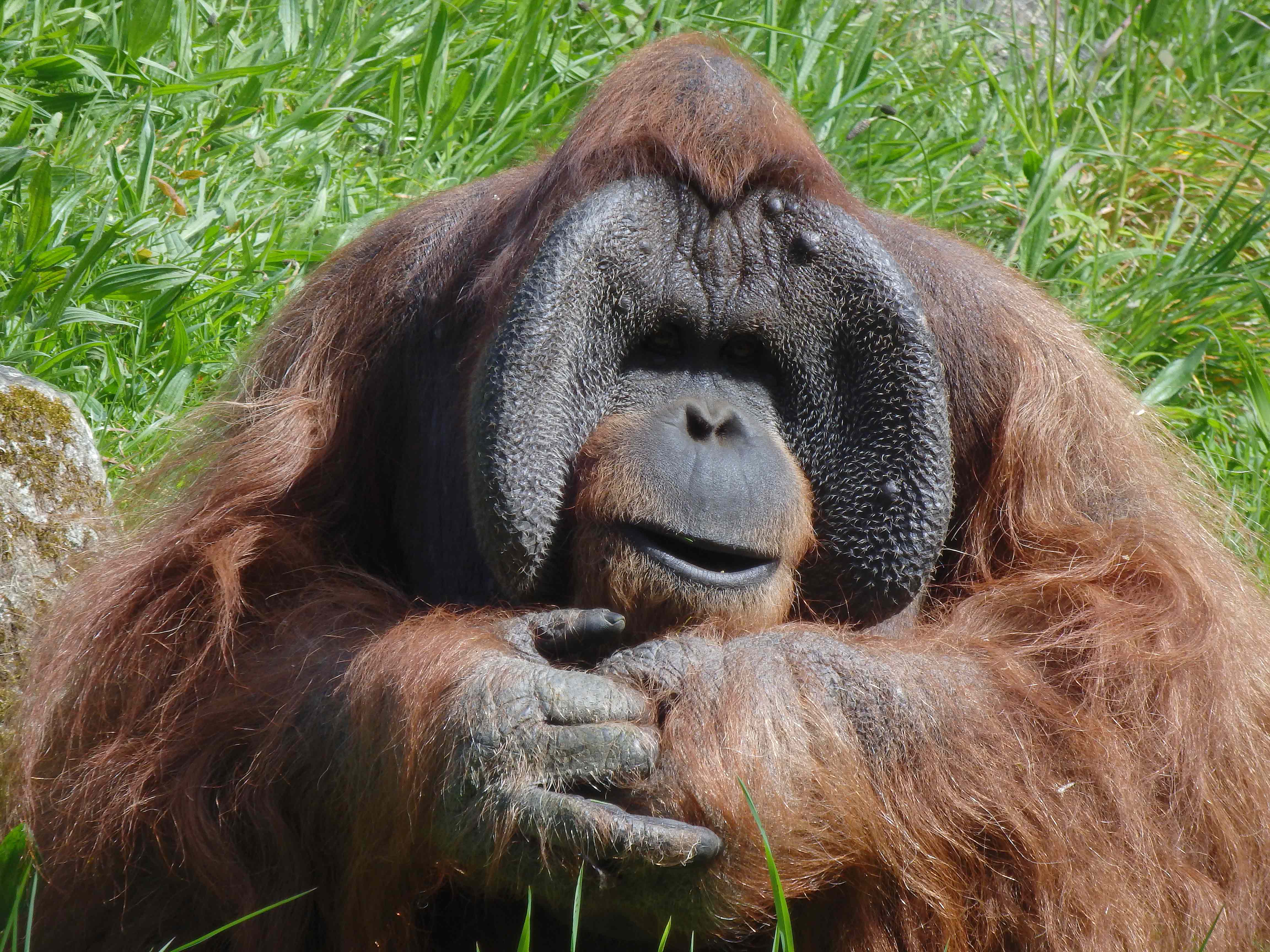
Dana still doesn’t allow her precious youngster to roam far from her. She keeps a firm grip around one of Kea’s wrists or ankles, like a manacle,
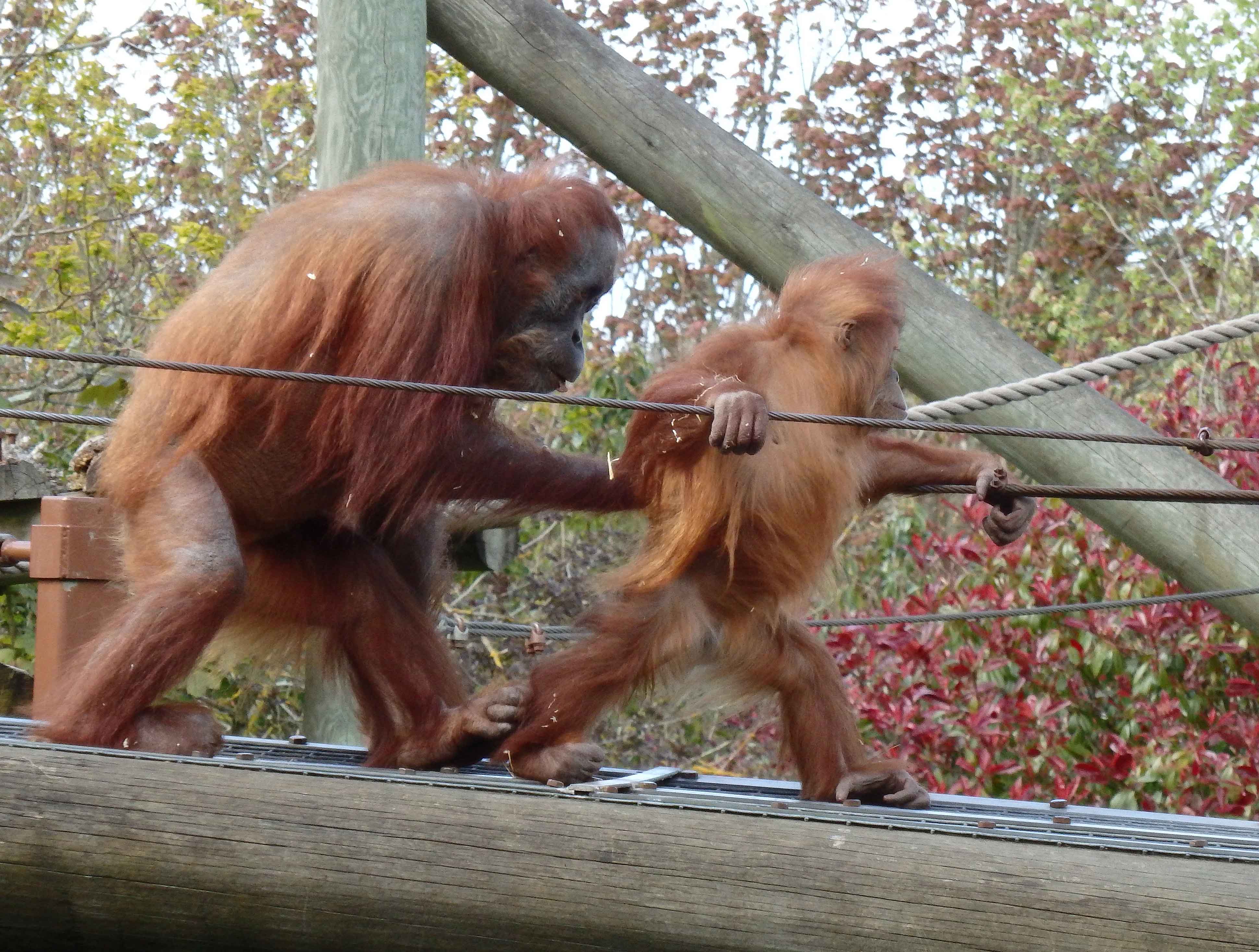
even when they were both enclosed in a sack, that Dana had anchored to an upper rope to use it like a hammock.
She used the sack in many ways, frequently to partially conceal herself and her closely held baby, in a composition rather like an orangutan Madonna and child.
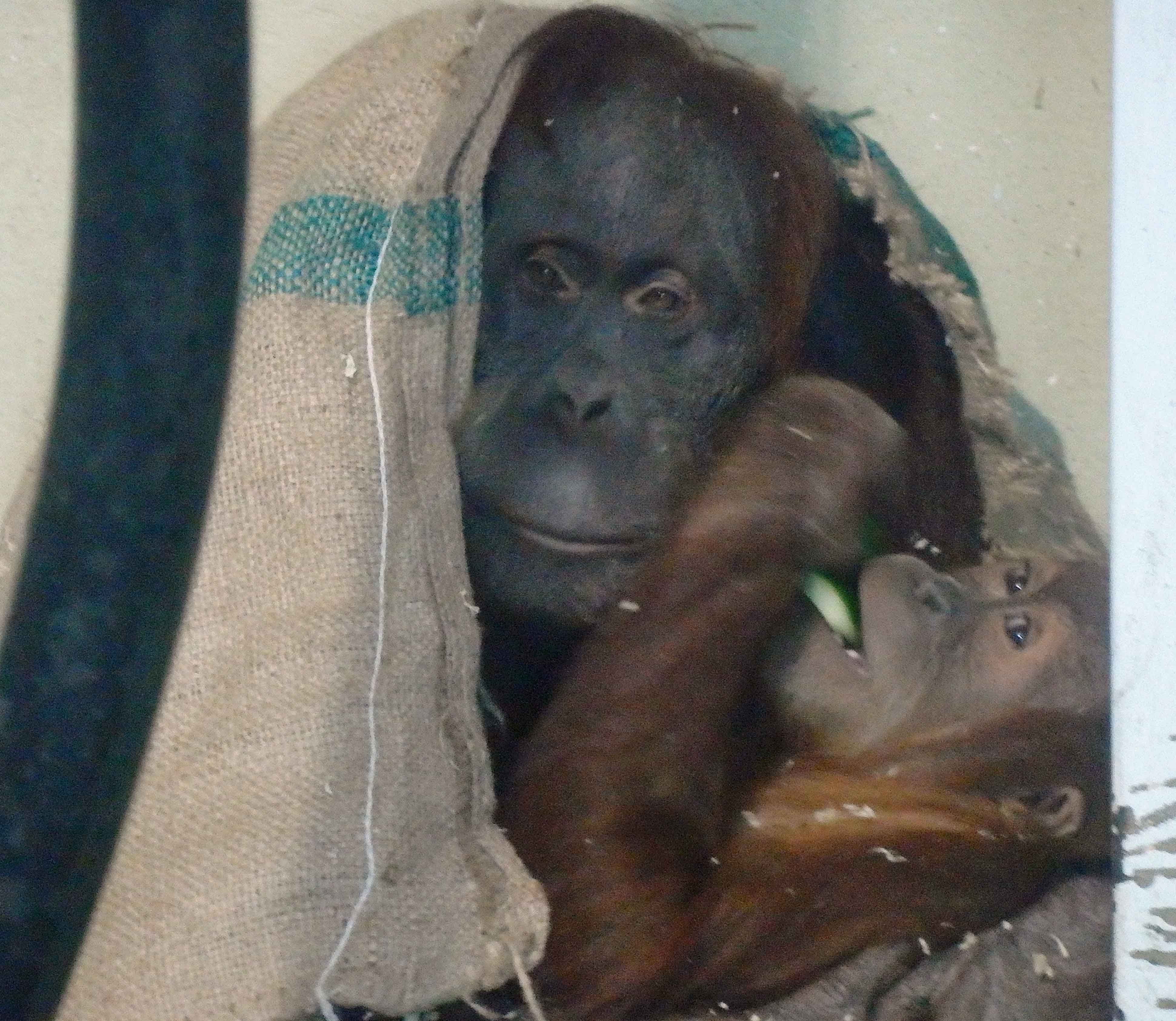
Towards the evening Kea was playing freely, but close to Dana, who was gathering the sack and a heap of shredded paper from the bottom nest, and taking it to the very top one. Here she piled it carefully in a heap, held it in one hand and laid it out neatly.
By the time bedtime came, Dana was laying down on a platform, wrapped in a sack, looking just like an old woman huddled in a cloak. She always seems much wearier than Annette, the other orangutan mother, perhaps as a result of her constant vigilance. But to see her, so loving to her precious hard-come-by child, is a very moving sight.
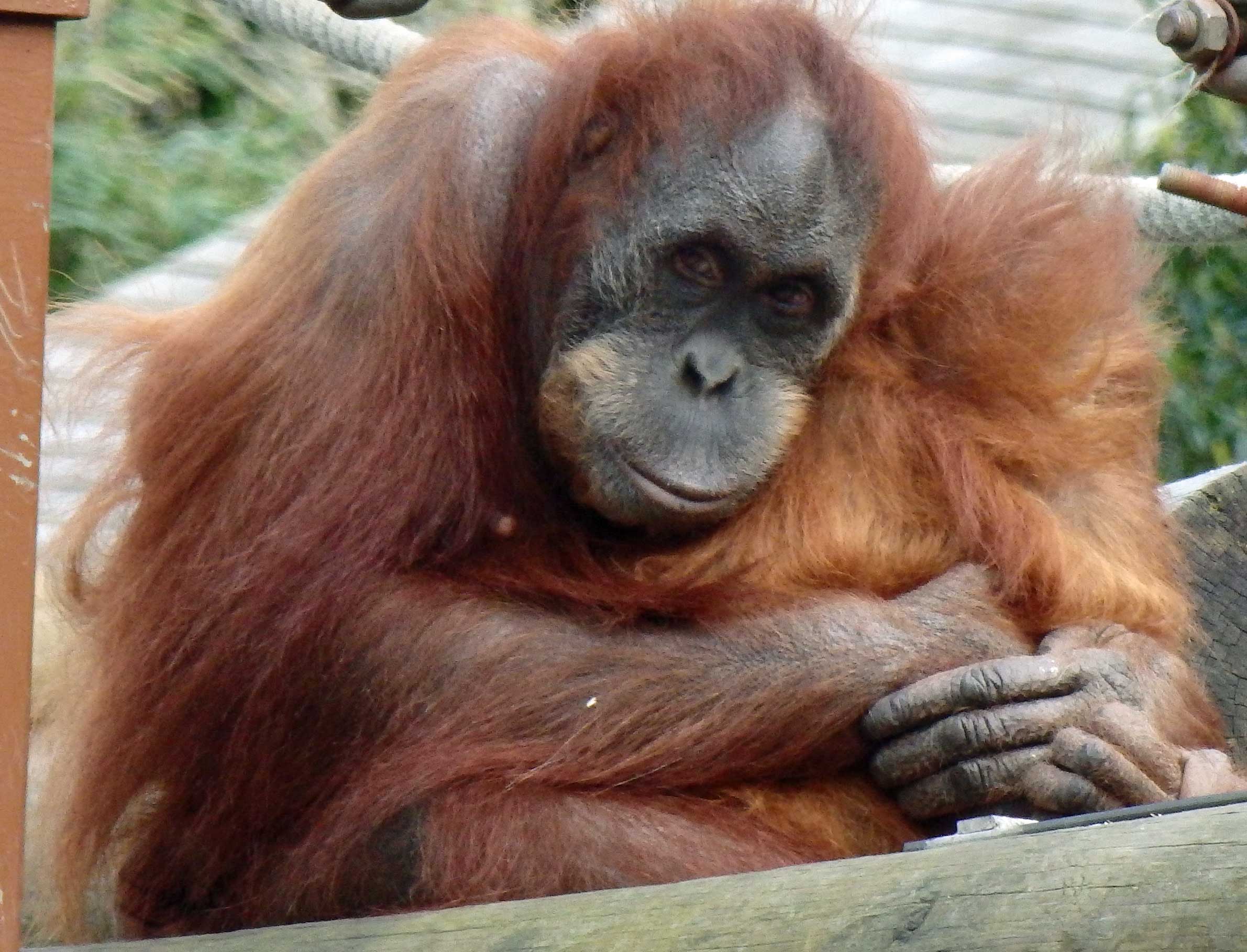
Annette and Jantho do spend quality time together too, often curled up in one of their indoor nests. As soon as they went outside one morning when I was there, they were shut out for their quarters to be cleaned. They huddled together, looking miserable, clearly not happy with the exclusion.
None of the orangutans like to be shut out, and Dana sat at the far end of the outside bridge, clutching Kea tightly to her under a sheltering sack and doing a little necessary maternal nit-picking until the door was open.
Dagu came back in as soon as his own quarters were clean and sat by the main screen, his small amber eyes fixed on a pair of children. He stayed there for some time, before sweeping away, wearing sawdust flecks like random jewels in his shaggy fur.
24-28 April 2016
Birds
Nesting jewels
In the Jewels of the Forest bird enclosure a Nicobar pigeon perched on a high branch beside the bridge. Most of the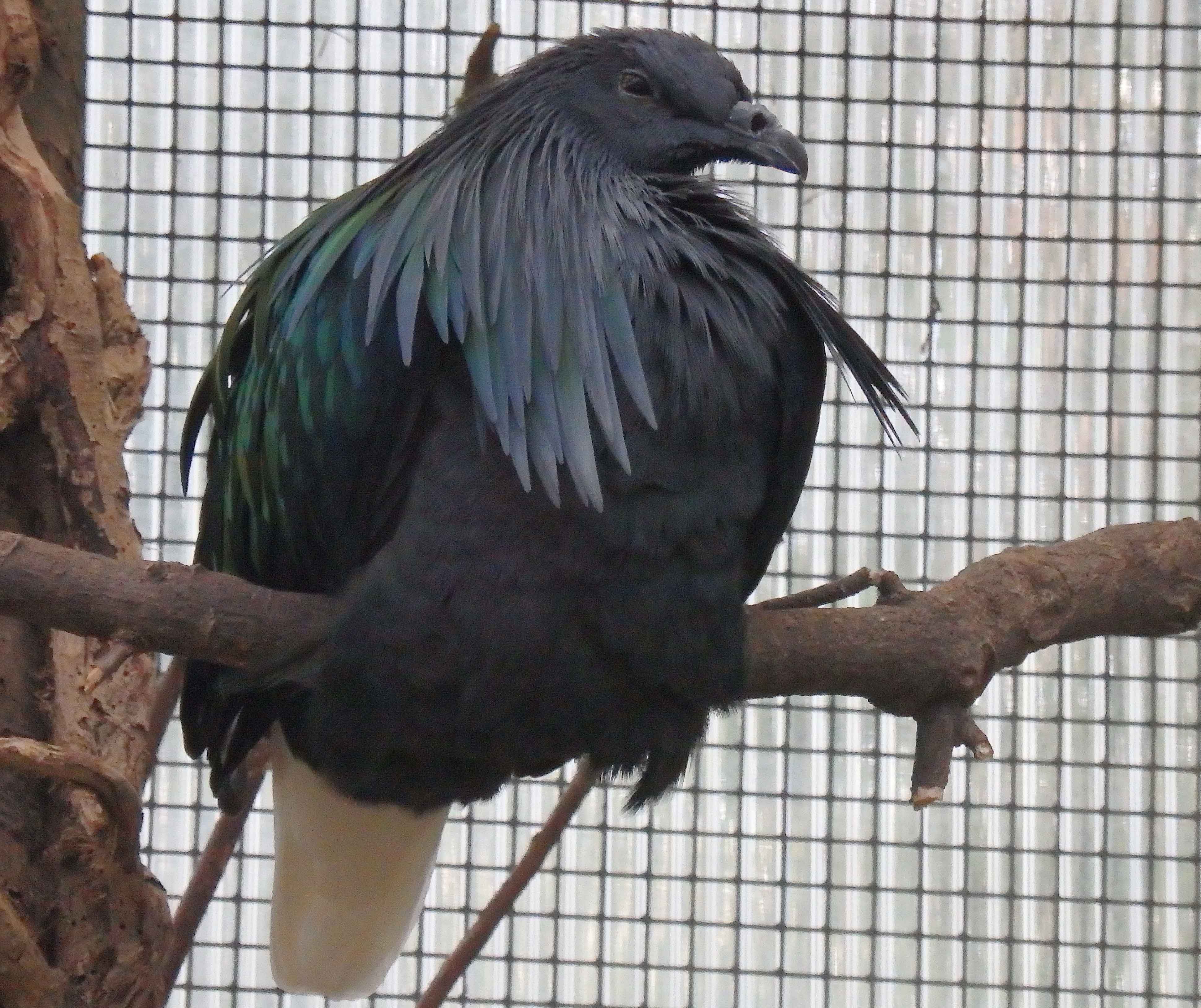 activity was here, at the head of the dried stream. A fairy bluebird flew past, a shama sat on a low trunk, two chestnut-backed laughing thrushes were rooting in a bamboo thicket and a Pekin robin
activity was here, at the head of the dried stream. A fairy bluebird flew past, a shama sat on a low trunk, two chestnut-backed laughing thrushes were rooting in a bamboo thicket and a Pekin robin 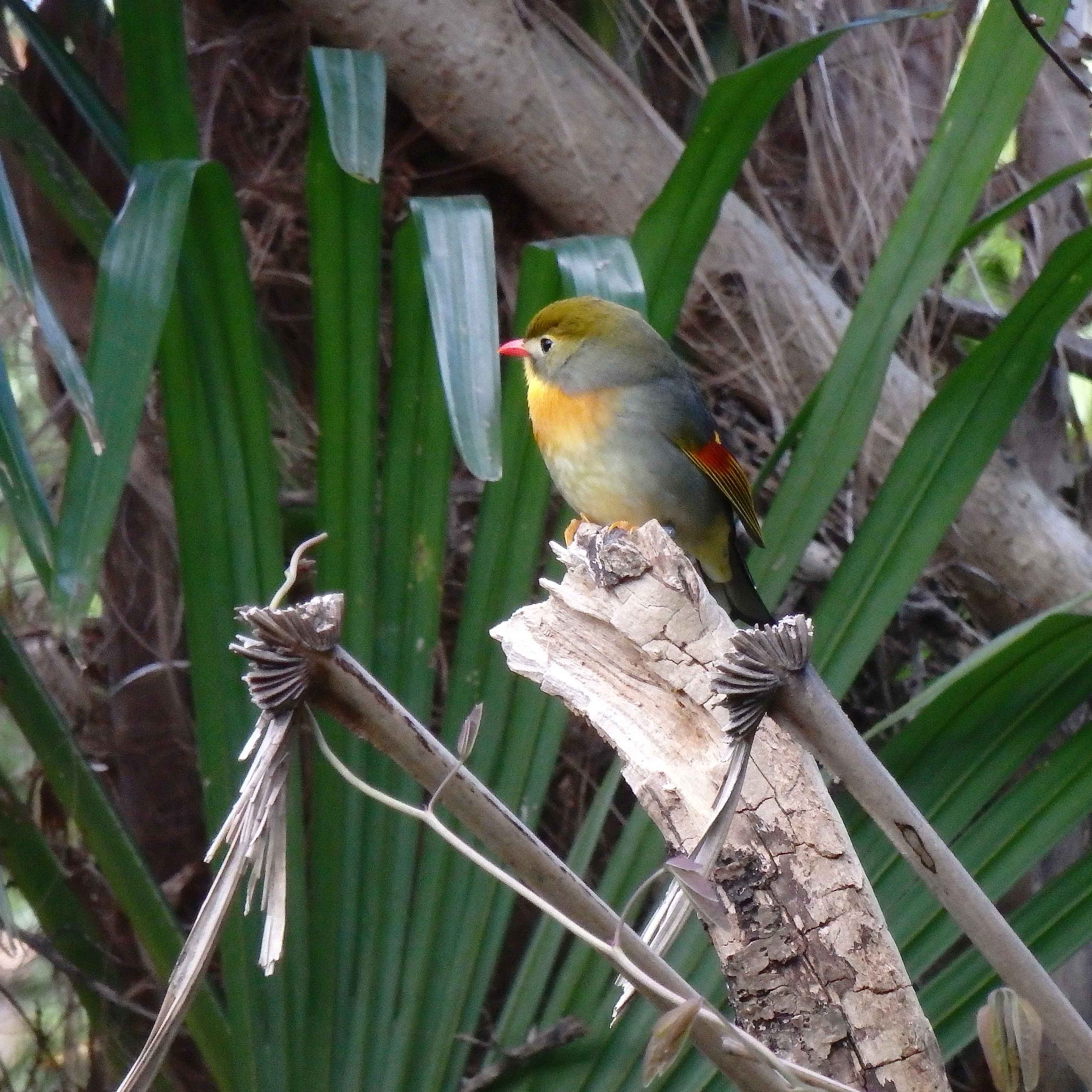 flitted through branches on the edge of the clearing. There were more Nicobar pigeons nearby, one roosting on a branch against the wall, another pottering on the ground, its colours dull and its head balding.
flitted through branches on the edge of the clearing. There were more Nicobar pigeons nearby, one roosting on a branch against the wall, another pottering on the ground, its colours dull and its head balding.
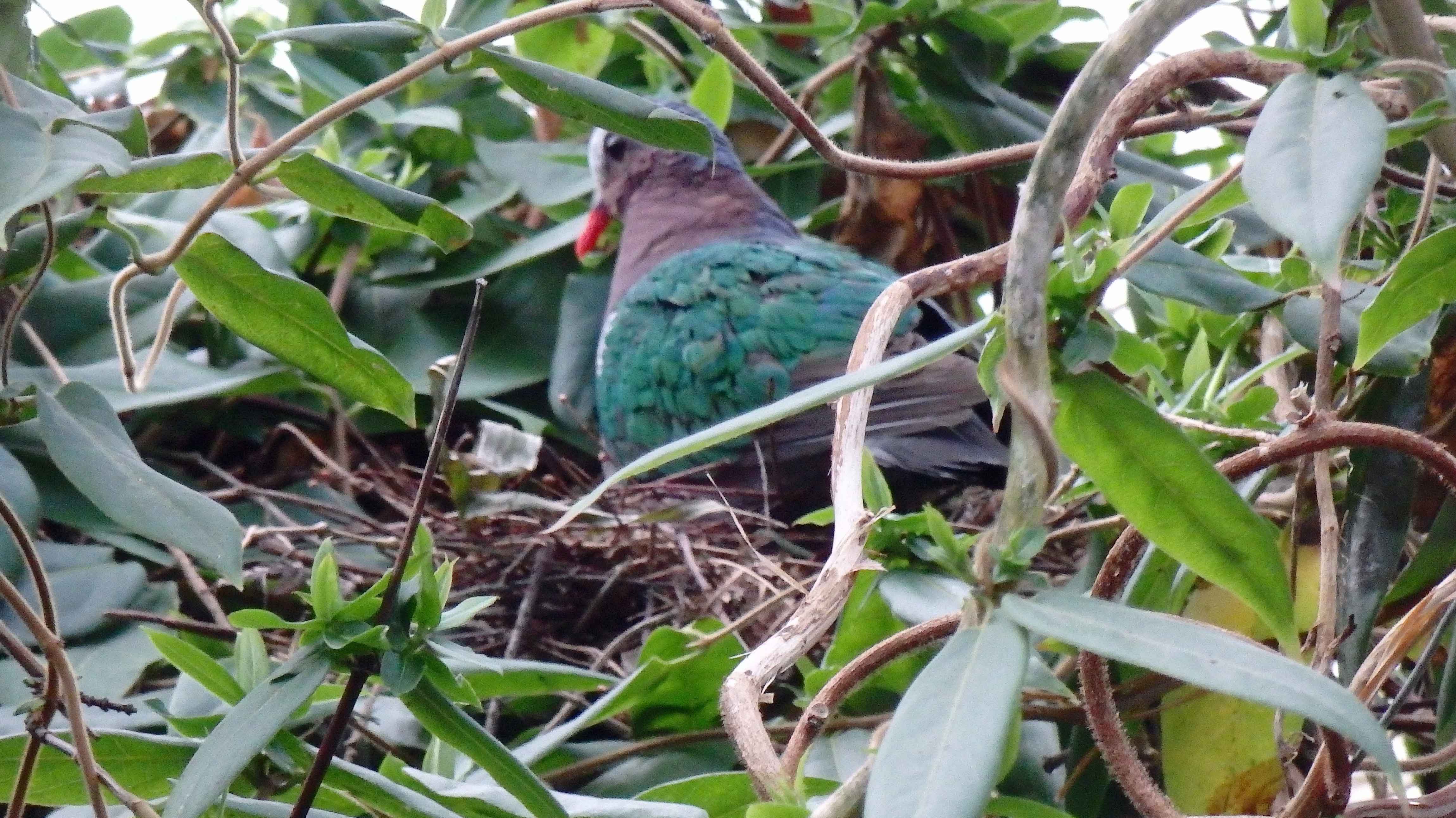
A pair of emerald doves were nesting in the branches above the bench, while nearby a female fairy bluebird was nearly hidden on her nest on a wall bar. The male fairy bluebird waited on a branch above the clearing, nesting 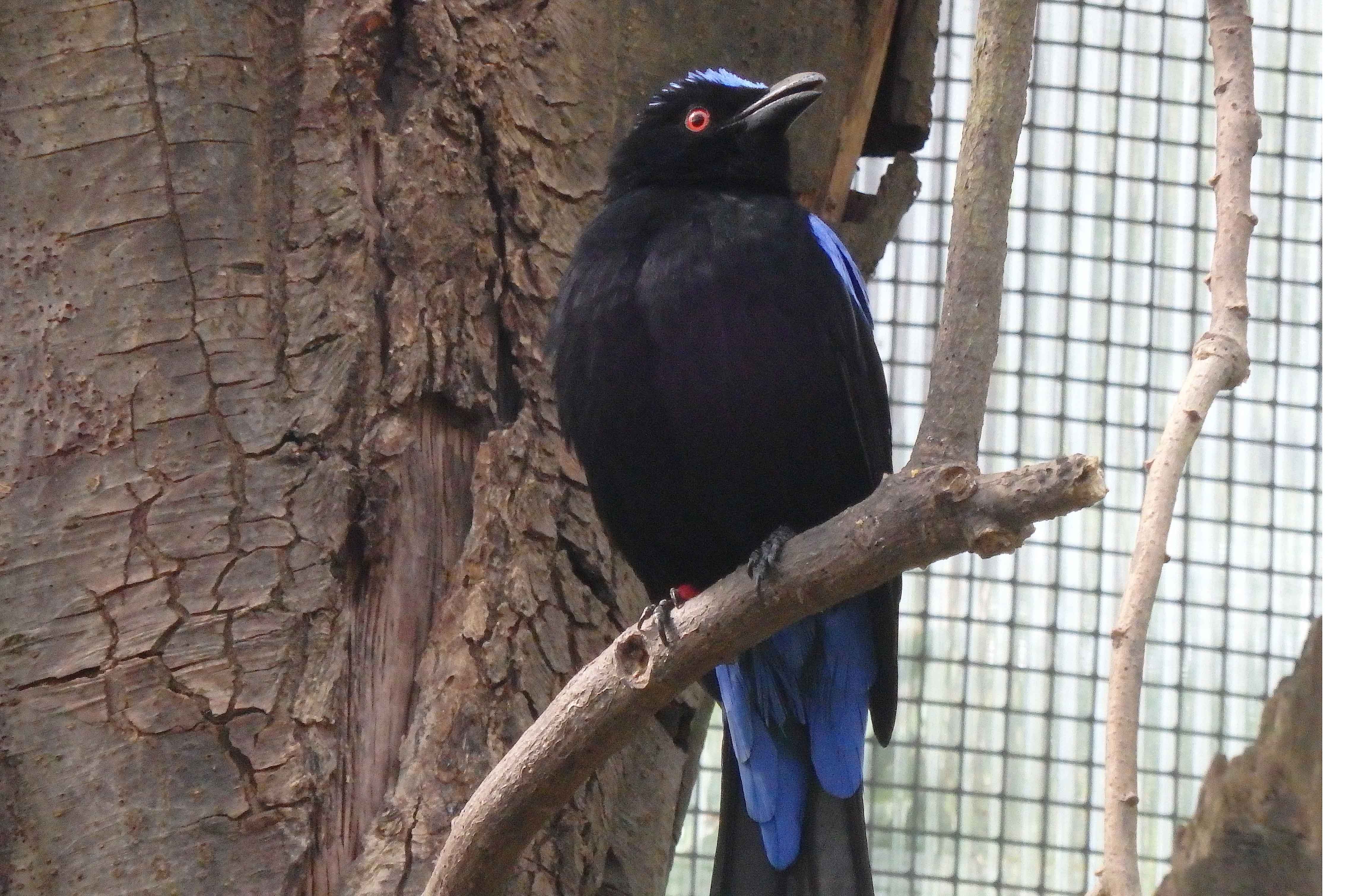 material in his beak, until it was safe enough for him to deliver it to the female. A food-bearing chestnut-backed laughing thrush
material in his beak, until it was safe enough for him to deliver it to the female. A food-bearing chestnut-backed laughing thrush 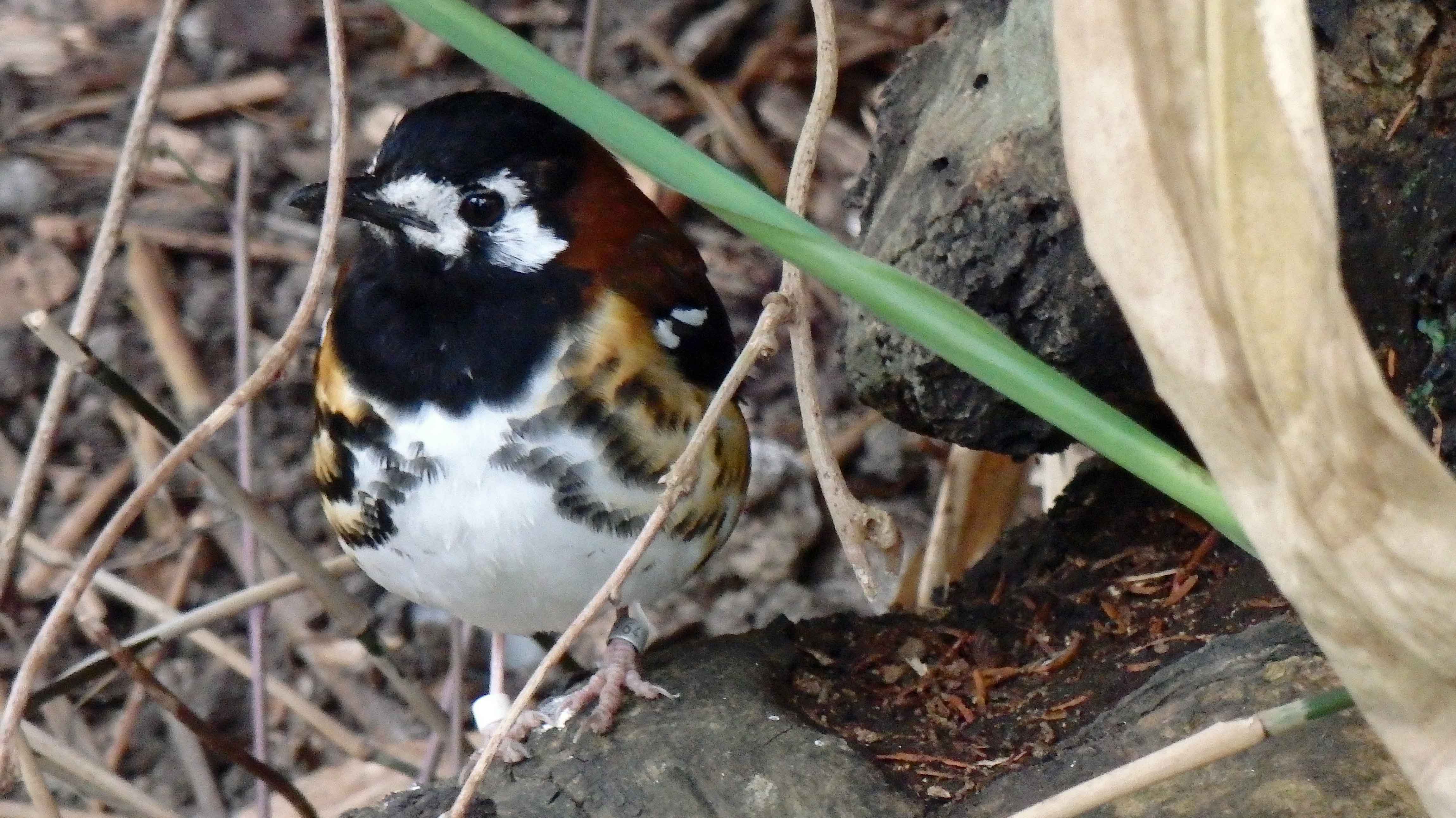 also appeared on the ground from the thicket and stood on the stump above the dry stream – the female was nesting on top of a dry trunk between the benches, just her head visible.
also appeared on the ground from the thicket and stood on the stump above the dry stream – the female was nesting on top of a dry trunk between the benches, just her head visible.
A peacock pheasant strode up and down in the clearing. A Pekin robin came to perch up high and sing, his throat visibly swelling with the sound. When he flew into the climbers beyond the bench the male chestnut-backed thrush immediately chased after him. The robin shot out, and so did a fairy bluebird.
Further into the park is the Kirindi Forest, its open dryness a complete contrast to the damp lushness of the Jewels of the Forest. Here a hammerkopf was on the ground by a vertical trunk, beneath one of the bird’s towering nests.
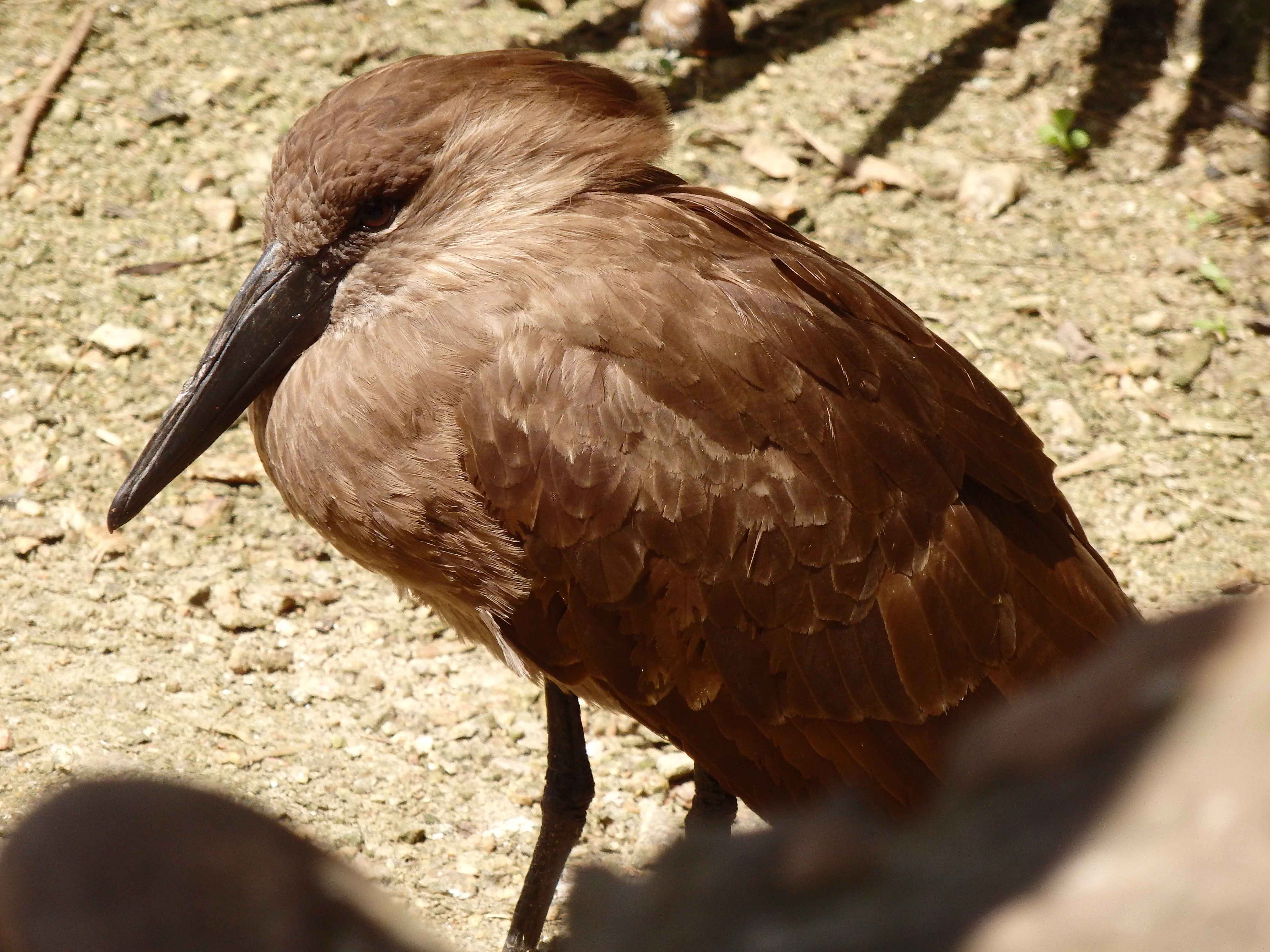
An ibis was thrashing a worm before drowning it in water and eating it.
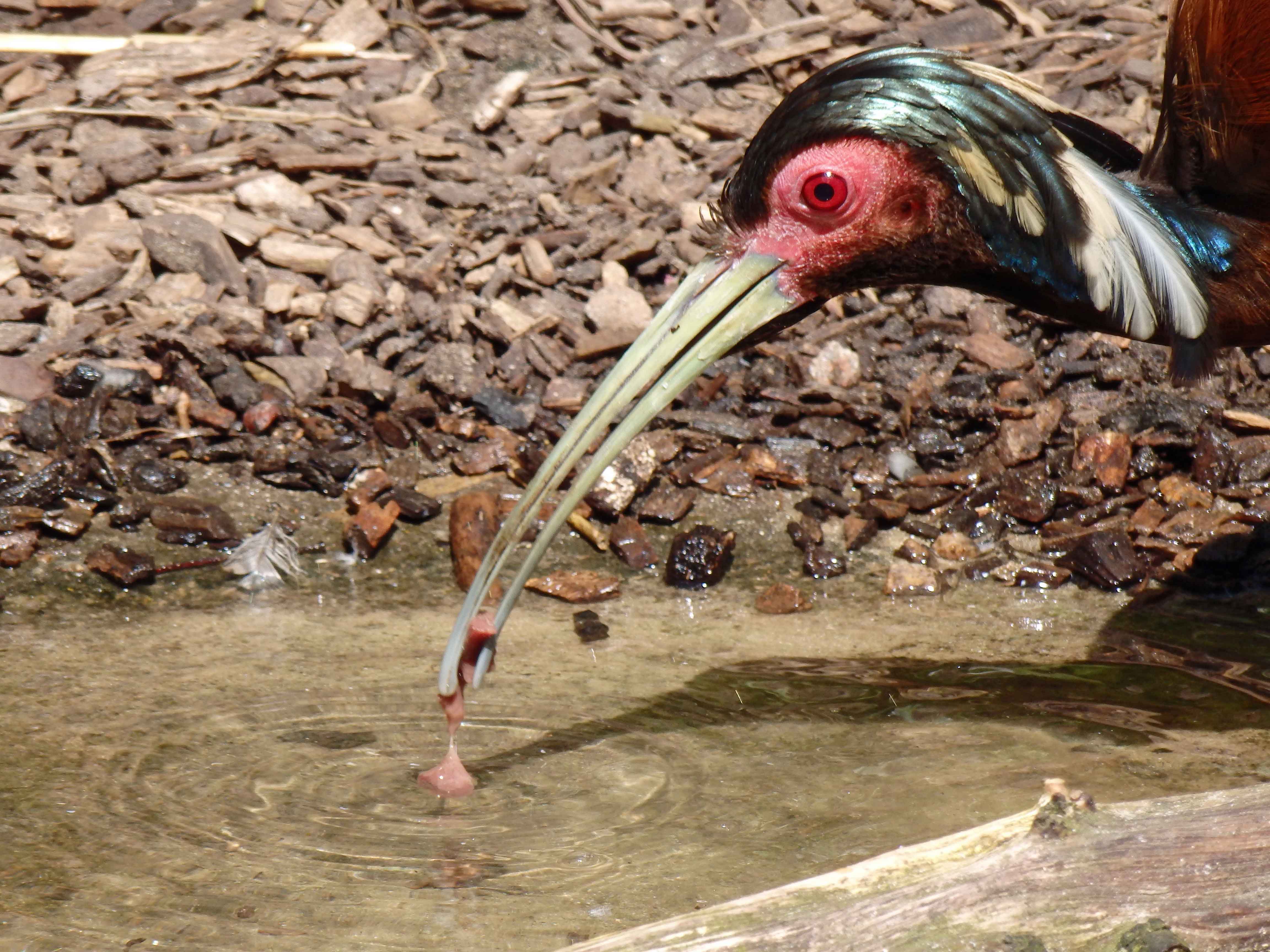
Scarlet male fodys flitted everywhere, occasionally pausing to look round for a second.
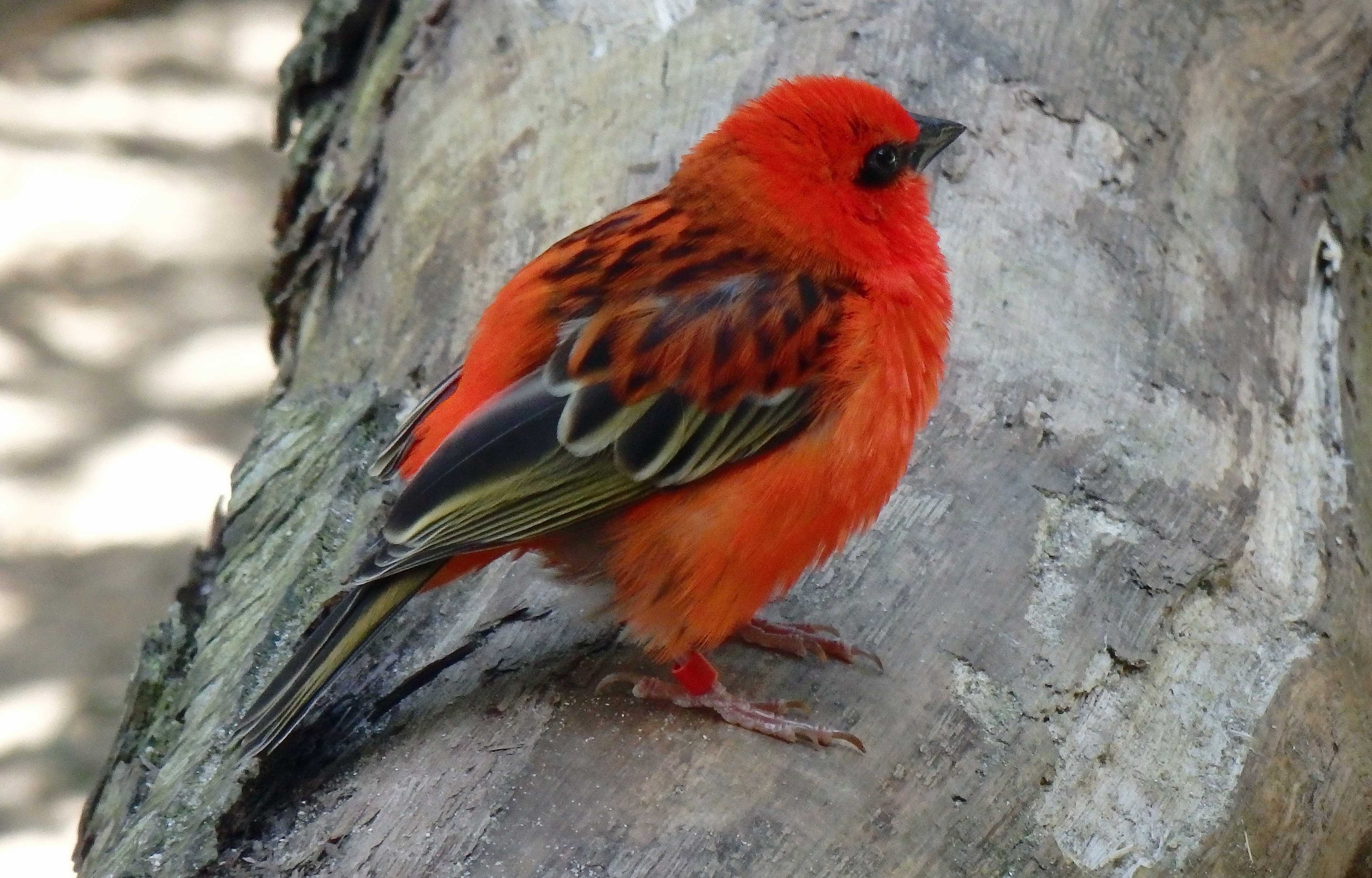
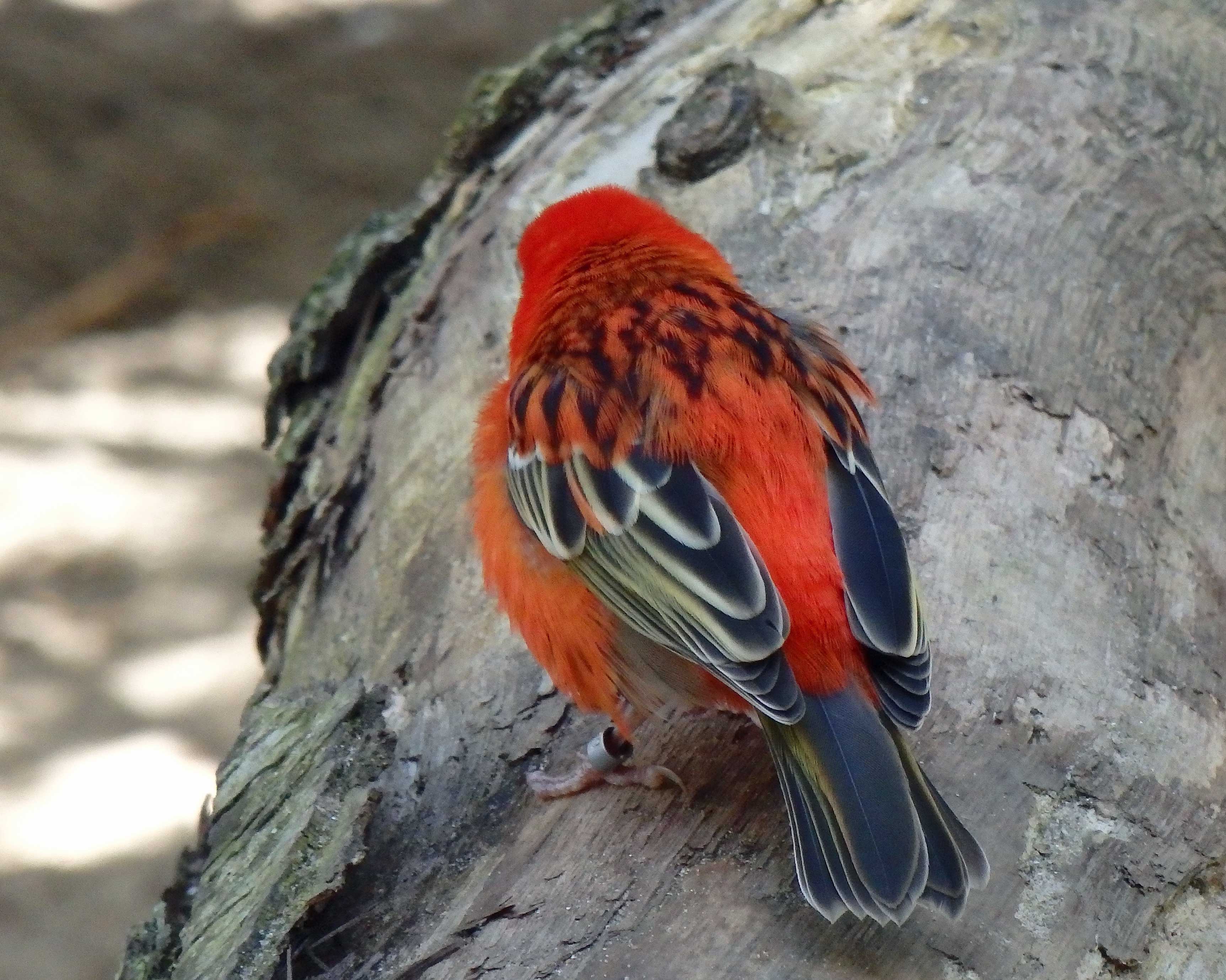
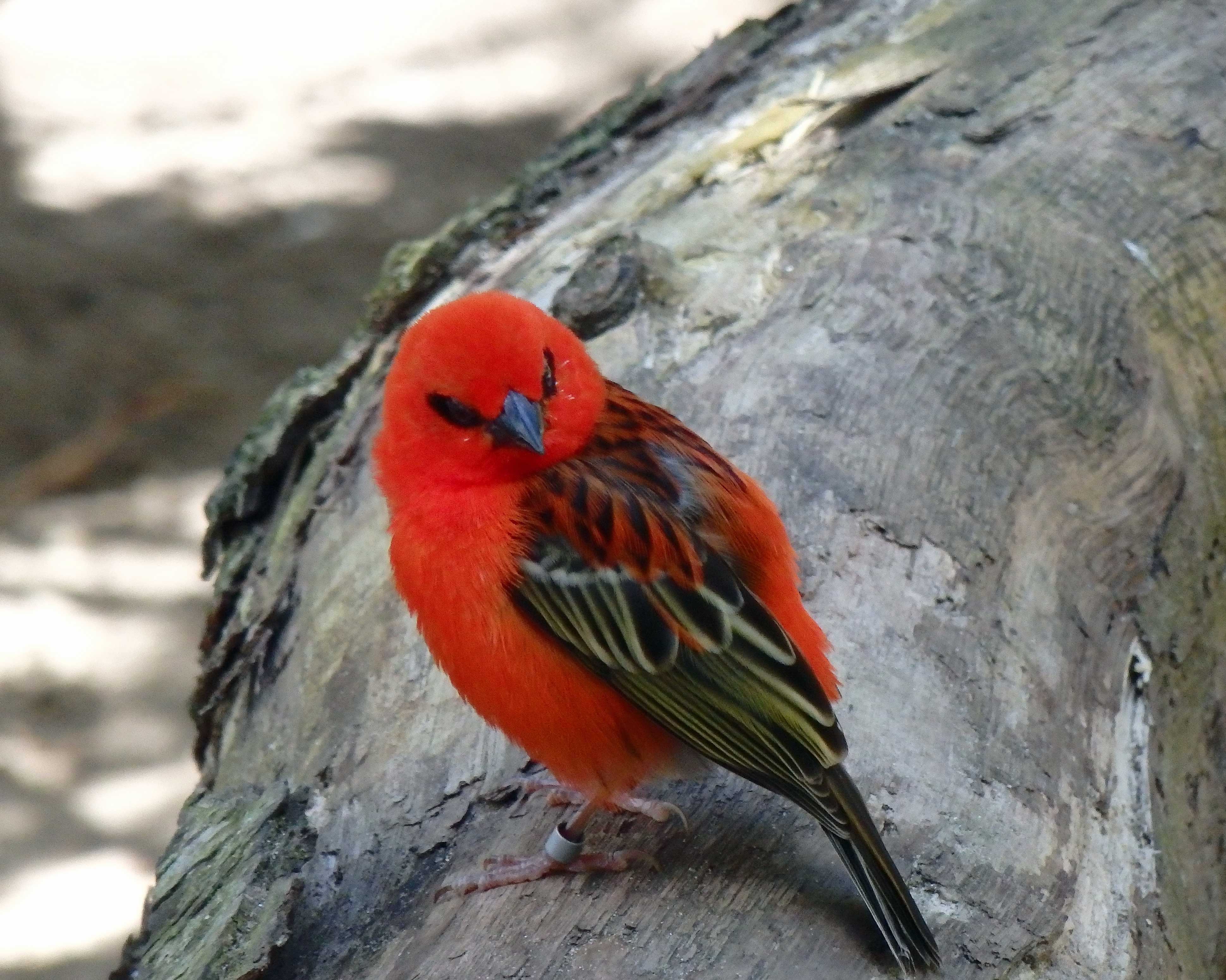
24–28 April 2016
Meerkats and monkeys
In the cold wet weather the meerkats were mainly indoors, grooming in pairs on one of the shelves,
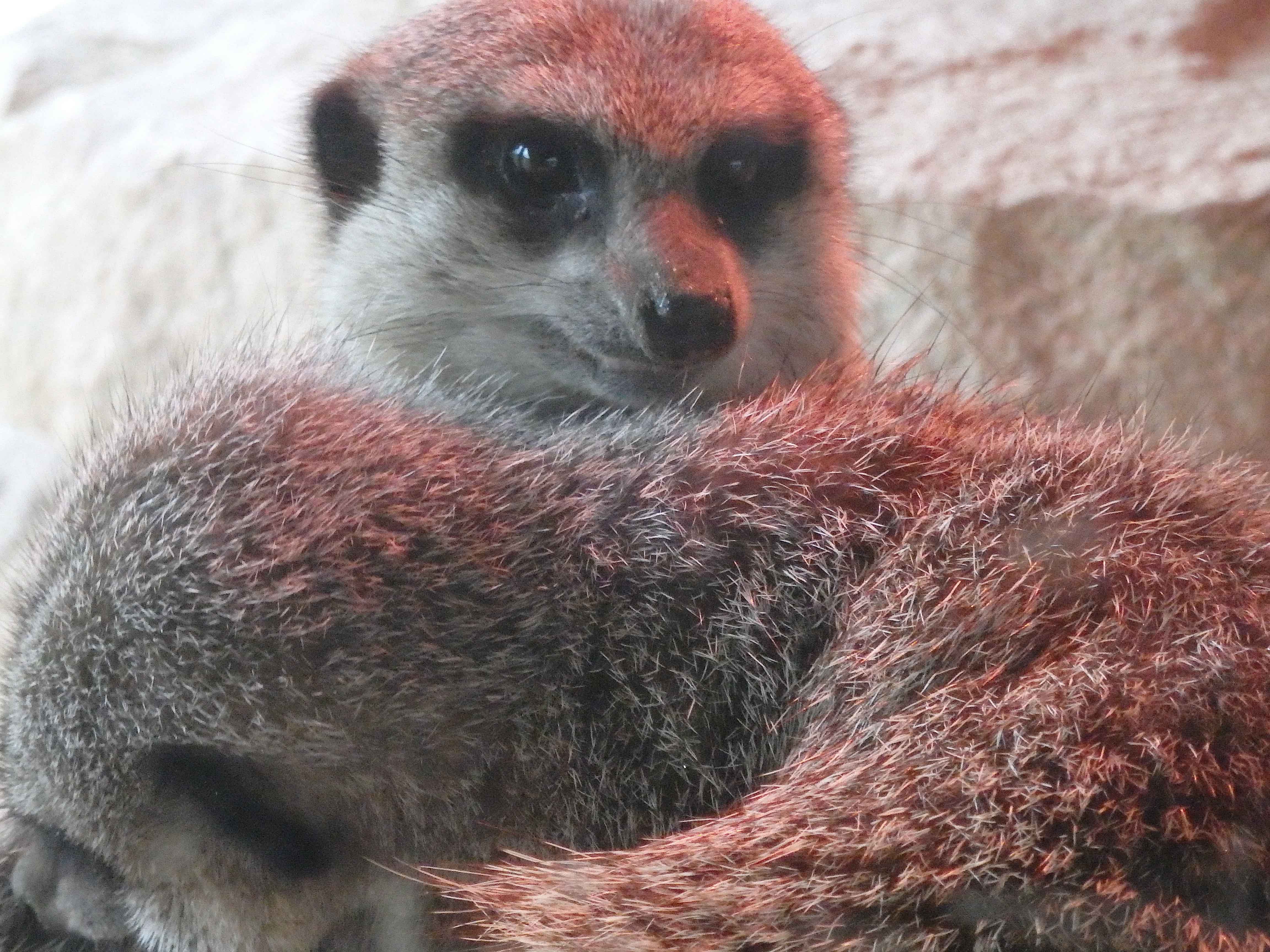
warming in huddles under a heat lamp,
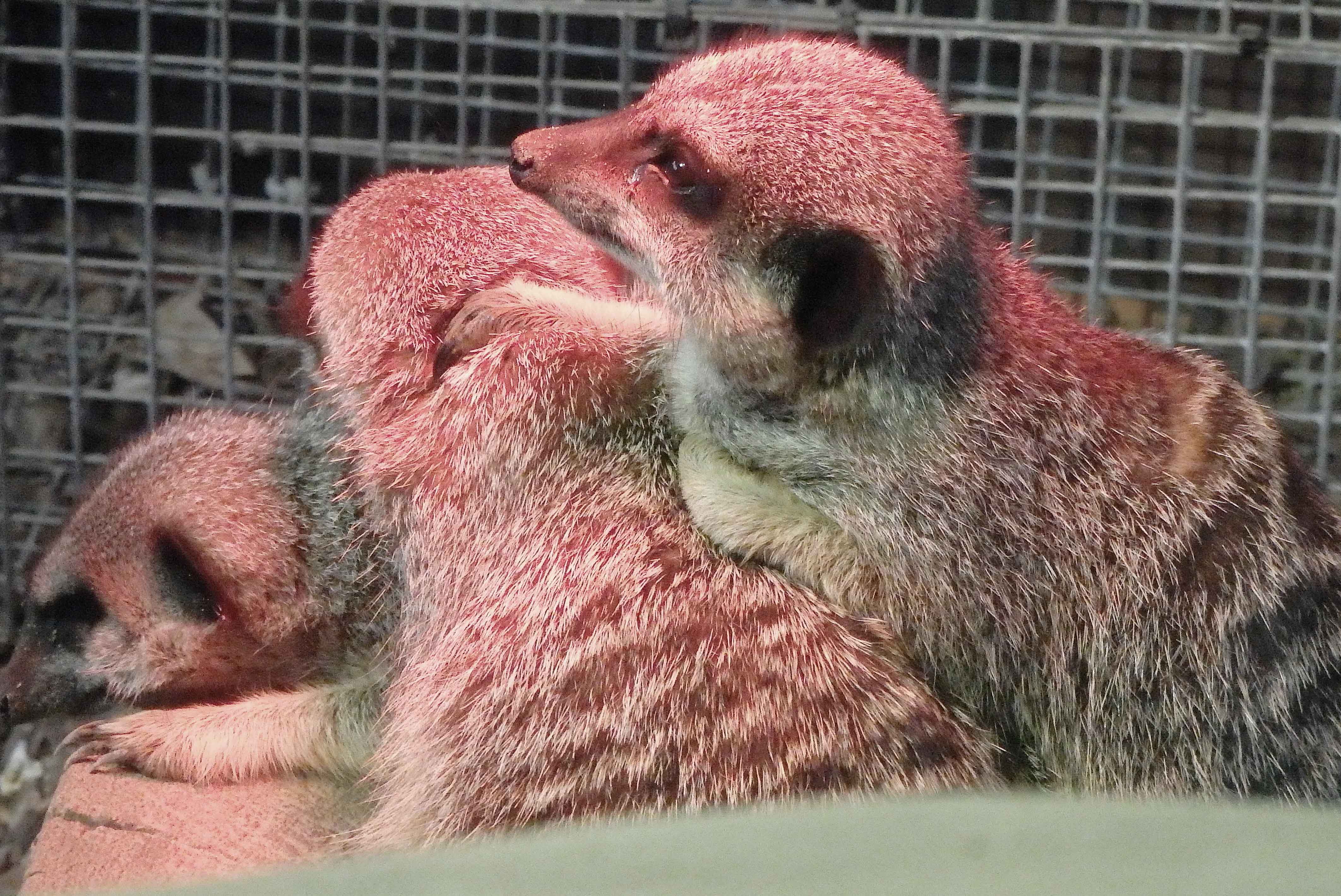
peering out of the windows at the rain.
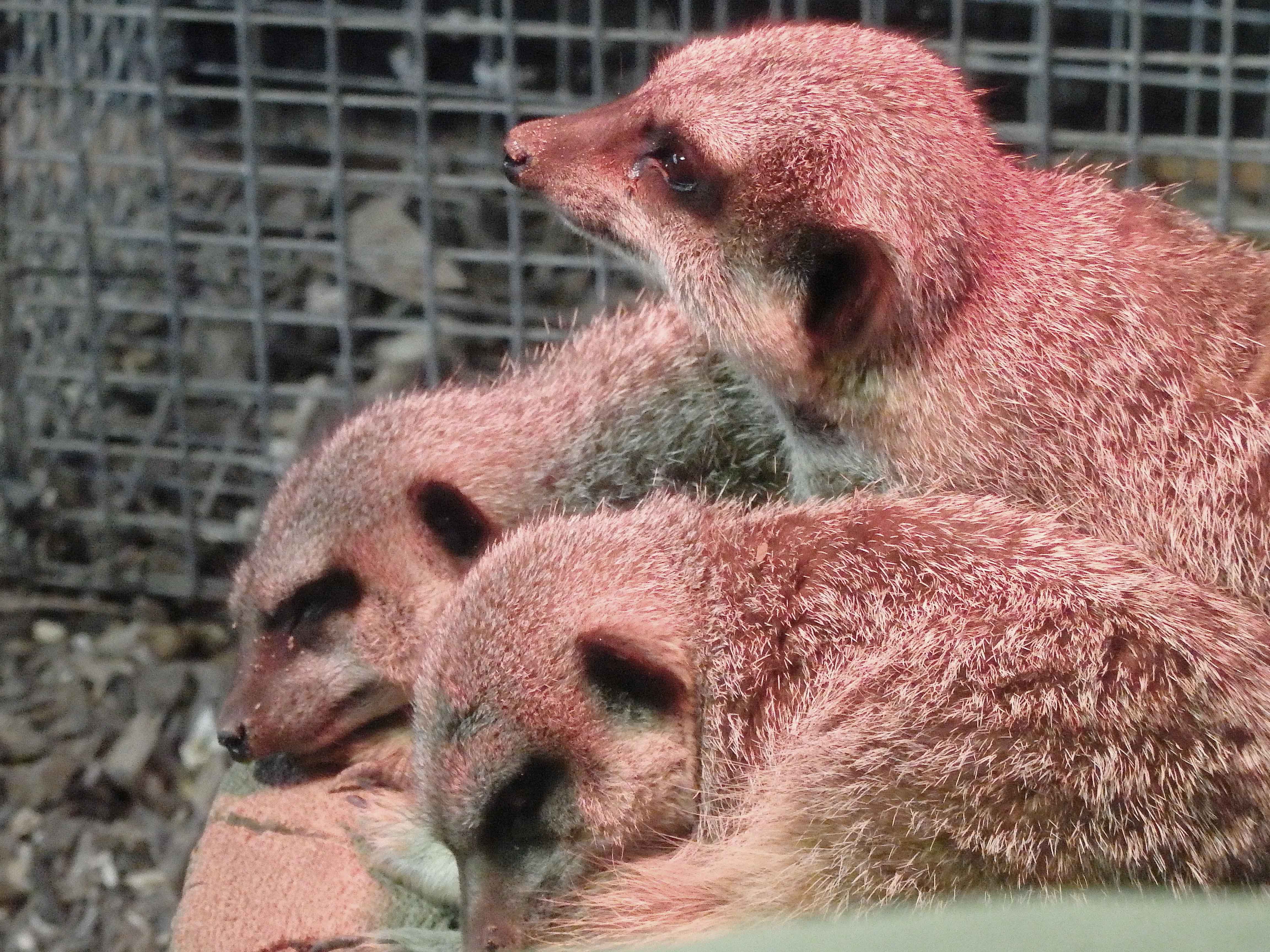
On the few occasions when they ventured into the briefly dry outside it was usually to wait as a crowd for their keeper.
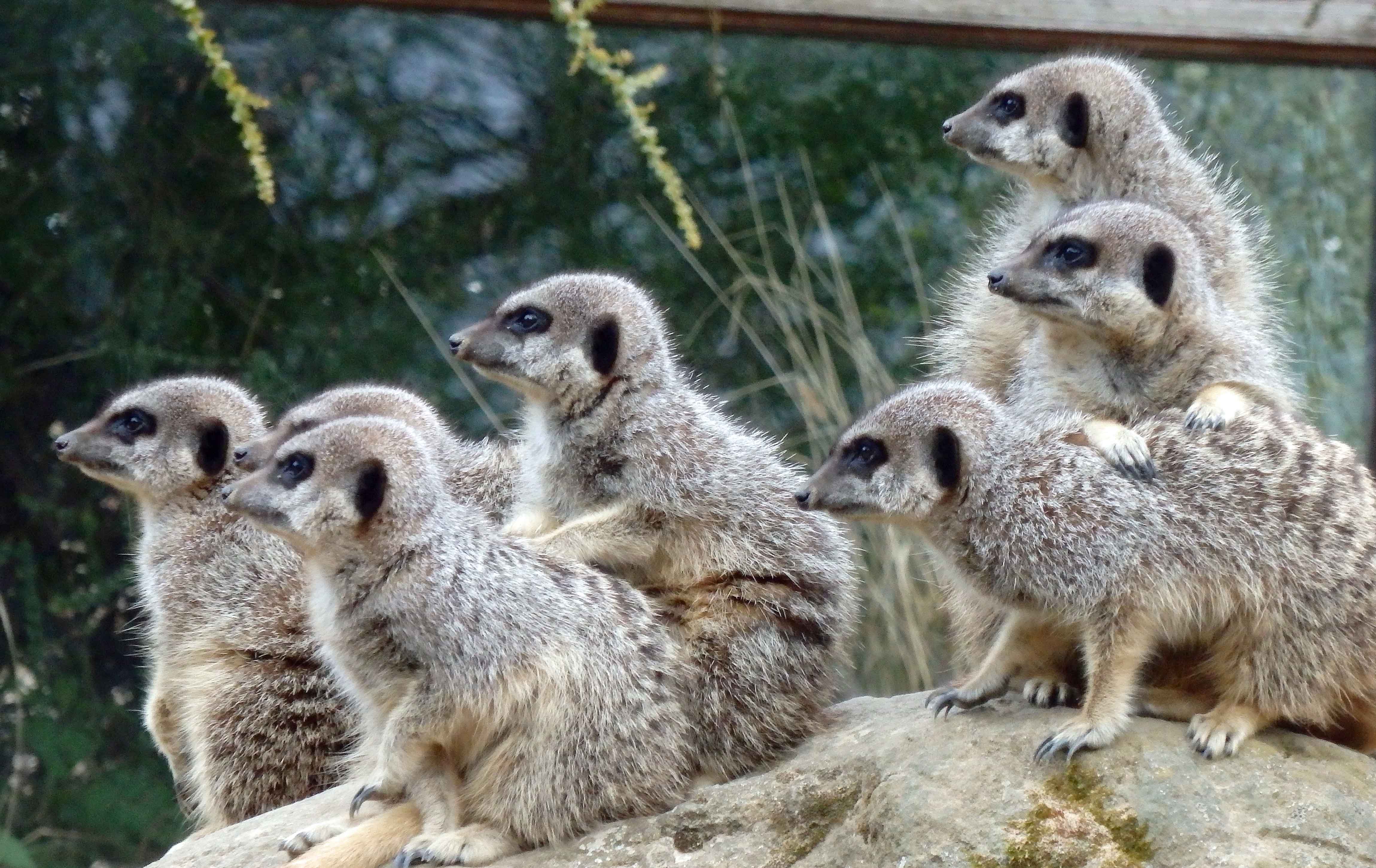
Whatever they did, they constantly paused to stare around, front, right, left, behind.
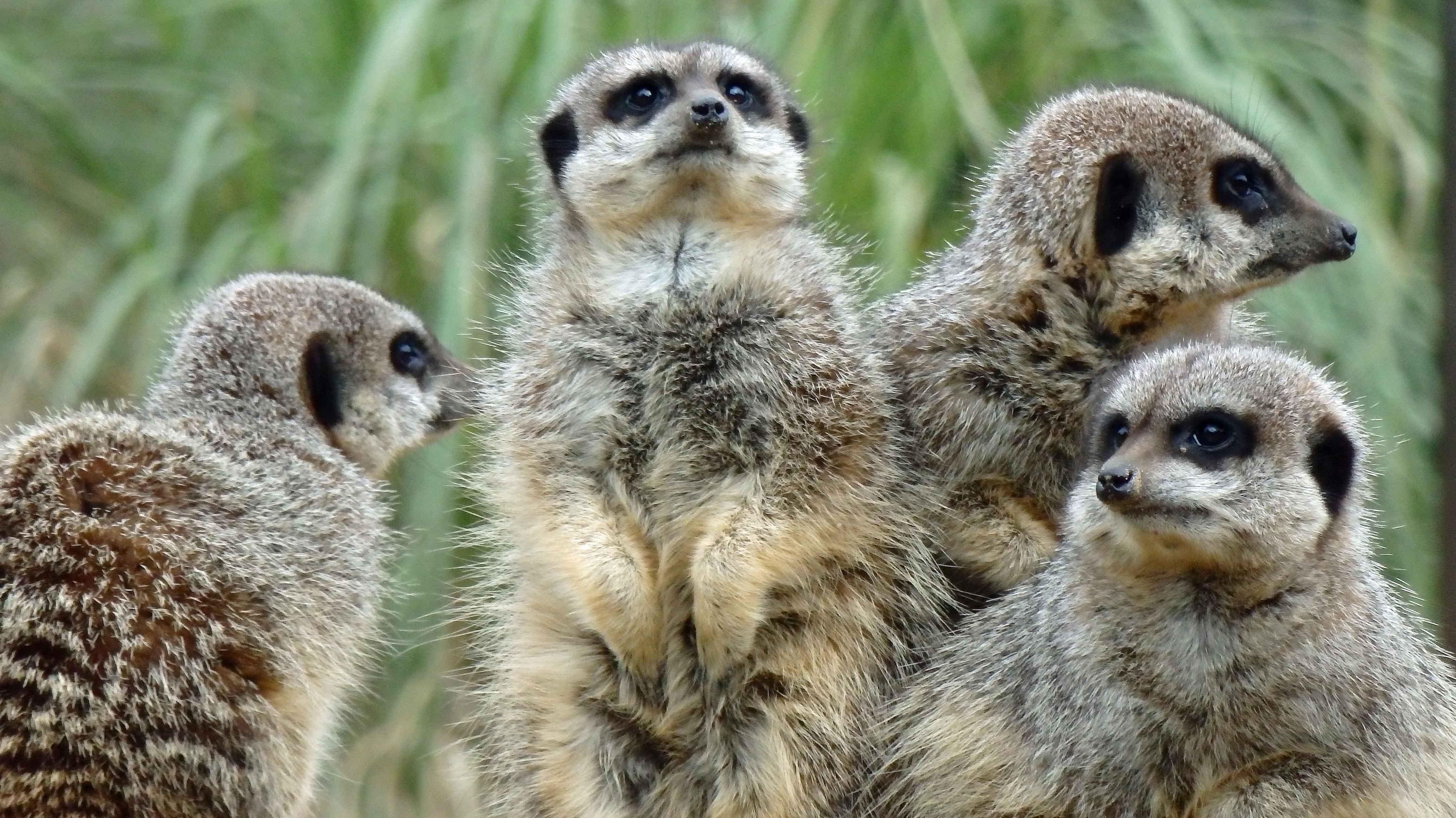
25 April 2016
Howlers
The reserve area above the back courtyard still has two black howler monkey brothers who are waiting for a new home. One male is more dominant than the other, but both were scared of Safy, the bullying golden howler female in the pair at the First Impressions enclosure. Later on, I spotted her trying to pick a fight with the senior of the three coati females.
26 April 2016
Macaques
The macaque situation has improved since the older dominant male was removed, giving the younger male chance to improve his position. He’s bulked up physically and recently achieved two consecutive dominance calls. He now has more control over the group. Four of the younger group members were racing around their outdoor enclosure, triumphantly clutching empty cardboard boxes.
27 April 2016
Native species (to Jersey)
A crowned crane stalked majestically over the grass, the manor house a fitting setting beyond.
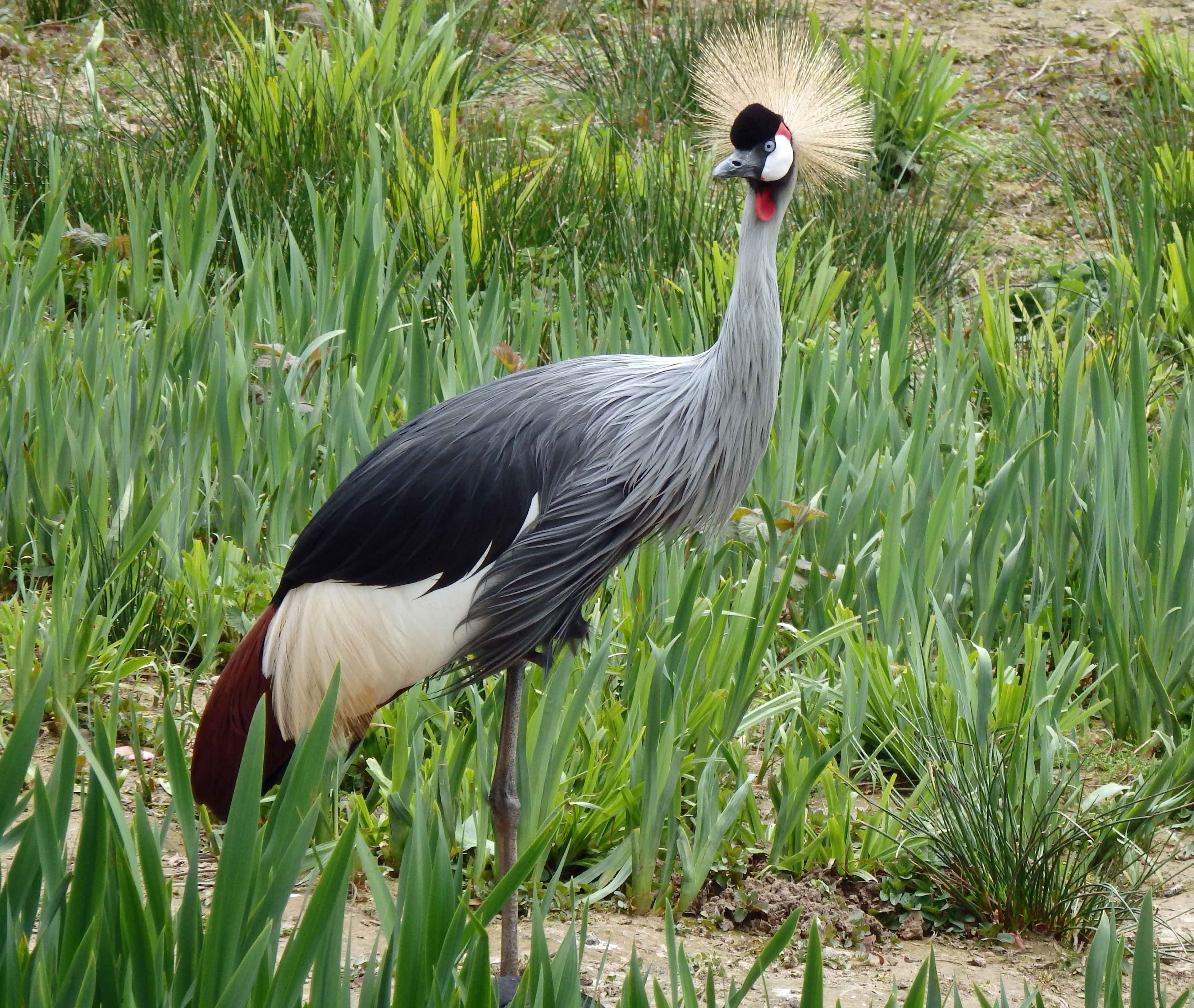
More mundane local life took place on the lake below, where water rippled over the gunnera stems. There was a stirring in the nearby iris leaves and a duckling, dark with a white front, shot out to follow the adult mallards who were already dipping into the deeper water.
A wren is nesting in a tree trunk in the gorilla enclosure, and used the indoor bowl of water, often emptying it completely by splashing around in it.
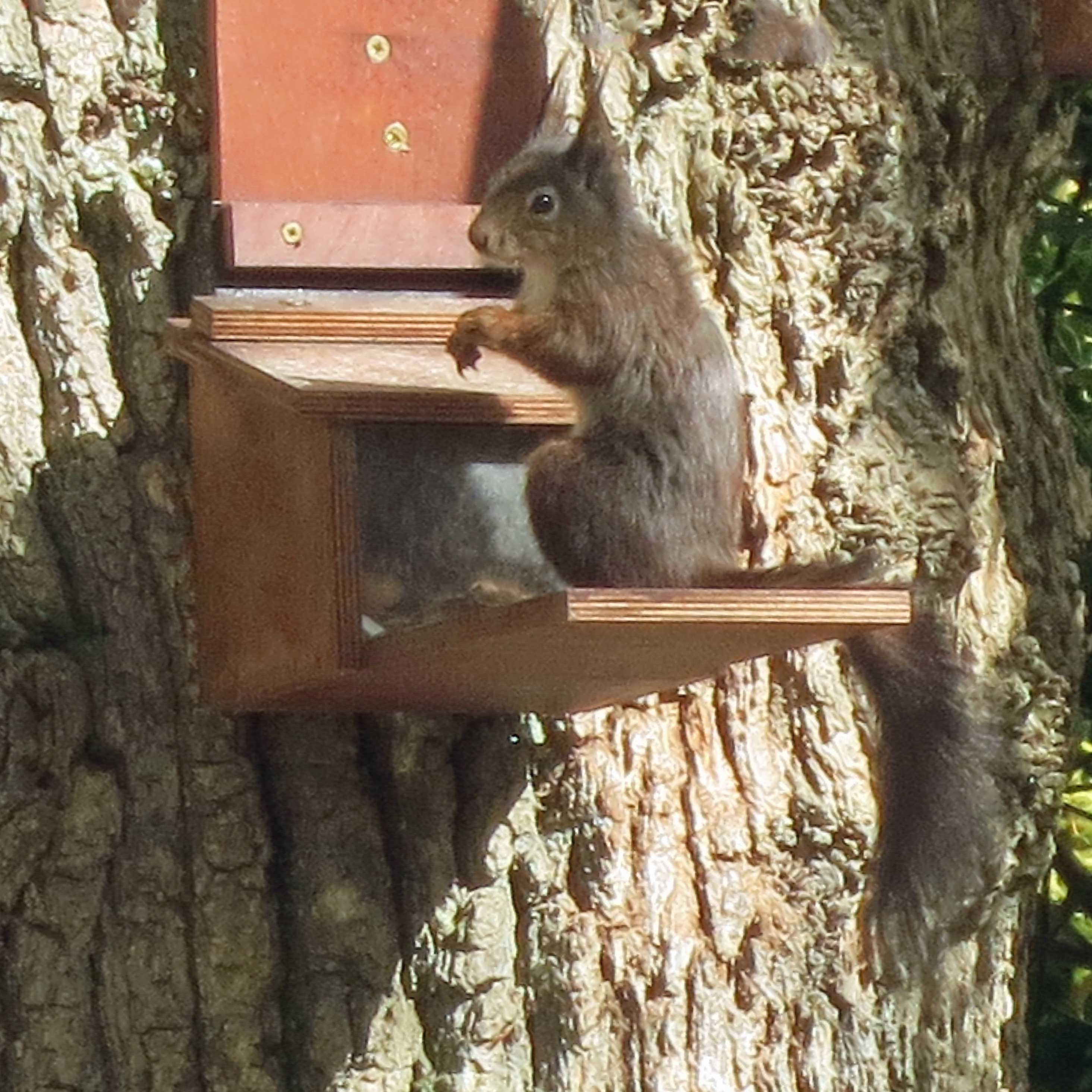
A red squirrel normally appears in the evening on the fence beside the old maned wolf enclosure, but the path there is being relaid and so the squirrel seems to be visiting the nut feeder up by the walled garden.
24–28 April 2017
Andean Bears 2017
6 Life with a cub
Bahia, adult female
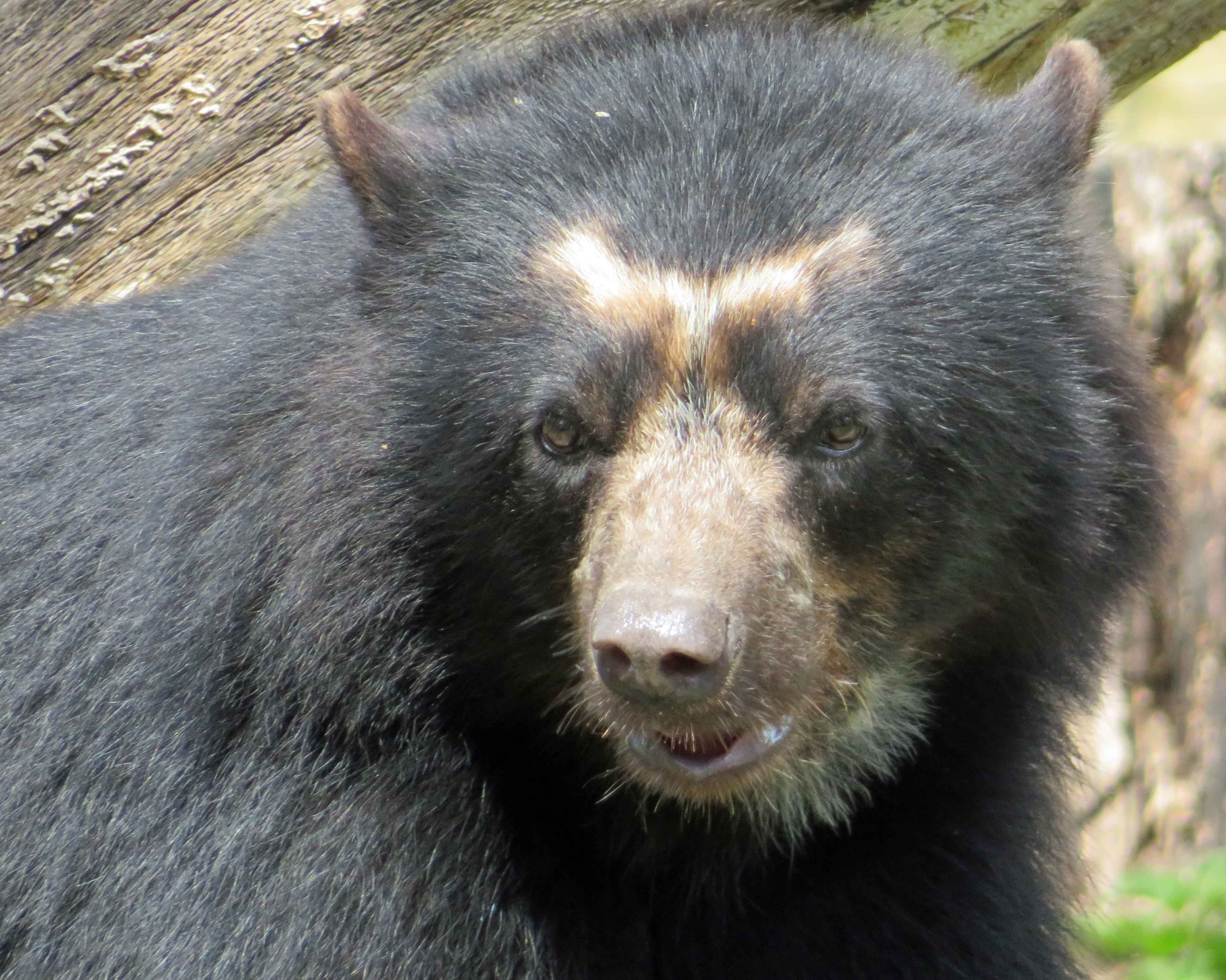
Chui, adult male
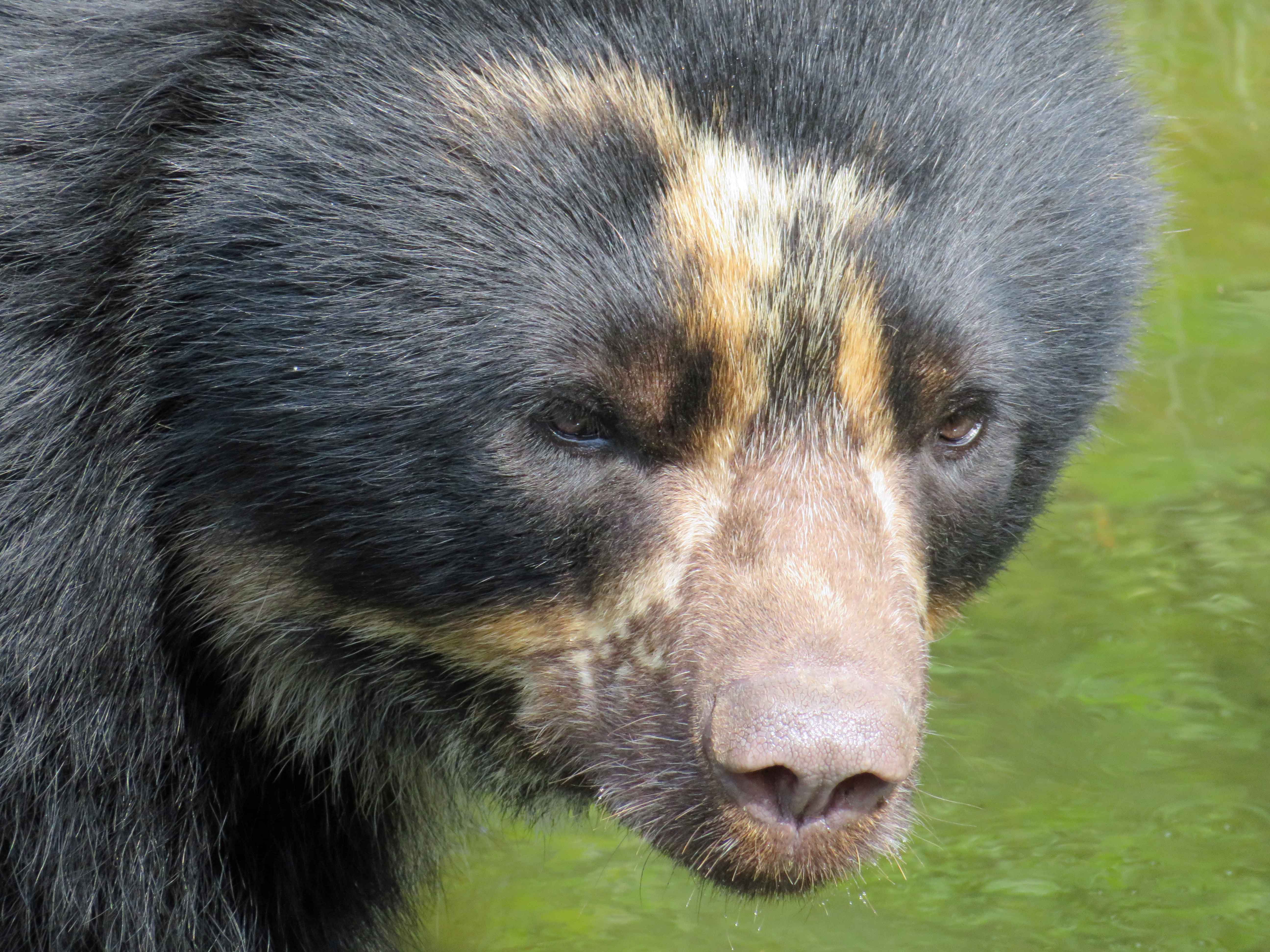
Raymi, juvenile male, son of Bahia and Chai
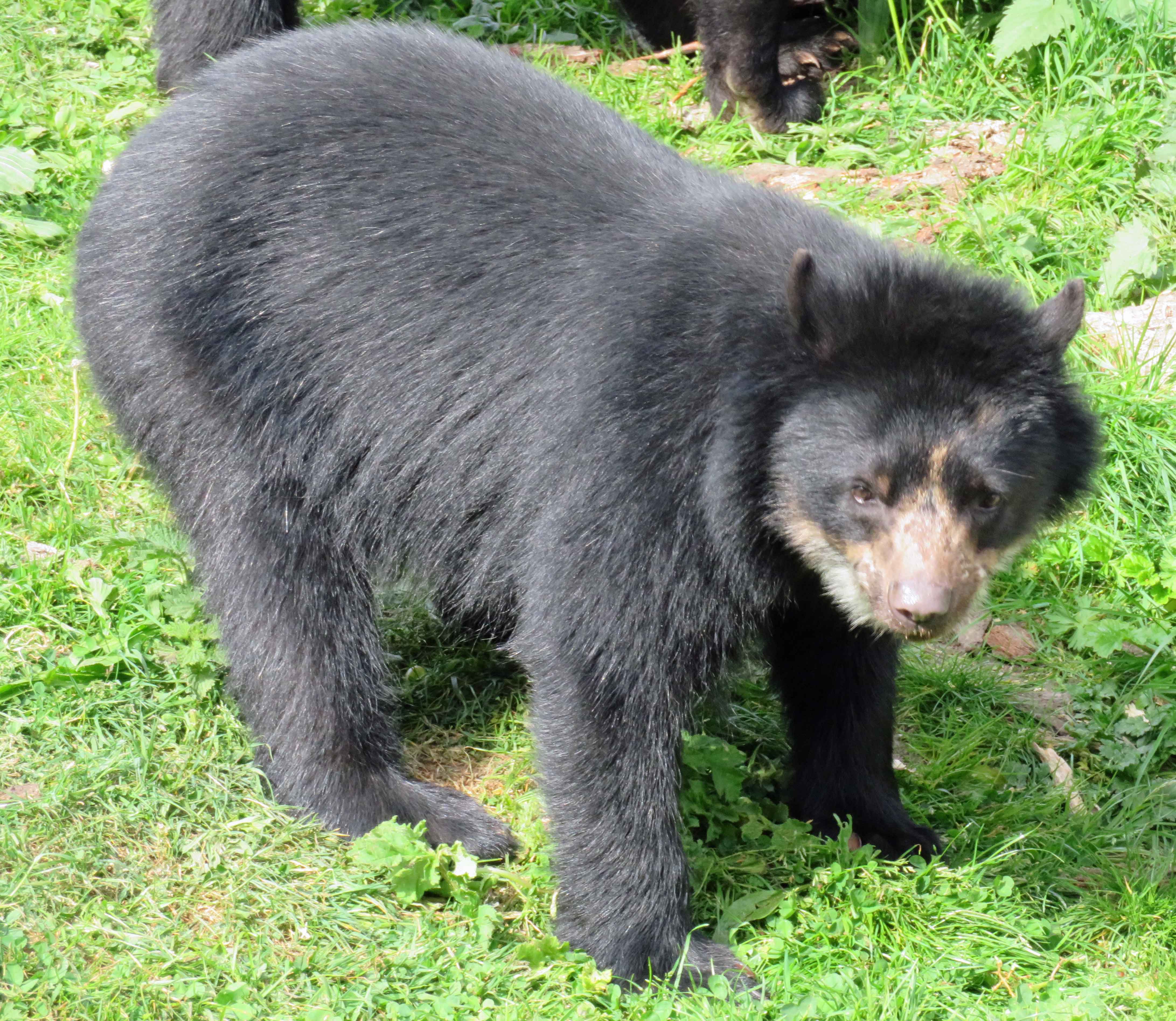
22 April 2017
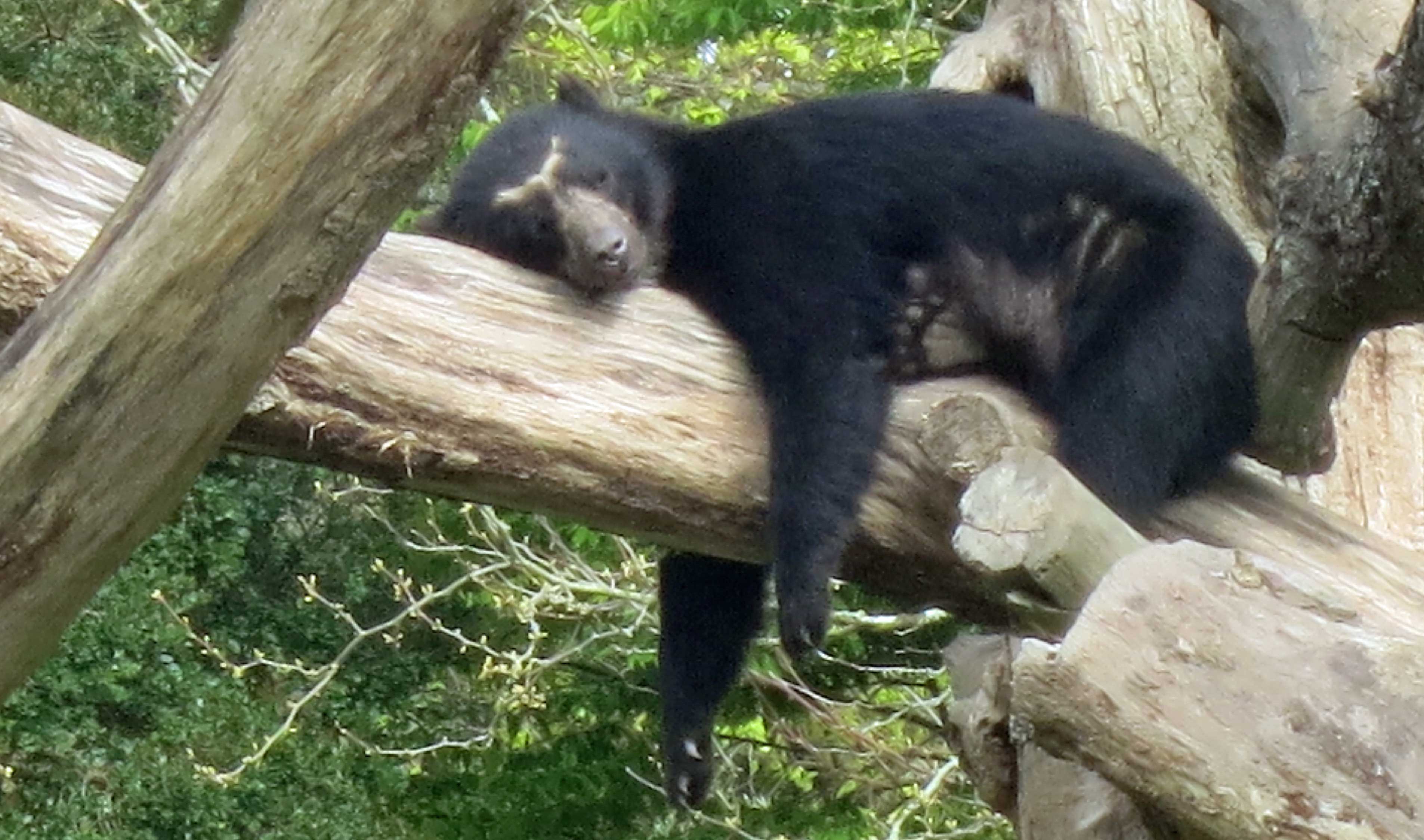
The Andean bear family were all out, supine in the sunshine. Each had their own space, some distance from the others. Chui lay hunched on the junction of two bleached tree trunks. 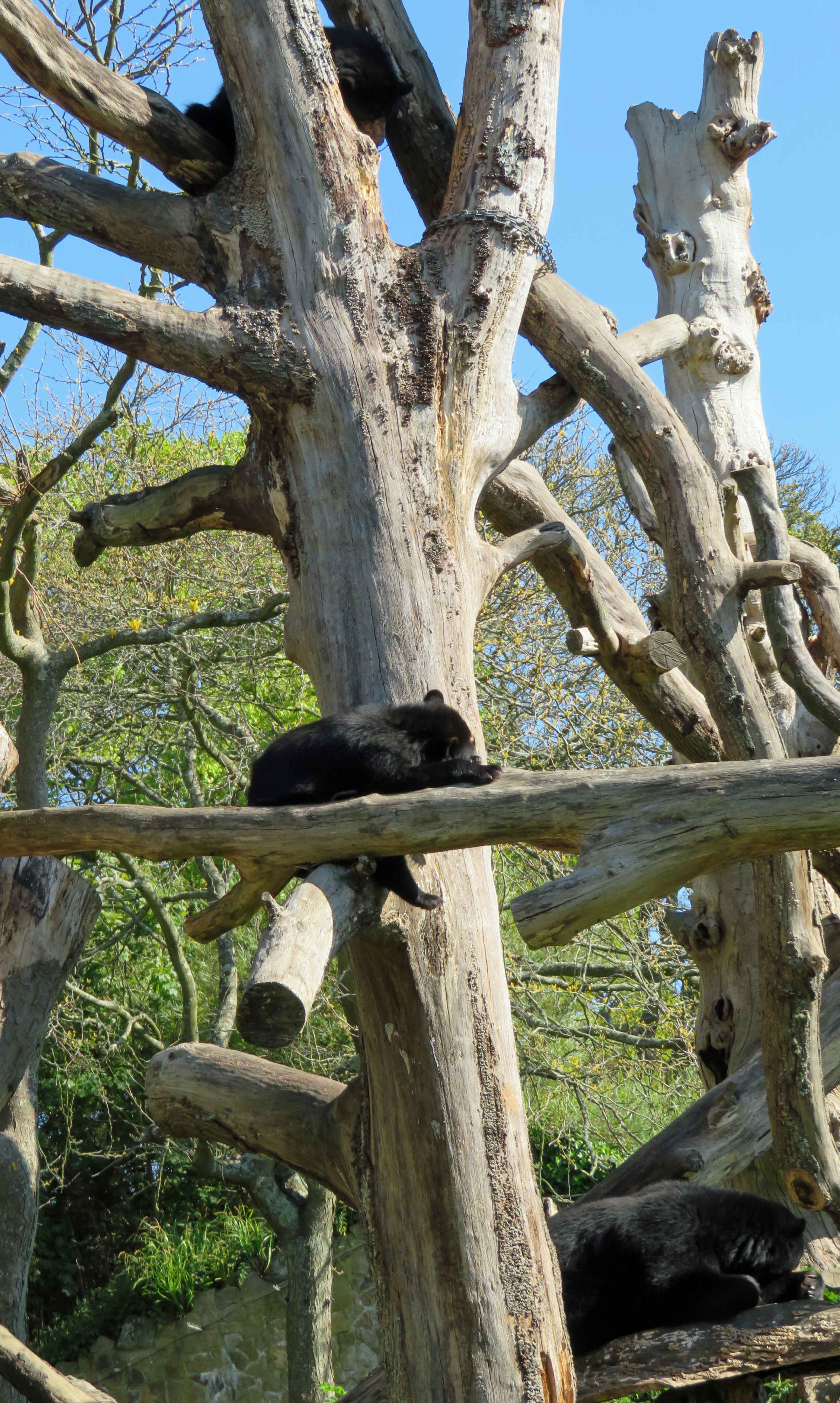 Bahia looked much more comfortable, laying full length in utter abandon along another trunk, her paws dangling limply down on both sides of her improvised bed.
Bahia looked much more comfortable, laying full length in utter abandon along another trunk, her paws dangling limply down on both sides of her improvised bed.
Young Raymi, now fourteen months old, was perched high above his father and was much less settled, constantly turning around and peering down from different angles. When he did eventually settle, his pose imitated one of his father's favourites, laying neatly on all four paws, head forward, eyes scanning the surroundings, nose twitching for scents.
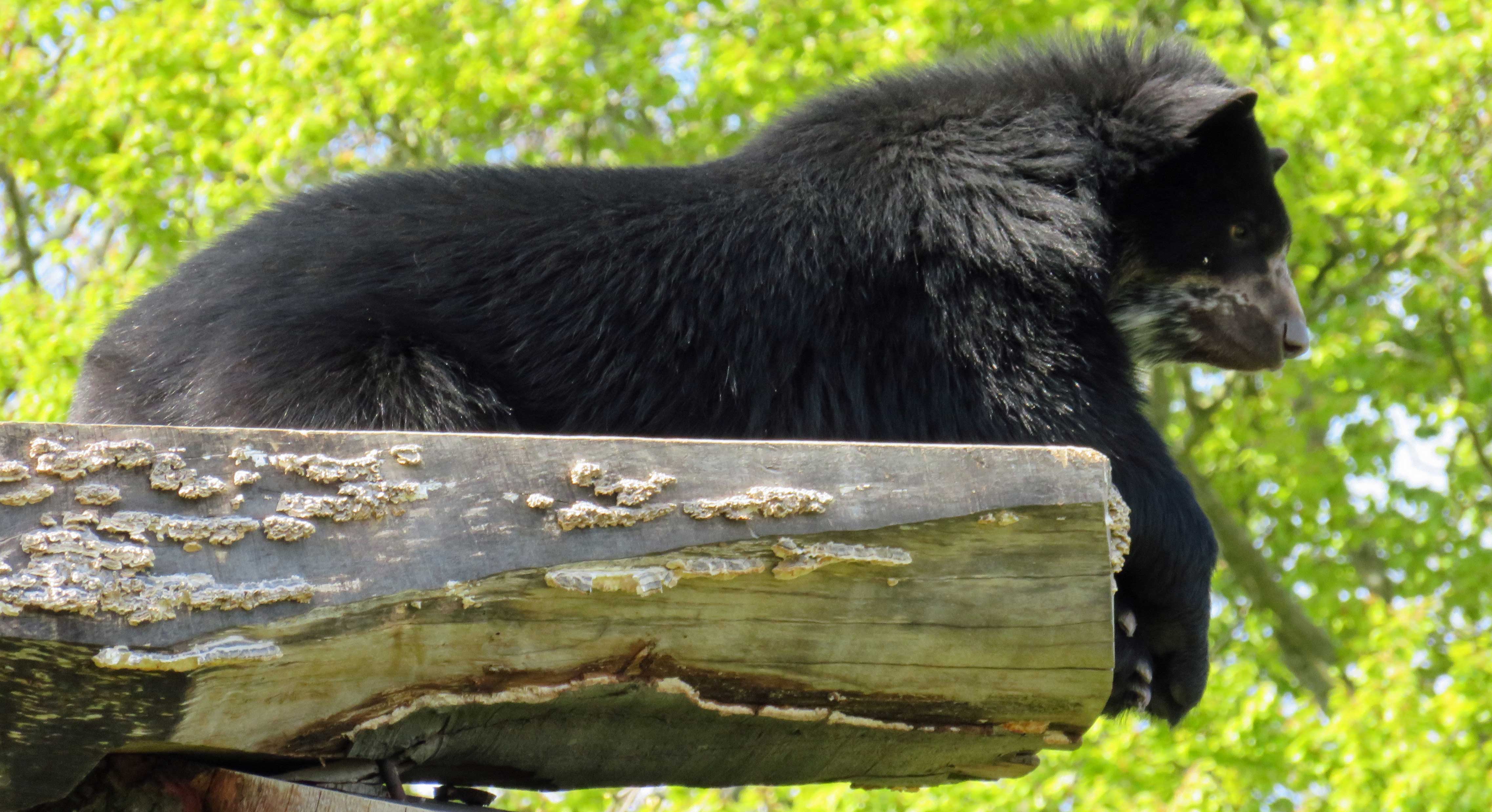
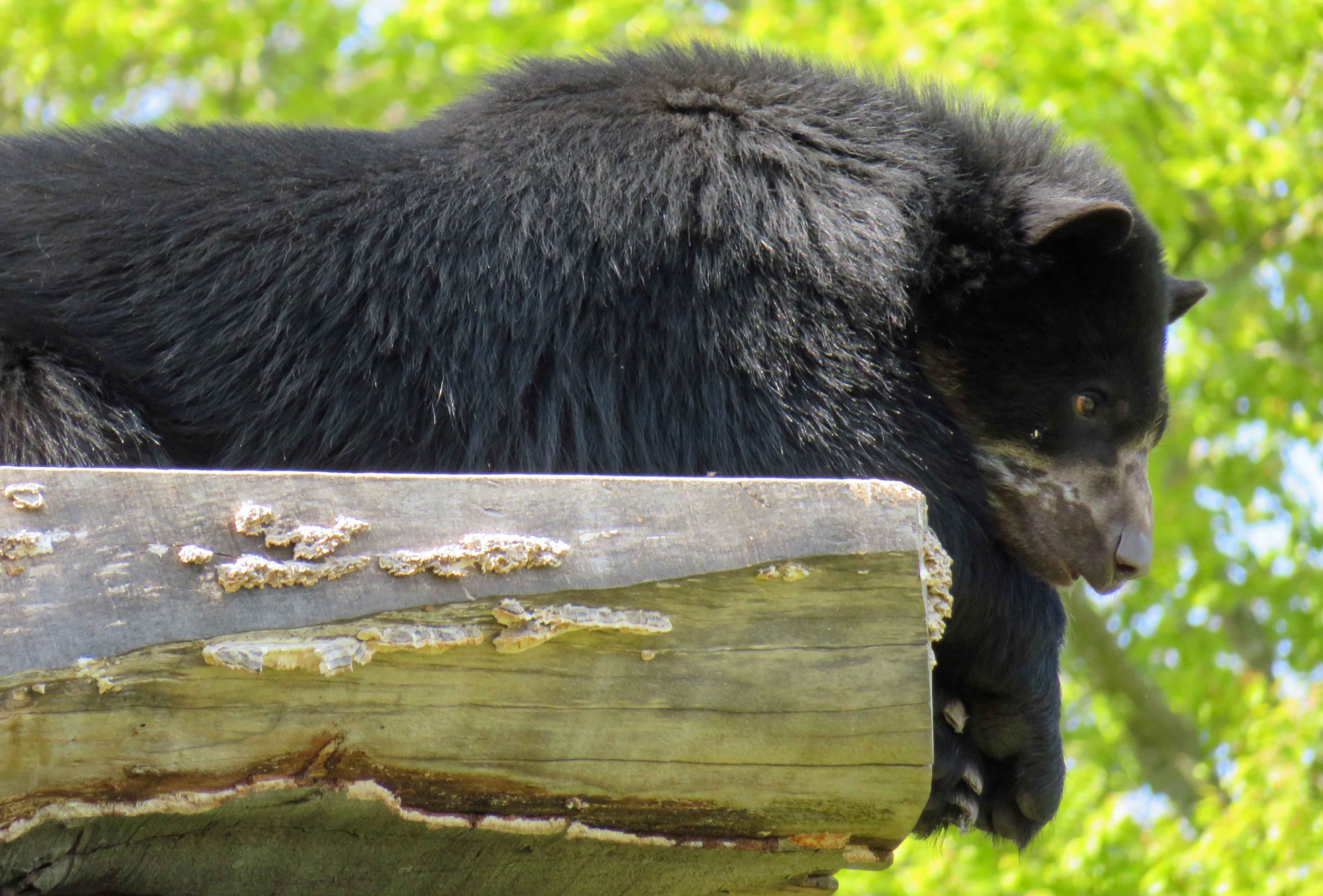
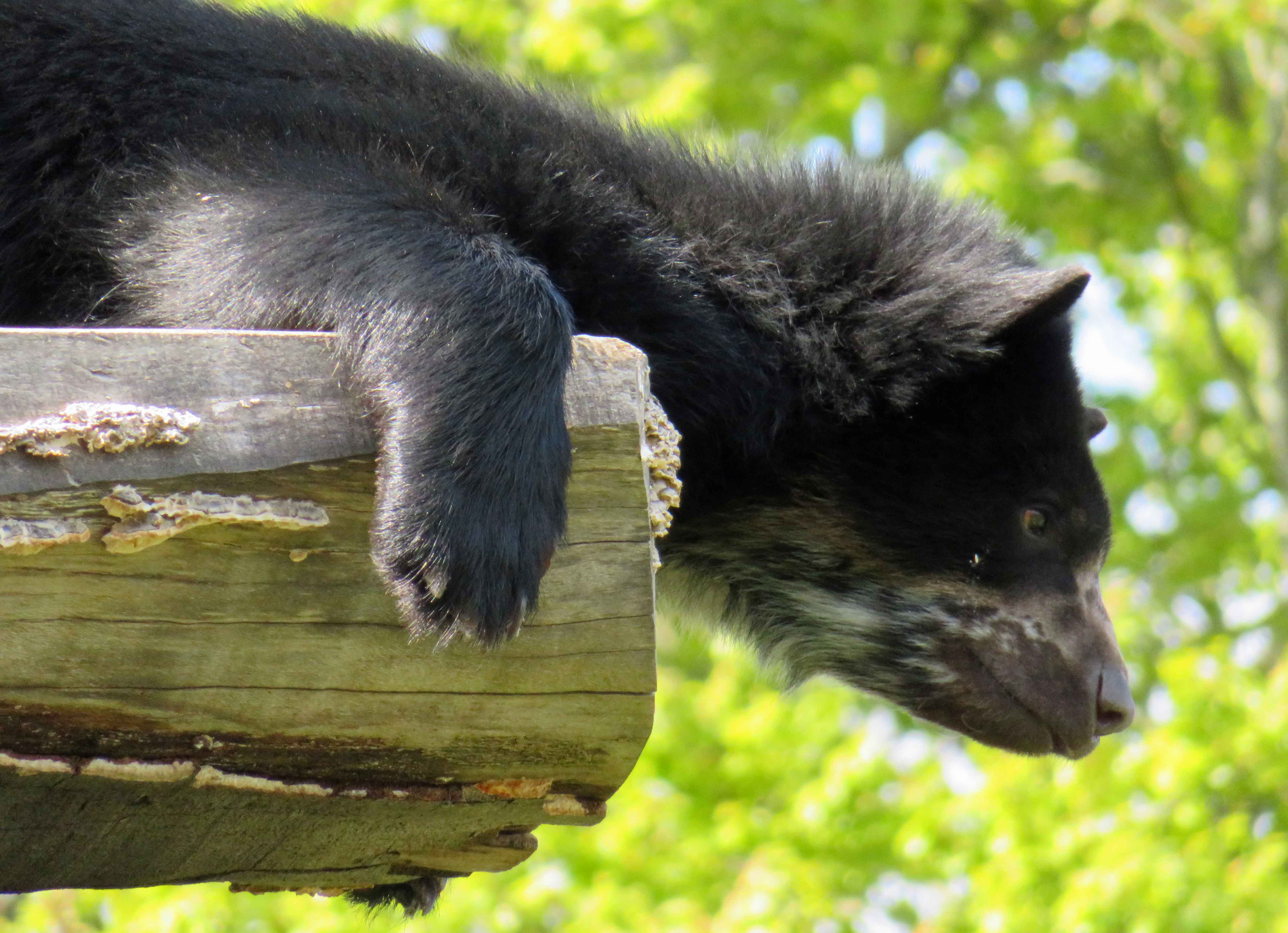
Bahia came to rest on a trunk next to Chui, while Raymi stayed on high.
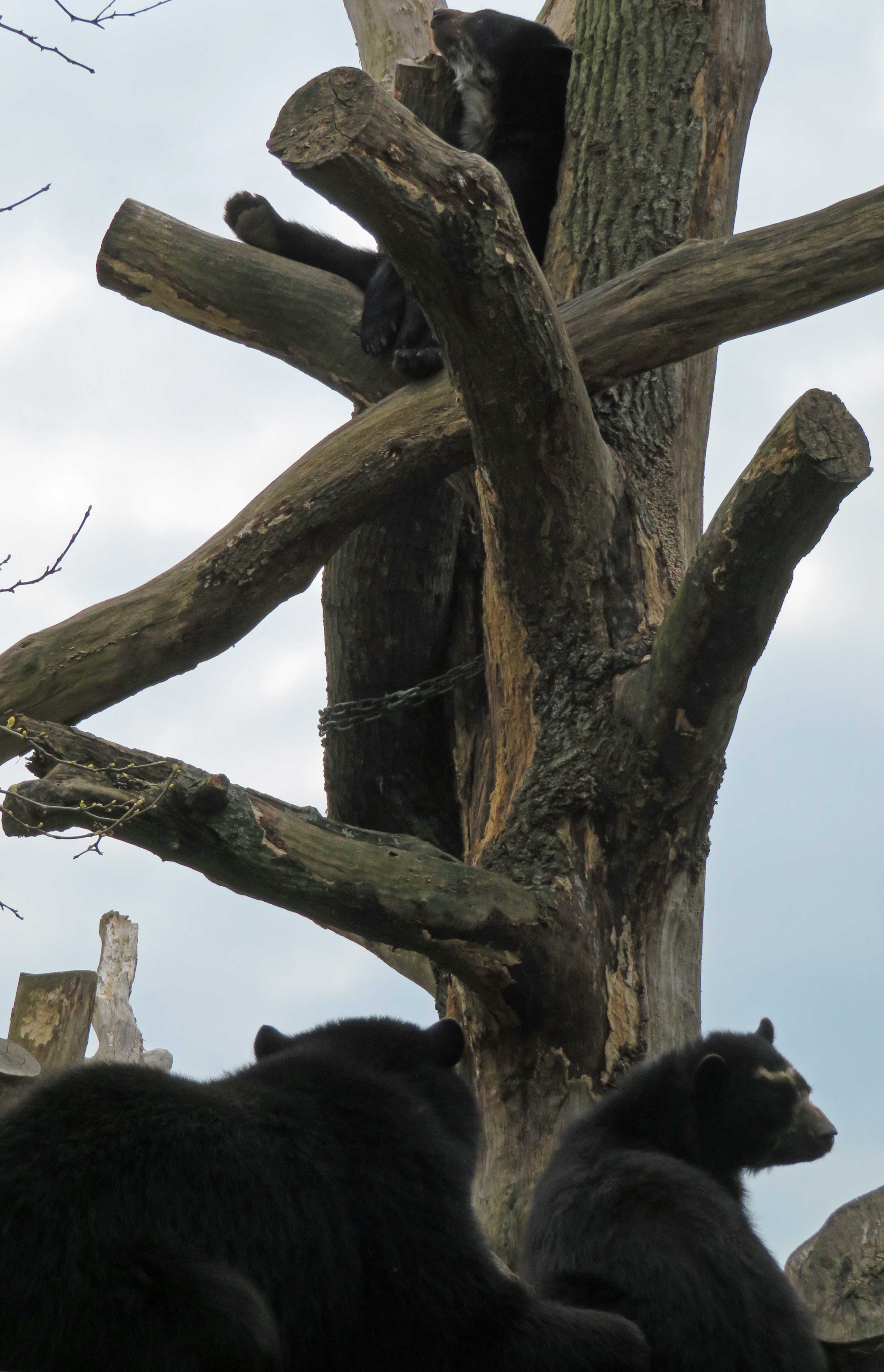
He occasionally looked down, but seemed loathe to risk the descent, with his father was directly below. He wouldn't even come down when Bahia stretched up to encourage him – but then, perhaps she was warning him not to move.
The time Bahia and Raymi spend with Chui is carefully monitored, as he is now growing more aggressive towards his son. Bahia too doesn't tolerate the youngster as much, sometimes pushing him away from her. He's only four months short of the age his parents were when they came to Jersey.
Bahia and Chui are touchingly keen to be together.
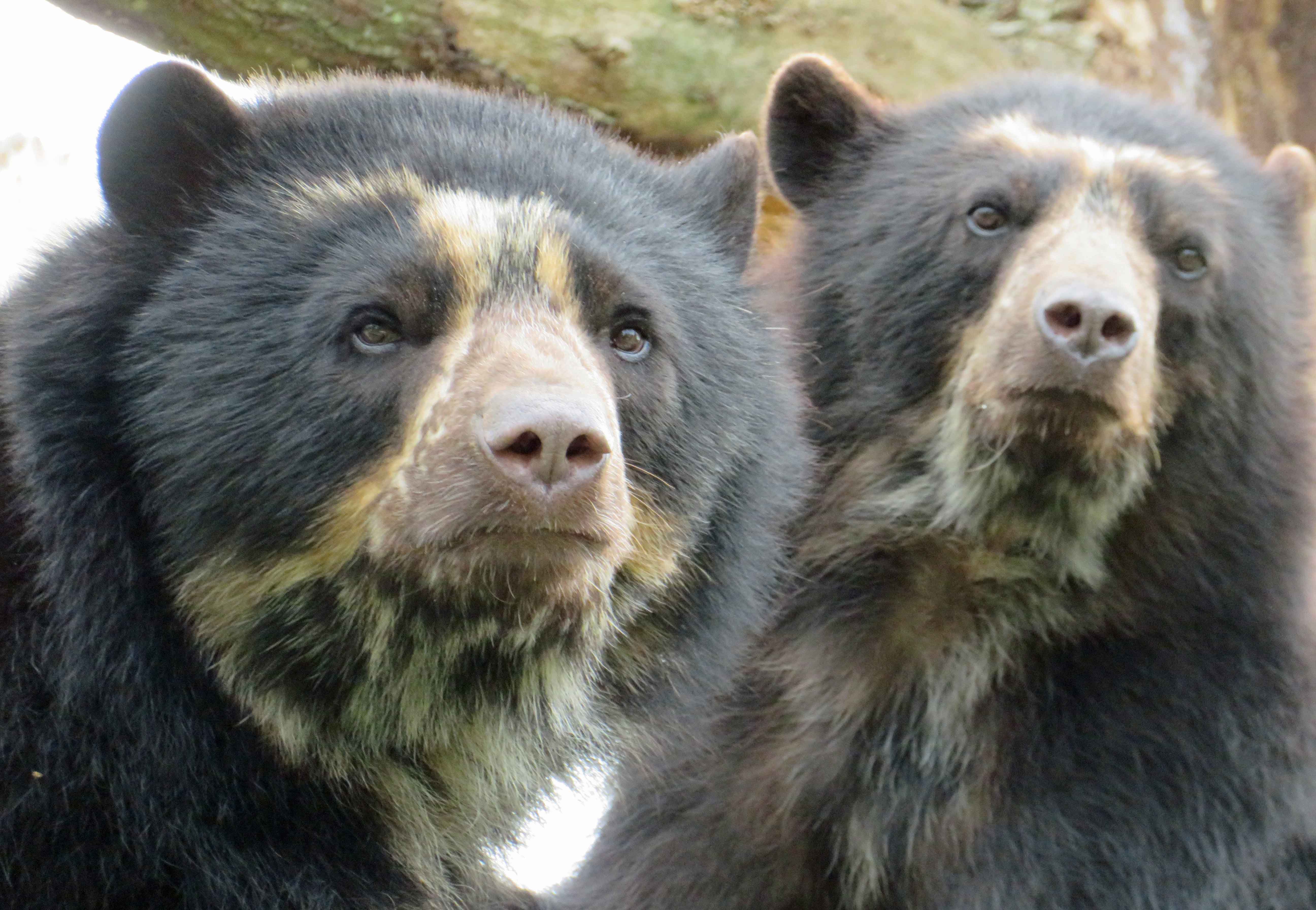
As it’s now the mating season it’s likely they will breed again and hopefully produce another healthy cub next year. A female is hoped for, as that's what the stud book needs most, but whatever it’s gender, as soon as Bahia is pregnant again Raymi will have to be rehoused.
By early evening, Chui was on solitary patrol in the coati outdoor area, eating grass and sipping from the moat.
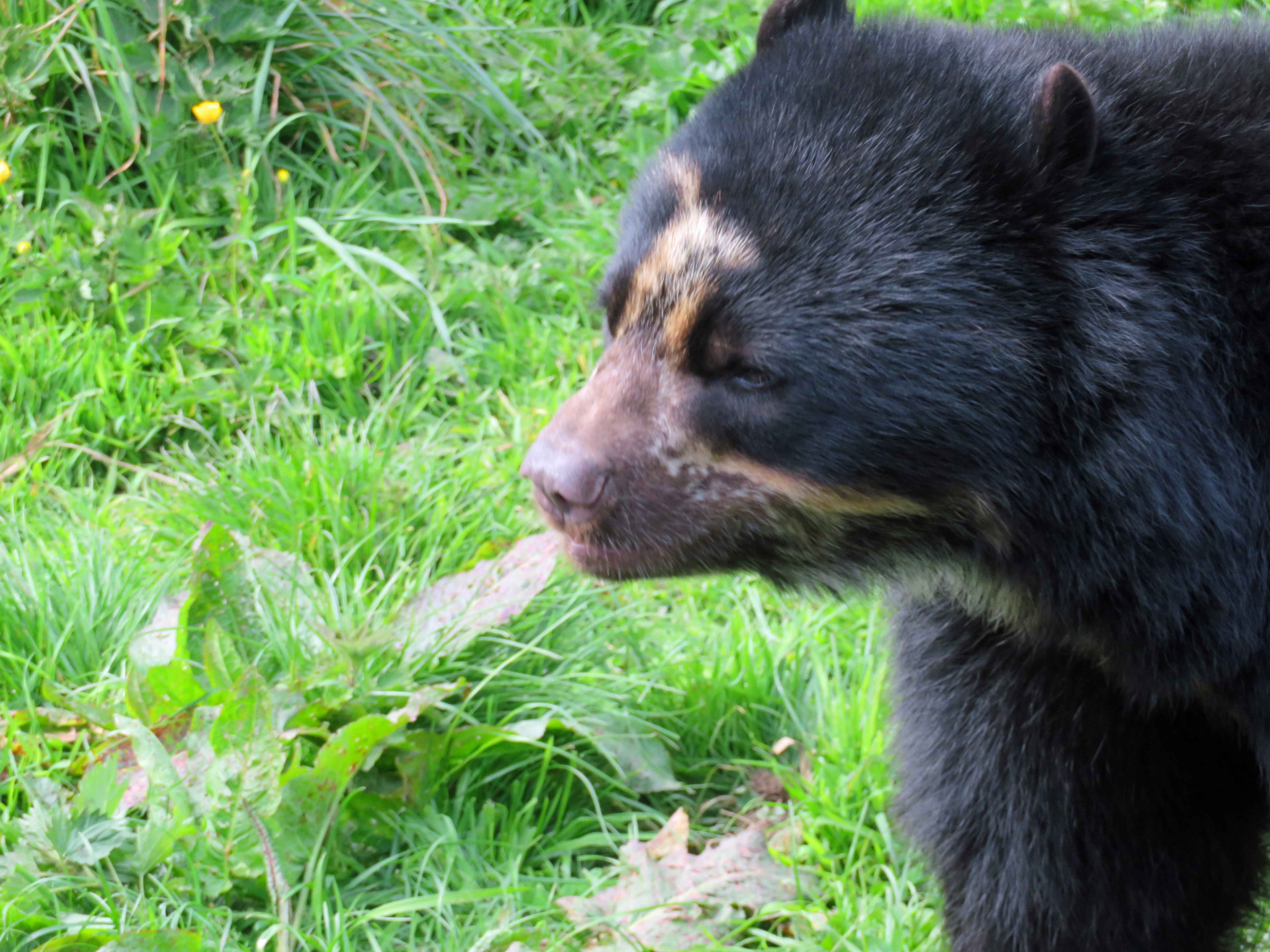
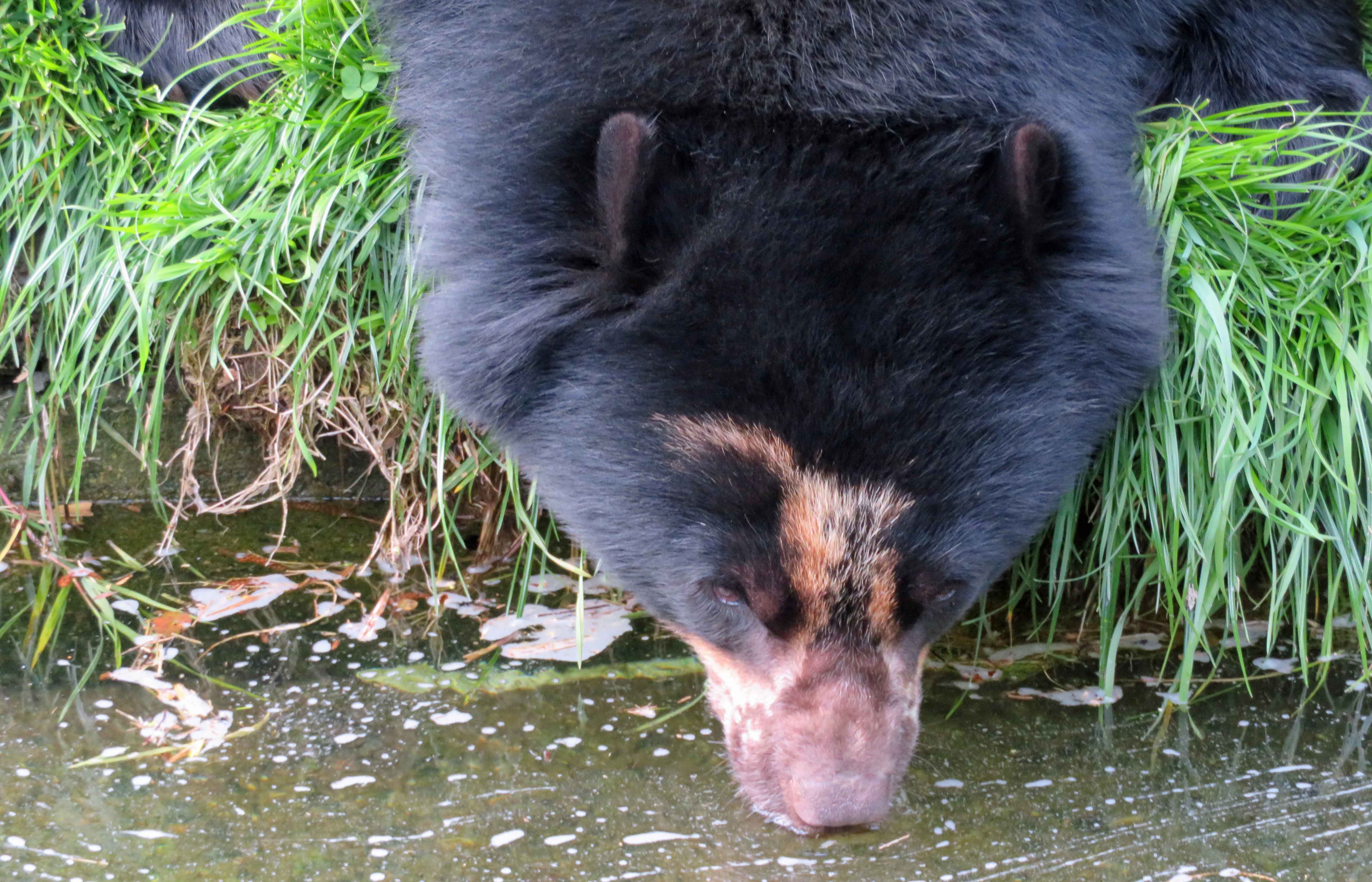
Bahia and Raymi were in the main indoor enclosure, where Raymi was shadowing his mother closely. He stands fractionally higher than her now, although he doesn't weigh as much.
Bahia went up the door enclosure to start making her bed. Raymi followed her and squeezed behind her, not to stay secure as I'd thought, but to mount her, practising what he'd presumably seen Chui doing or just doing what came naturally.
Bahia moved out from under him, and Raymi reverted to babyhood, nuzzling at her until she rolled onto her side to let him suckle. Her tolerance was short, as not only does she have little milk now but he has a fine set of large sharp teeth, so she pushed him away, snapping at him when he persisted. Raymi will need to be weaned soon, ready to move on to his adult life away from his mother.
Soon he’ll gradually be separated from Bahia, as he would have been in the wild. But here there will be lots of enrichments and treats during the increasingly longer times he'll spend away from her, to ease the separation.
7 Give a bear a bone
23 April 2017
Bahia and Chui were in the main indoor enclosure, both with large bones. He was on top of the door cage, holding his bone in his paws and angling his head to bite off pieces, and incidentally showing a fine set of large white teeth.
Later in the morning Chui was wading in the moat near the bridge.
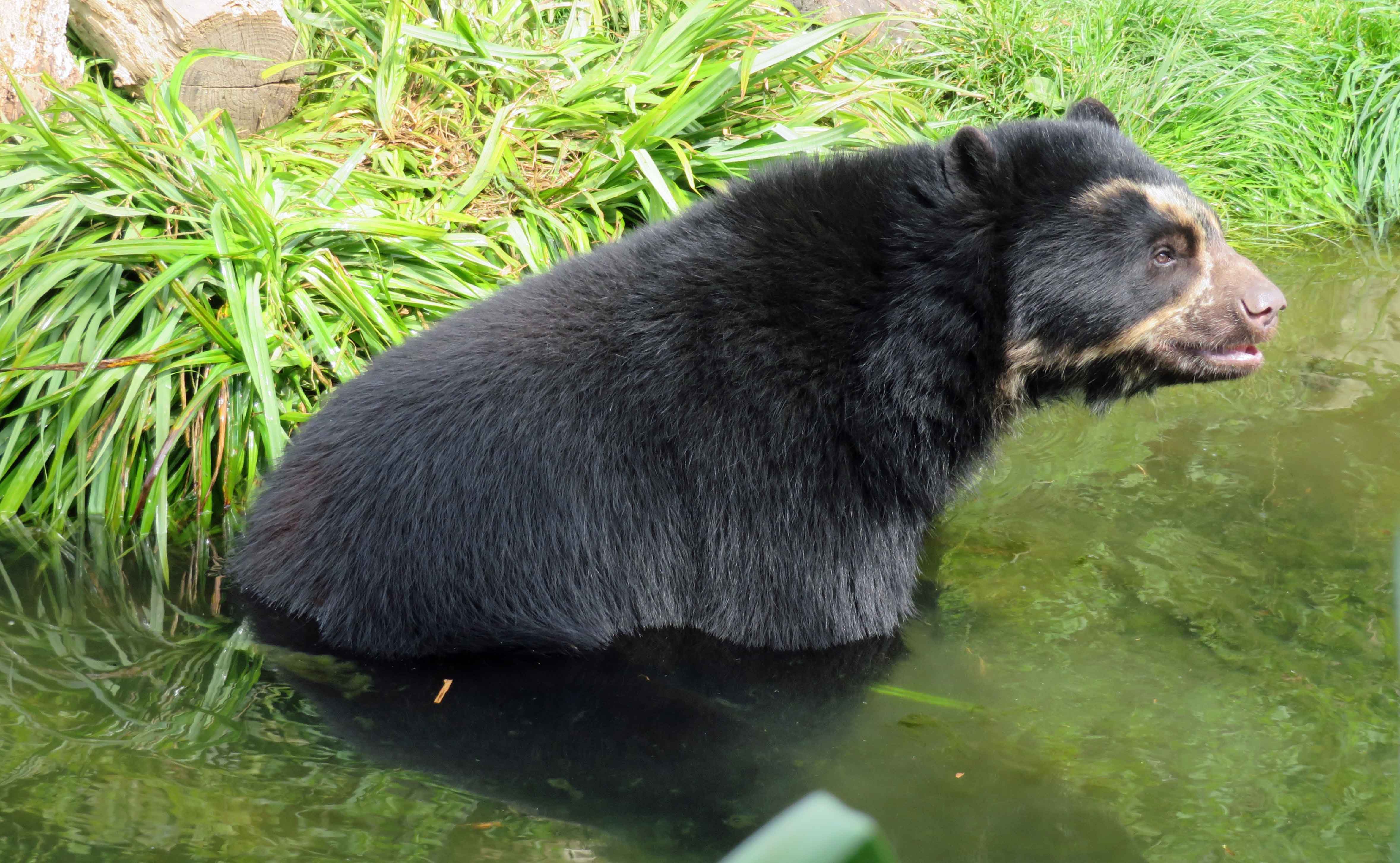
For a while he sat in the water, then attempted to haul himself out over a thick clump of grass.
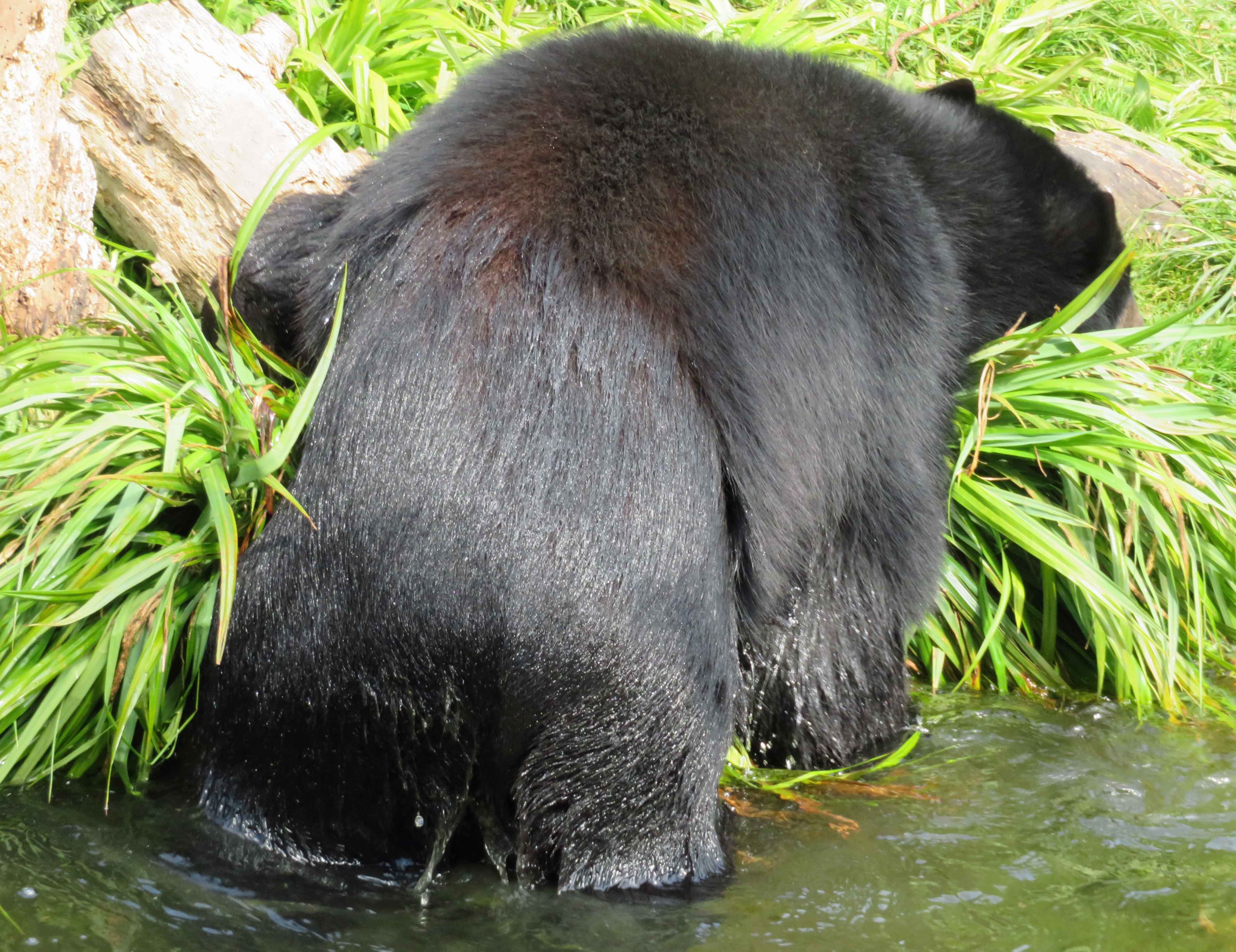
His water-logged fur made it too difficult for him, and he had to wade around to a better exit point. He walked away, water glistening in his coat and dripping off of him, to a tree trunk. Here he turned and stood upright against the trunk, rubbing his back up and down, round and round, presumably to dry off. I did wonder if the belly flopping on grass was actually a means of drying his tummy fur, but this would have got wet again when he waded further on.
Raymi was up a tall tree in the coati outdoor enclosure.
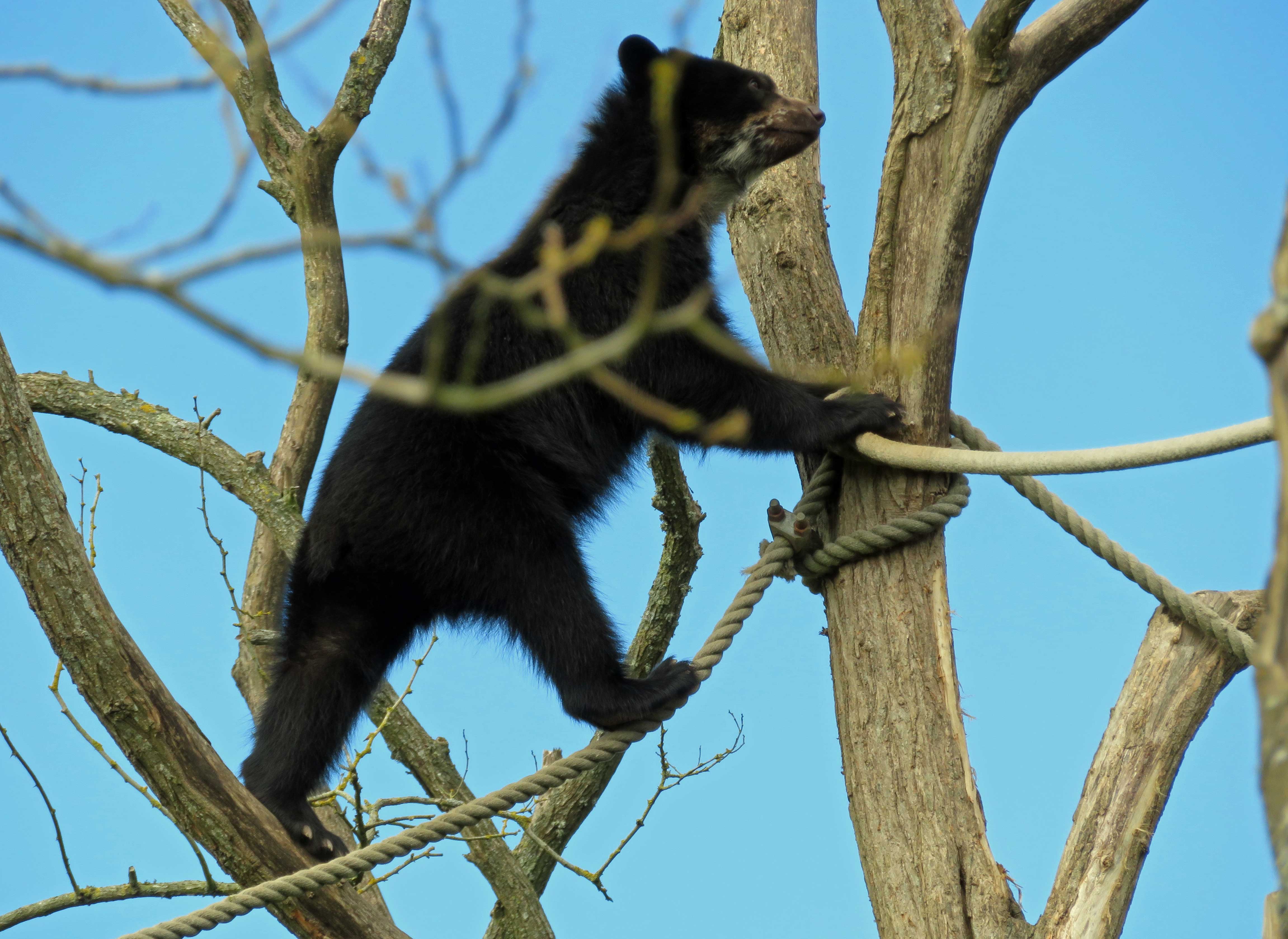
He was climbing along the branches, intent on a purpose of his own, but paused when he saw food being thrown out for Bahia and Chui near the moat. Any thought he had of descending and joining them was soon banished by his father's proximity.
So Raymi gnawed a rope for consolation, then continued further up the tree, right into its slenderest upper branches. He wedged himself into a crook to look round,
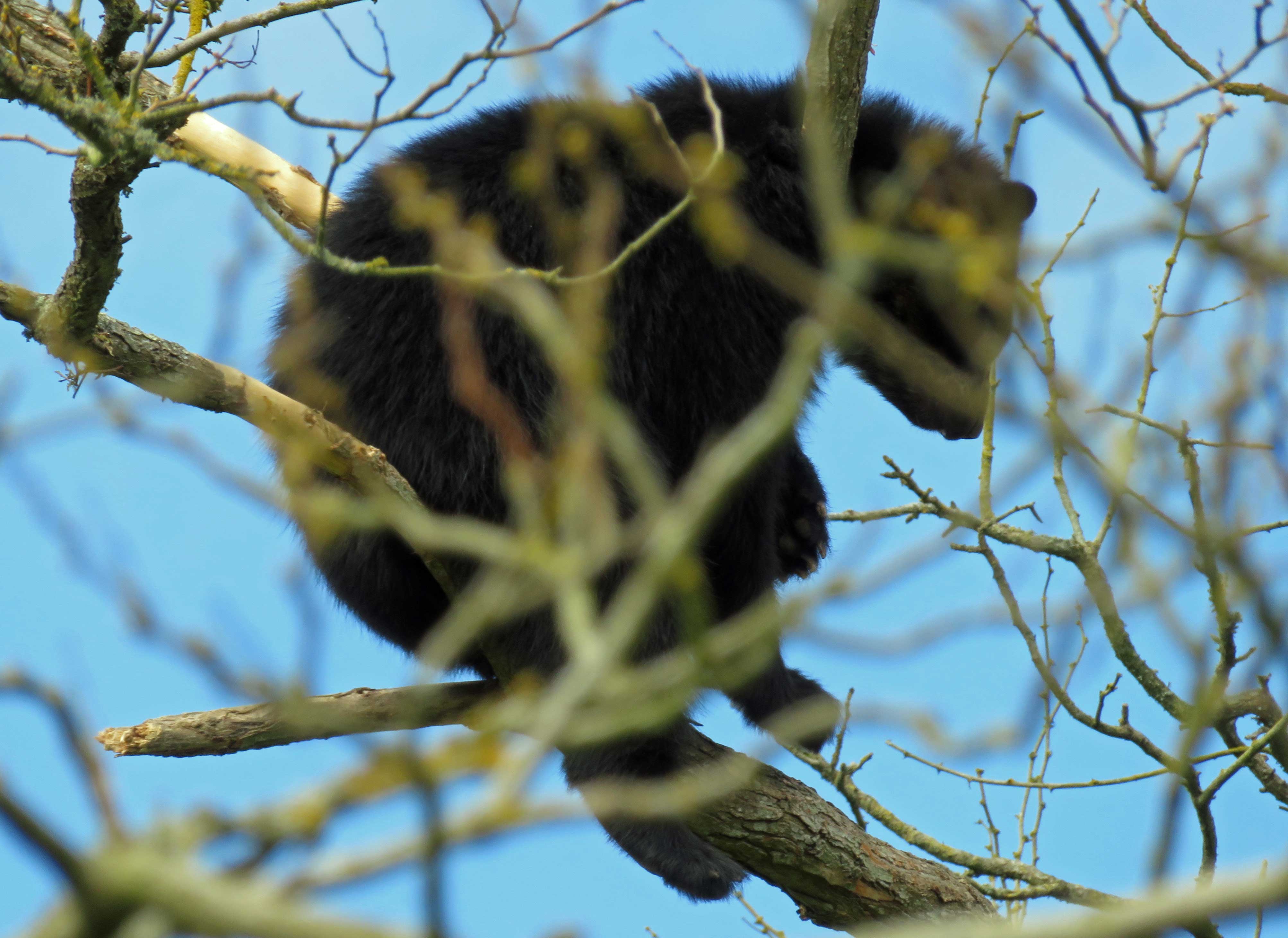
but ventured out almost to the tip of one branch to break off bark, making the branch and even the tree itself shake ominously before he retreated to the crook to enjoy his treat.
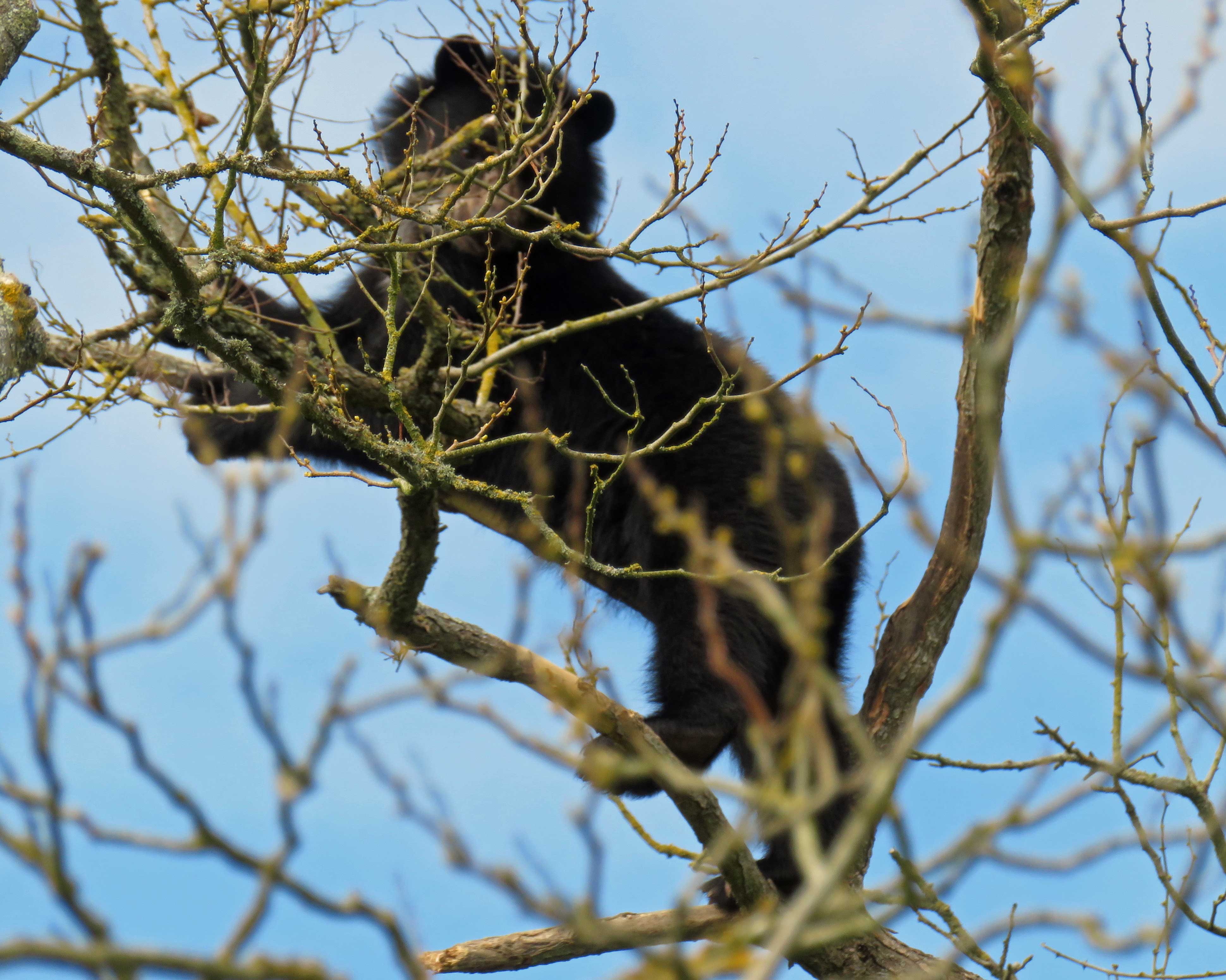
A little later he was resting on a more secure branch, chewing a twig.
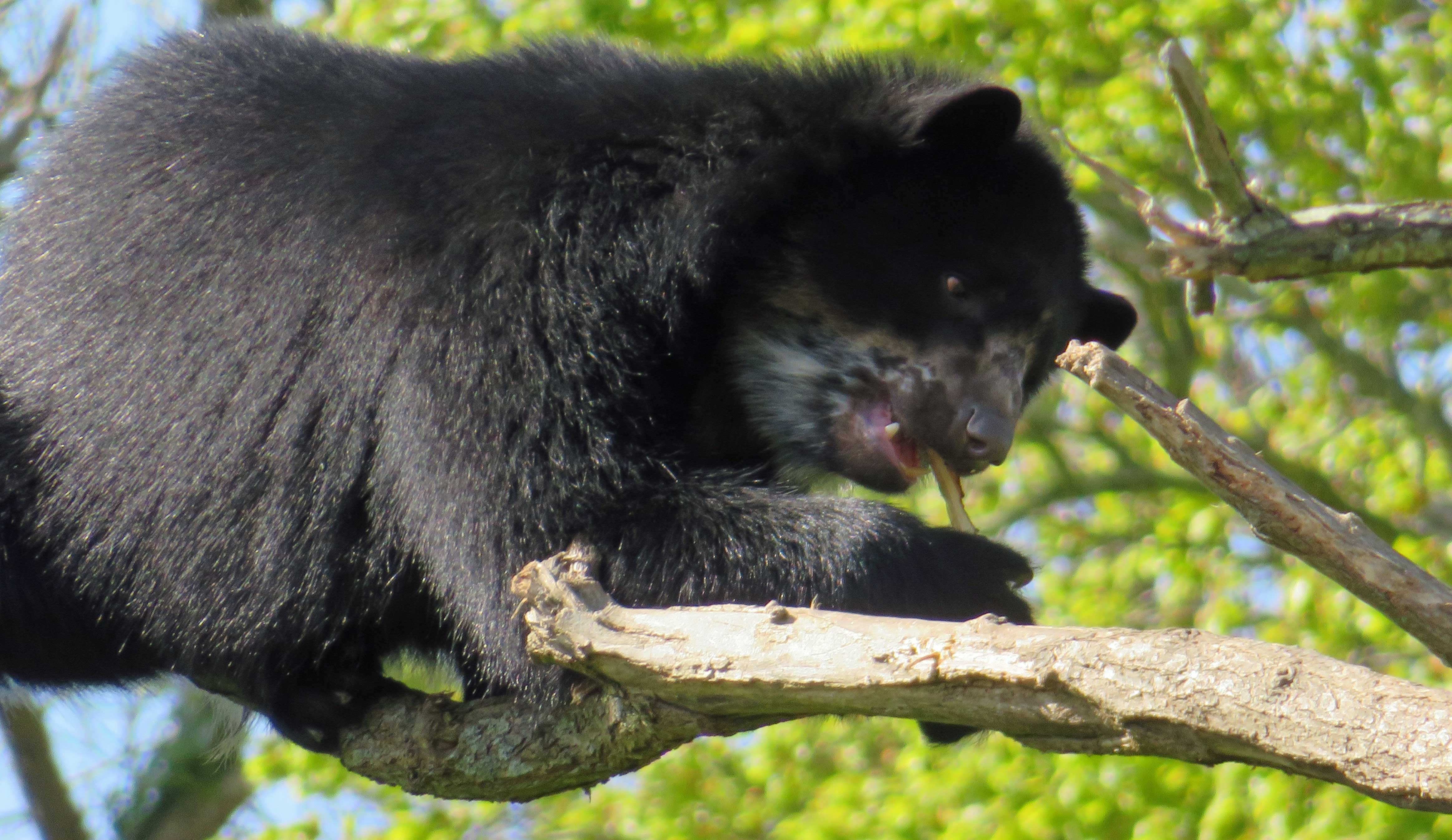
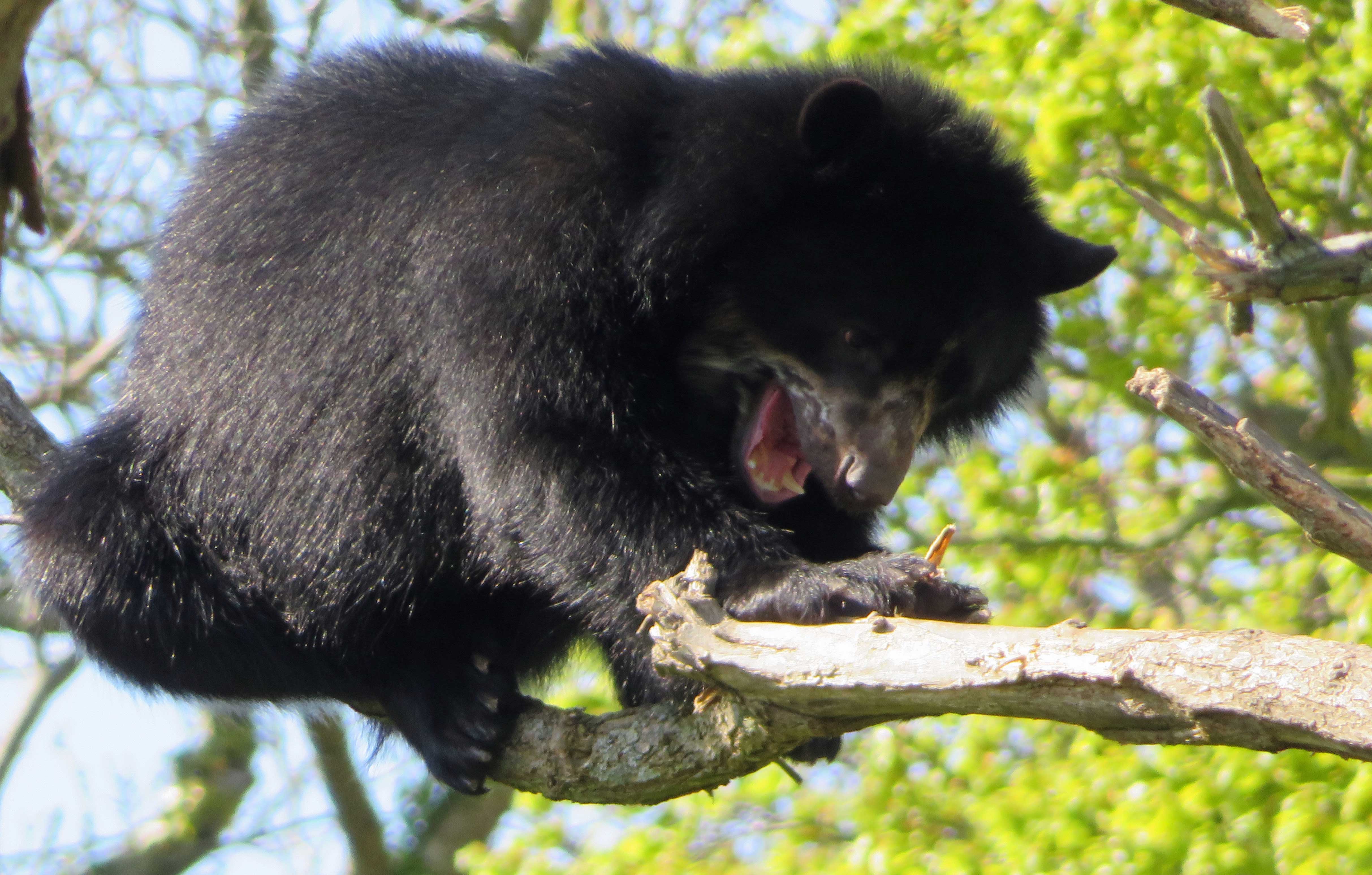
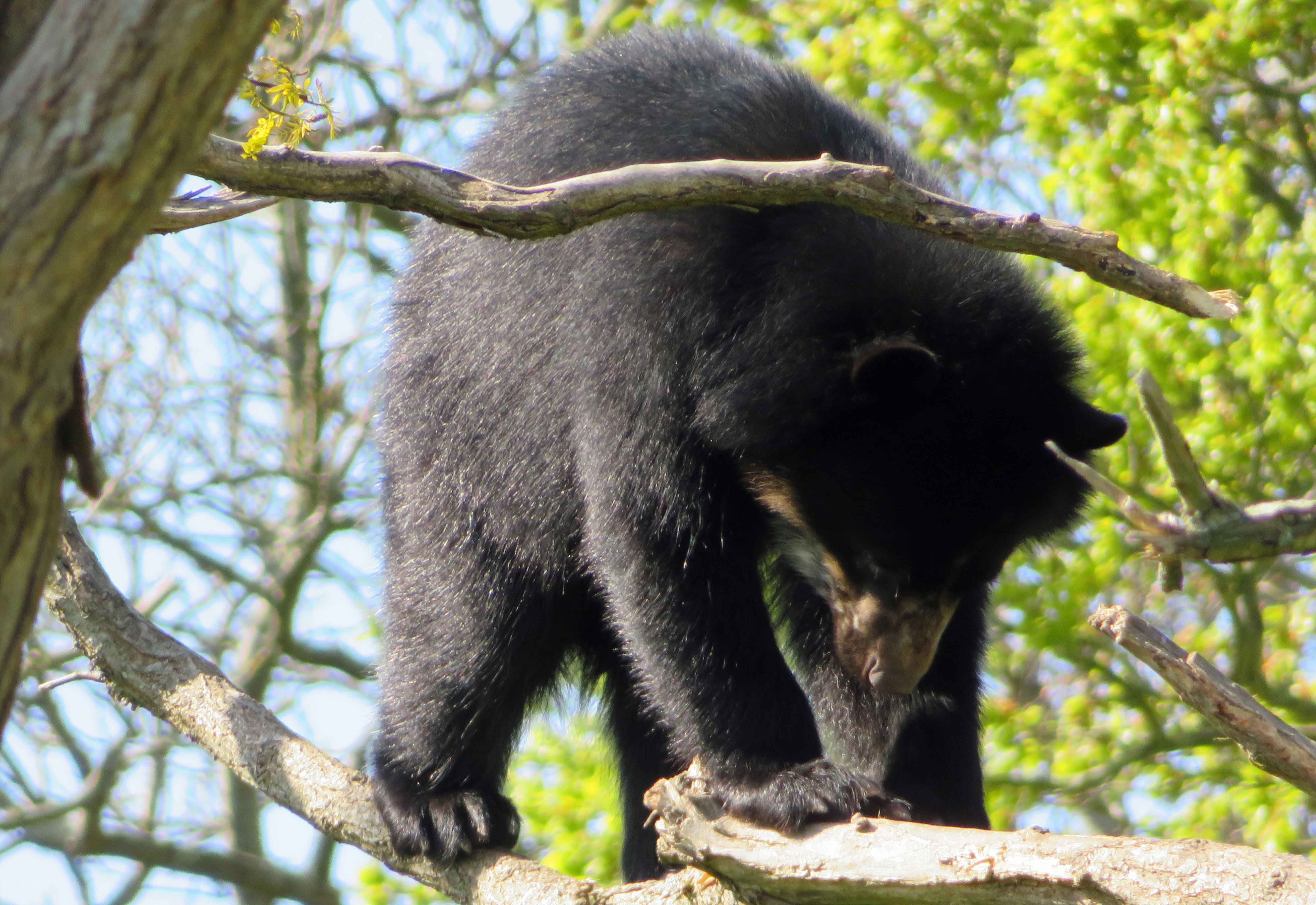
After a while this wasn't enough. Just below his perch was another branch, reaching enticingly upwards. But even when he hung from his back paws and stretched his front ones down he still couldn't quite reach the tips of the lower branch.
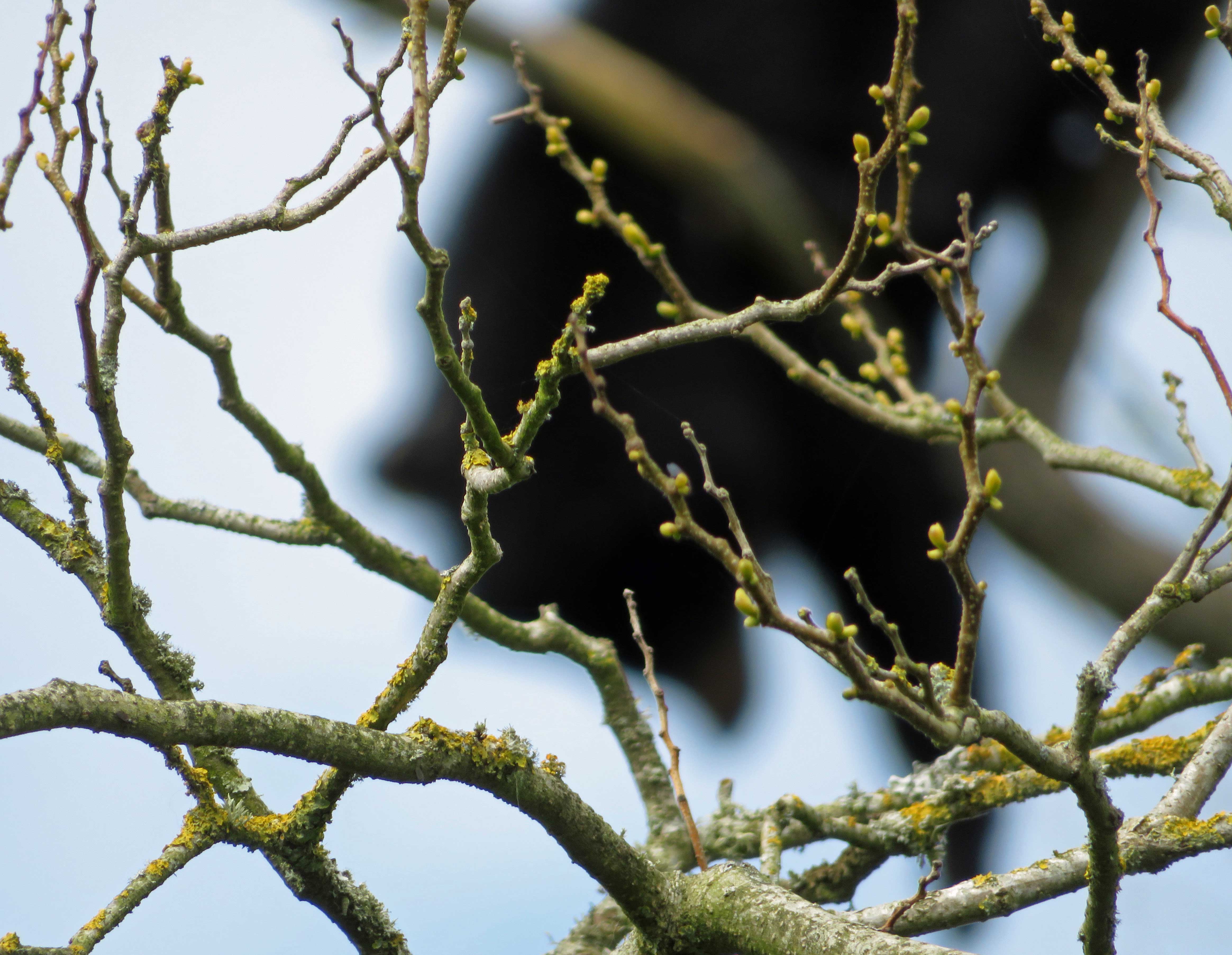
After his exertions he lay limply over the nearest branch letting his legs dangle, rather as his mother does when she has time to doze.
When Bahia had finished feeding and strolled off, Raymi considered descending to join her, but Chui soon followed Bahia himself
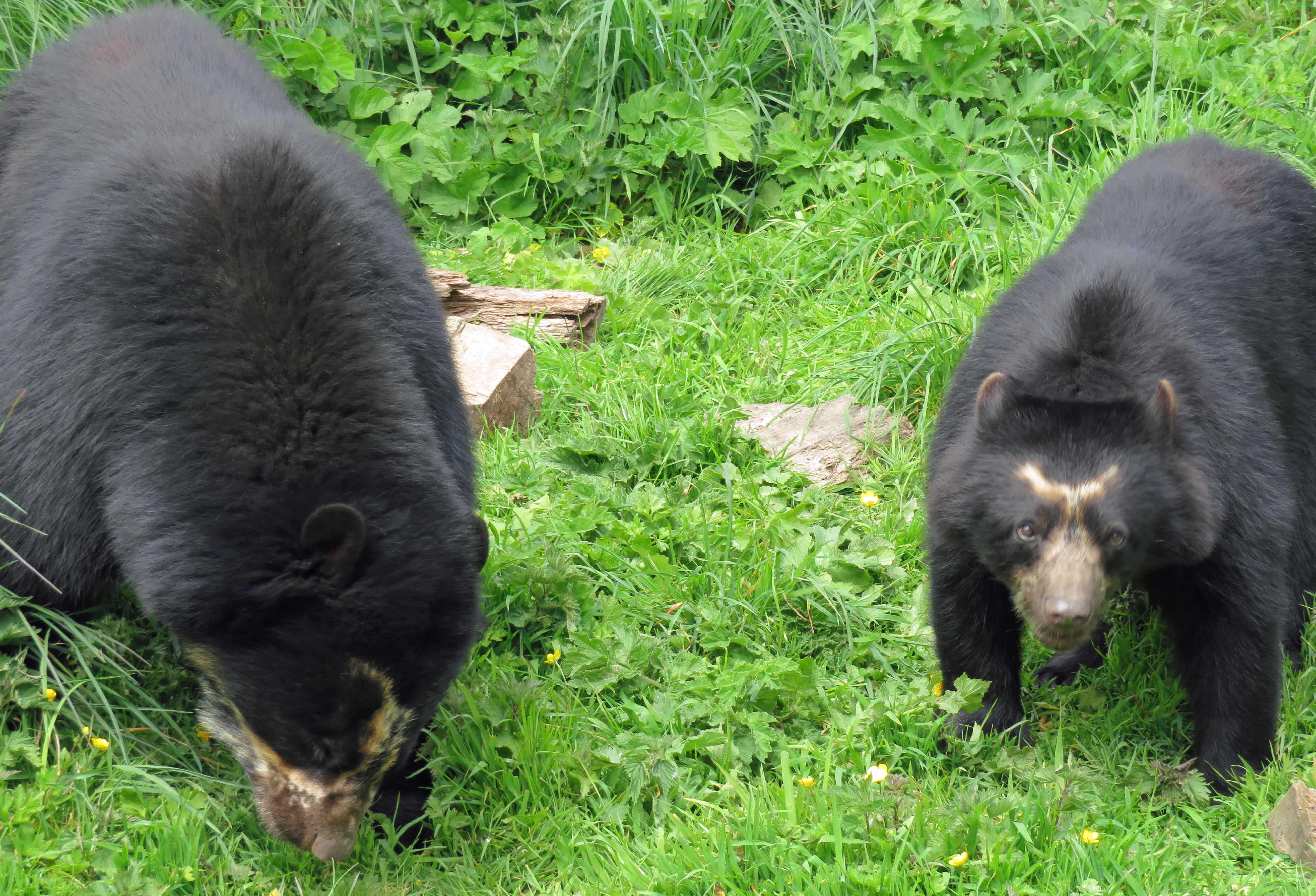
so Raymi froze in his descent.
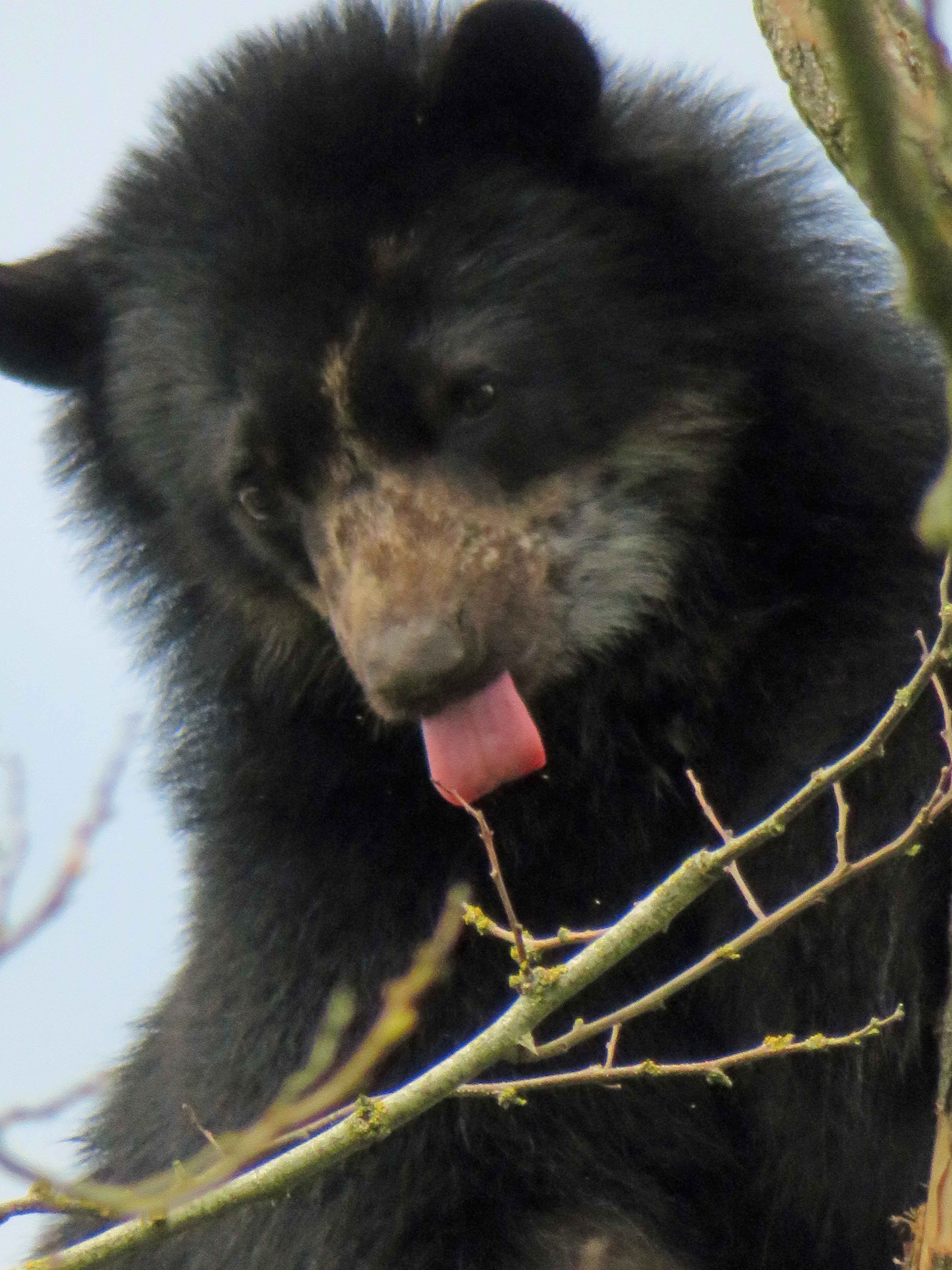
Bahia came to sit close to Raymi's tree, just her face visible in the long grass as she looked up at him. But the youngster wouldn't come down as Chui came to rest nearby too.
Later, Bahia led Chui away, round the back of the house and Raymi began to descend again. But she was soon back at speed, with Chui on her tail, dragging her back and mounting her. She squealed and wriggled away, but Raymi, after a brief hesitation, decided not to come down yet and began to climb again. Bahia and Chui parted company, she wandering off and he sat down near Raymi's tree, preventing the youngster's escape.
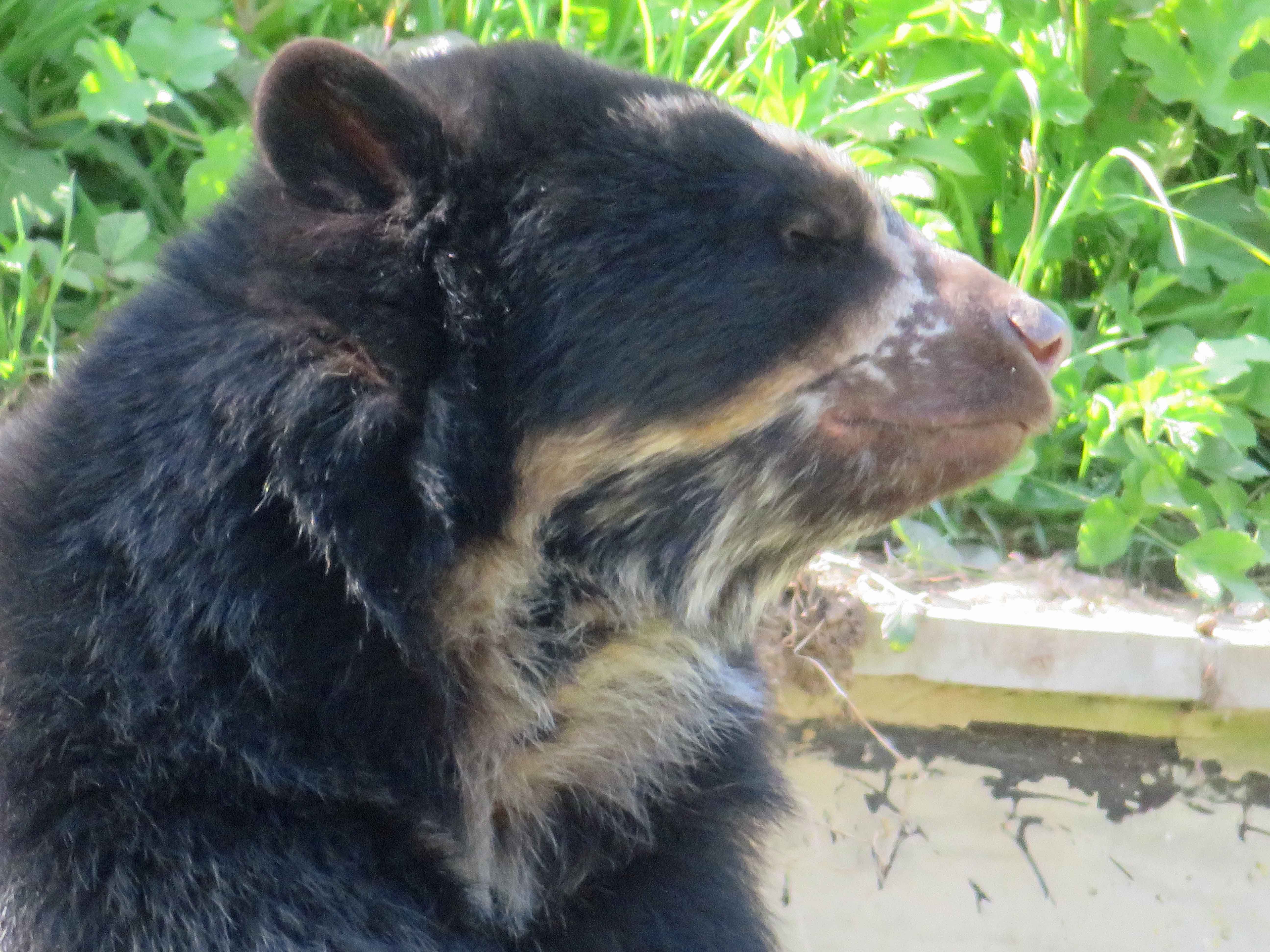
Bahia and Raymi were in the main indoor enclosure, generally on top of the door cage, hanging head-first over it to peer at what the keepers were doing. Bahia would climb down the angled tree trunk, onto the box below the door and cross the floor to the caged door. Here she stood upright, trying to get a better view. Sometimes Raymi came with her, sometimes he stayed behind and looked down on her from on high. When he got his first titbit she tried to climb up to see what it was, but he pushed her back and carried on eating. She went back the long way and joined him to share his hard-boiled egg. The intense interest in supper preparation may have come from the smells the bears had picked up, as well as their awareness of feeding time.
8 Family dynamics
24 April 2017
First thing this morning Bahia and Chui were lying together head to head on the low front trunk, with Raymi perched above high above them.
The adults lifted their noses, perhaps for the scent of baking croissants drifting over from the nearby café.
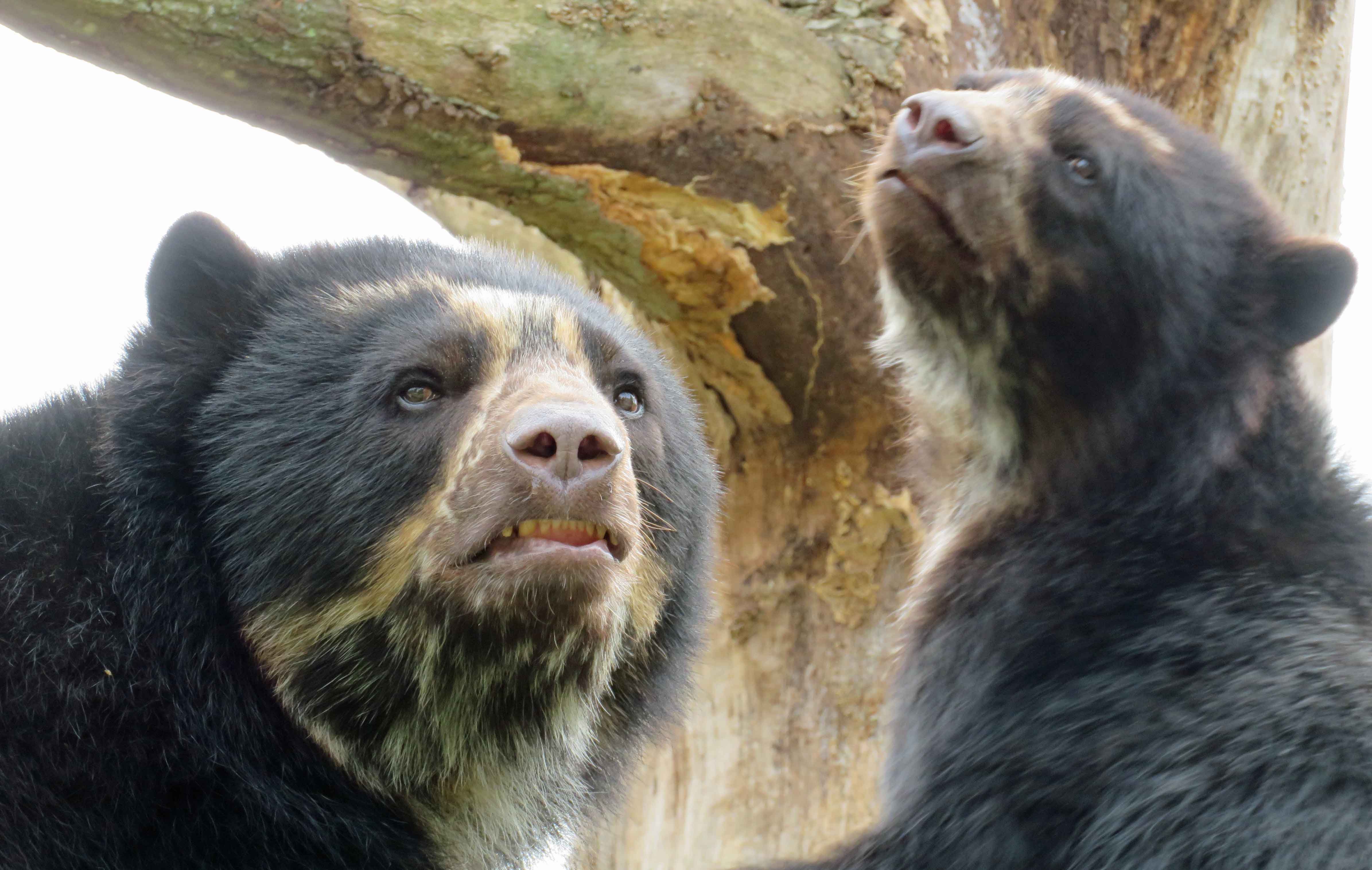
Chui nuzzled Bahia, who batted him away irritably.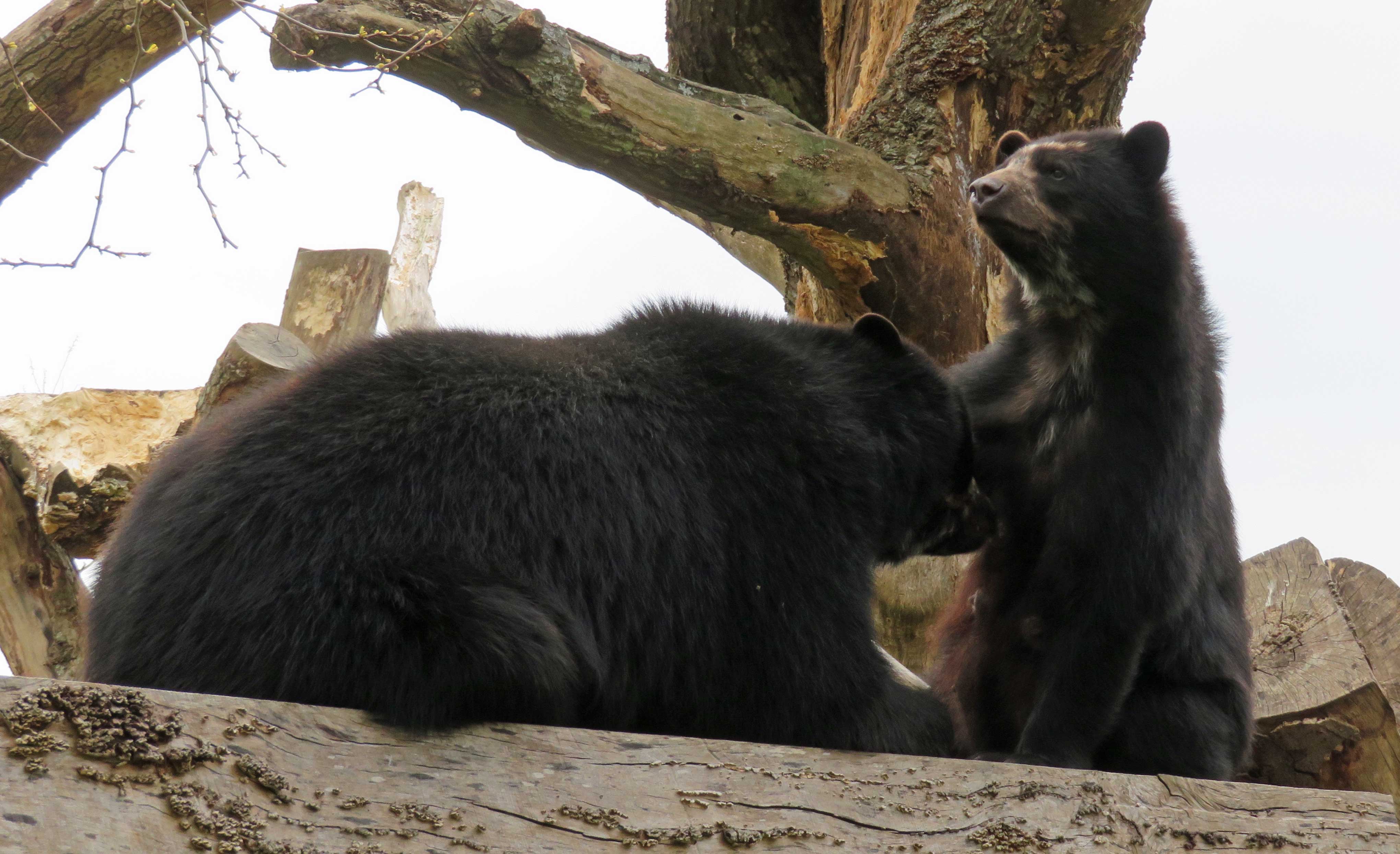
She got up and moved away, walking across the trunk behind theirs, with Chui right behind her
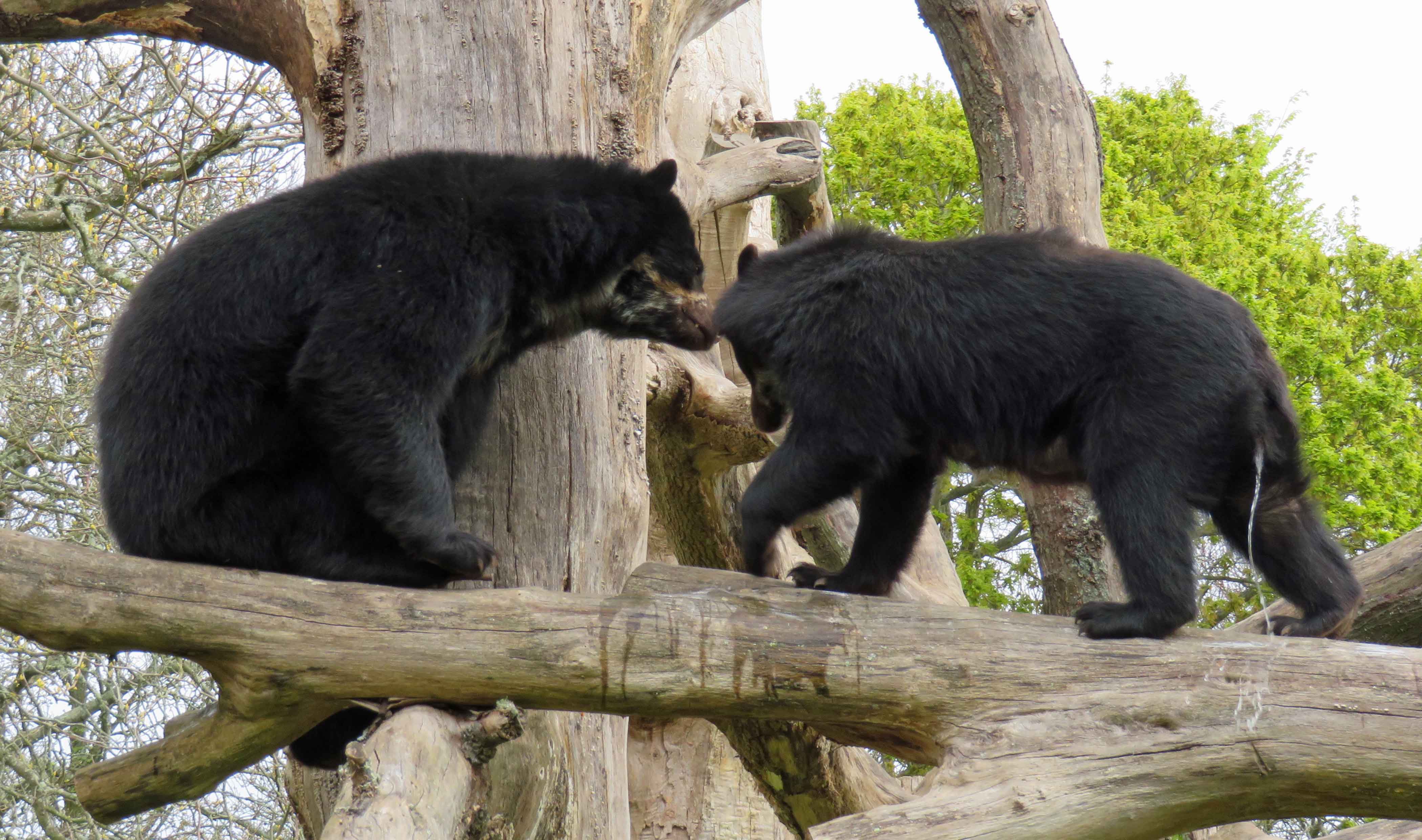
and Raymi fidgeting above,
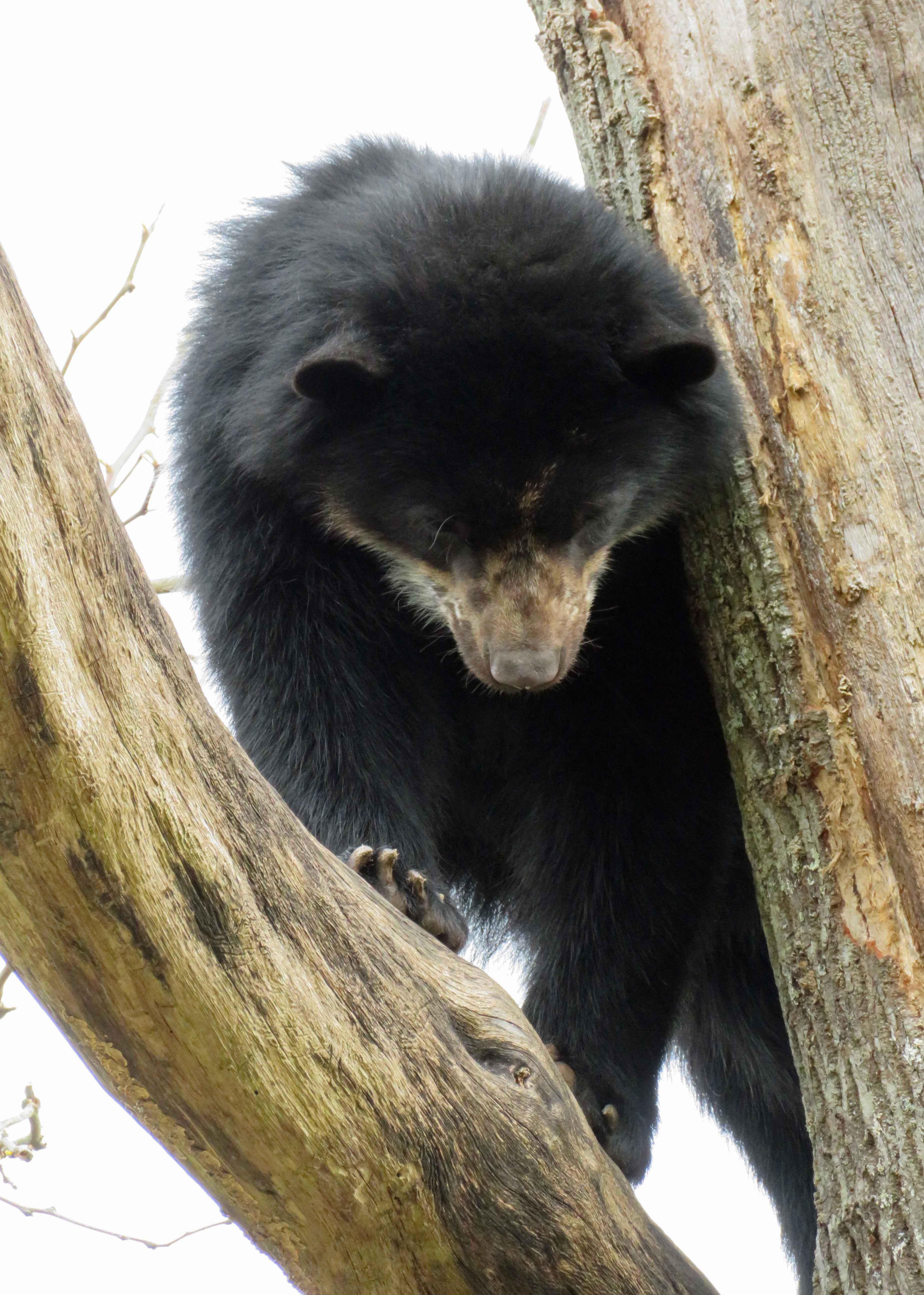
wanting to follow her but not daring to trespass near his father. Bahia turned back, forcing Chui to retreat until they were beneath Raymi's tree trunk. Both adults stood up, stretching high up the trunk. Bahia began to climb, and Raymi ventured a short way towards her, but she turned aside along another horizontal trunk. Chui went away in the other direction and soon there was a bear at each point of a triangle of tree trunks.
After the afternoon food had been thrown out, Bahia chased off the pair of mallards that swim on the moat when they ventured out to share the snack. It wasn't a particularly aggressive chase, as she didn't really put much speed into it and the ducks had plenty of chance to slide back into the water and out of reach.
Later, Bahia was tempted to walk across the top of the moat waterfall, but Raymi pushed her out of the way and tried it himself. He kept his back feet firmly on the ground and slid some way forward on his front paws, before deciding it wasn't such a good idea. Bahia made a desultory attempt to do the same, but wasn't really interested so didn't go far.
In the late afternoon, Bahia went indoors to fetch Raymi for their supper – sections of fruit today. She prefers corn on the cob, he likes melon – they each took their favoured piece away, higher up the island. Bahia finally took hers indoors onto the door cage, and when Raymi joined her she let him share it. He kept pushing her with both paws, trying to get her to roll over so that he could suckle. She ignored him for a time, until at last she gave way and rolled back, her head resting on the cage edge, her eyes looking down at me.
9 Keeping out of the way
26 April 2017
Lunching at the zoo cafe I could see fast-moving flashes of black fur in the vegetation bordering the bear house. One flash moved to the left lower down the bank of greenery, then shortly afterwards there were two flashes coming back higher up the bank. I couldn't see who they were. Raymi was one of them, but the other could have been Bahia playing with him, but was more likely Chui chasing him.
After the second set of movement there was a thrashing in the willows in front of the bank, which seemed to involve Chui, and probably Bahia. I couldn't see what they were doing, but guessed she had got between him and the youngster and turned his mind to mating. When Chui came back into sight he stretched at full height against a trunk and rubbed his back on it.
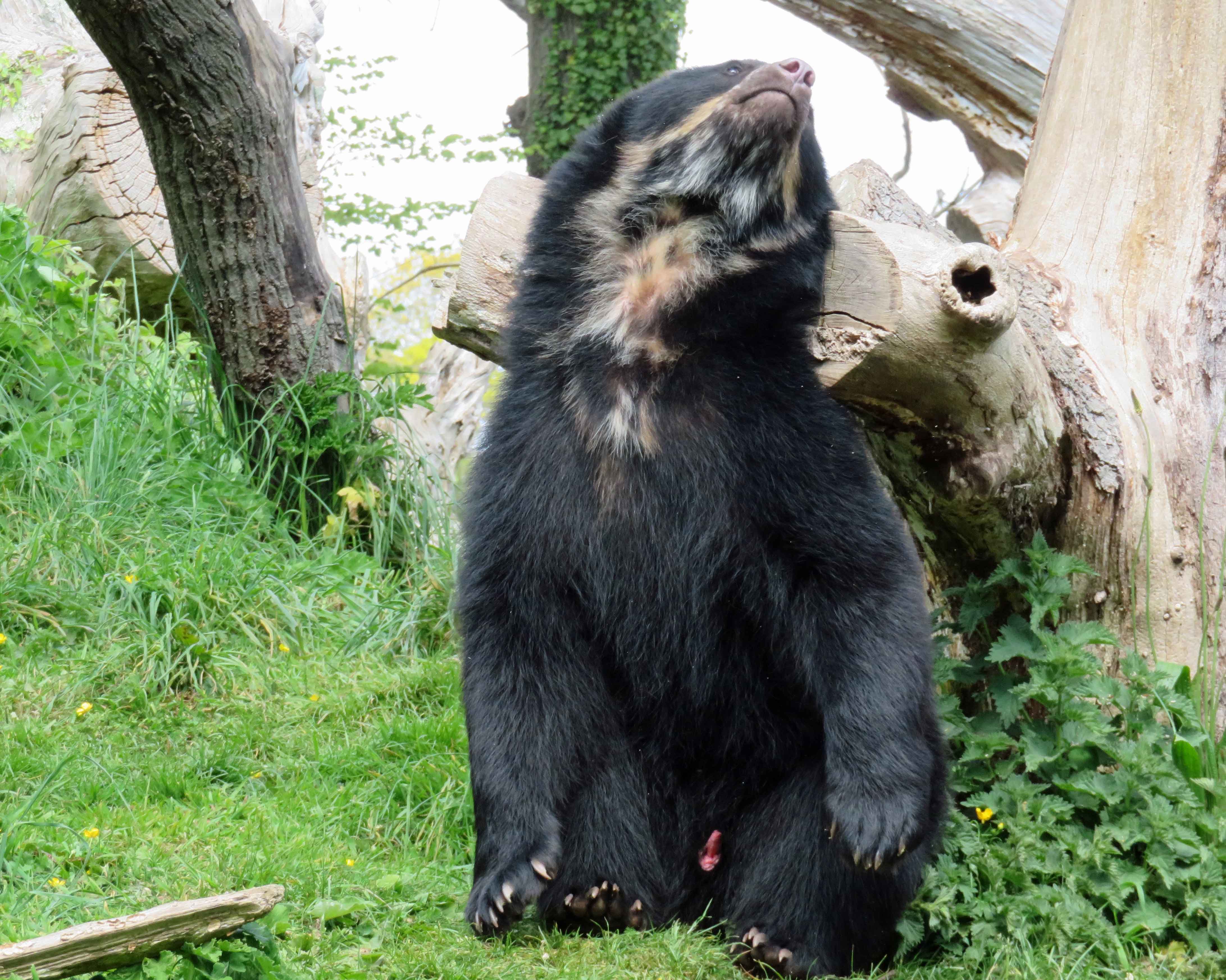
Later, Bahia and Chui were indoors, side by side in the inner doorway, Bahia's paws clasping her beef bone. She went outside, followed at once by Chui, who got along the path through the rocks ahead of her and stopped to face her, bouncing up and down on all fours. Bahia's main response was to bat at him with her paws.
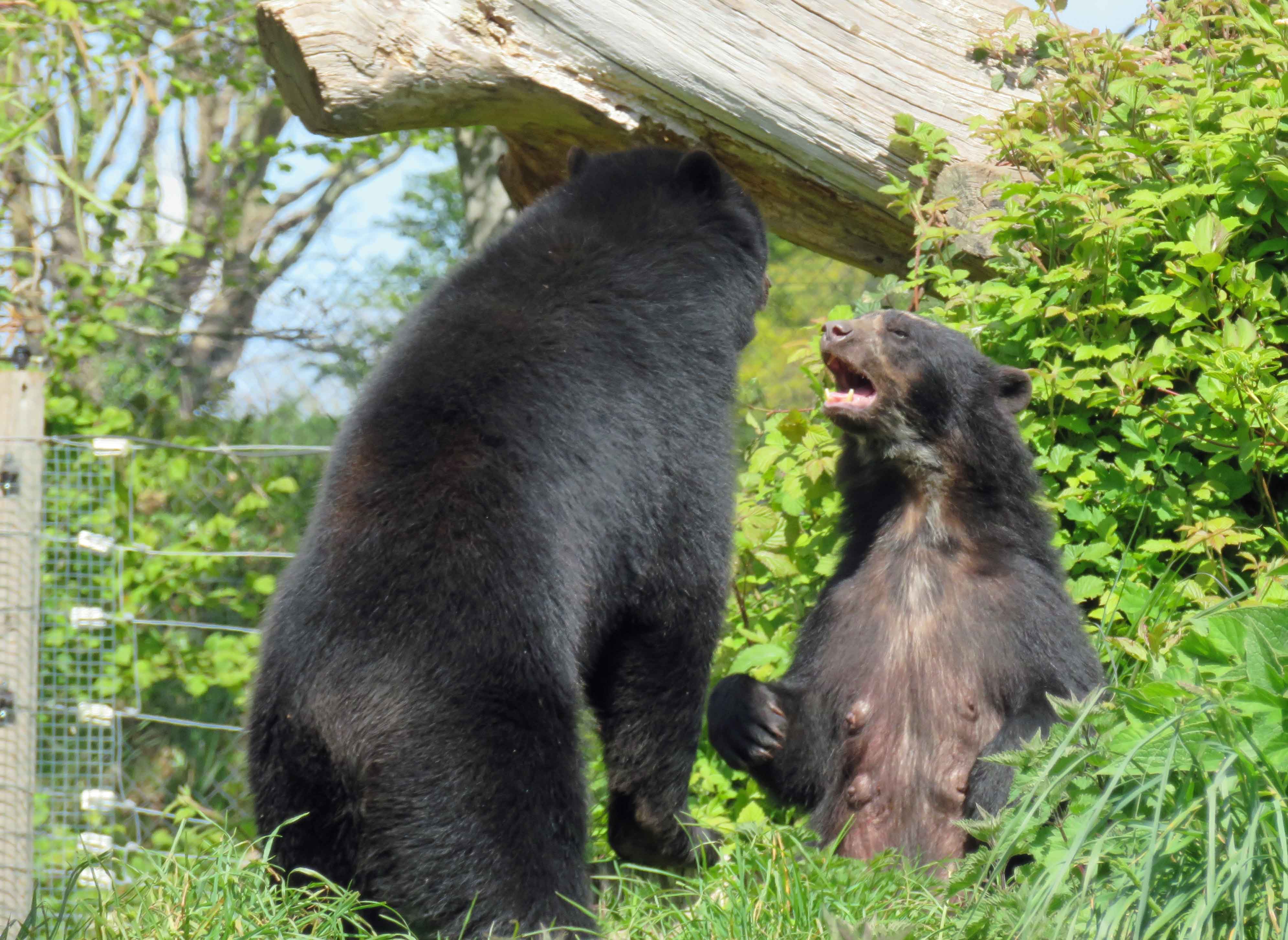
Then Raymi came into sight, Chui raced at him and Raymi ran up a tree. Bahia got between him and Chui, who grabbed her and mounted her. She glanced up at Raymi as if to say 'Look what I suffer for you' or 'Stay there out of the way'.When the mating was over Bahia and Chui grazed together,
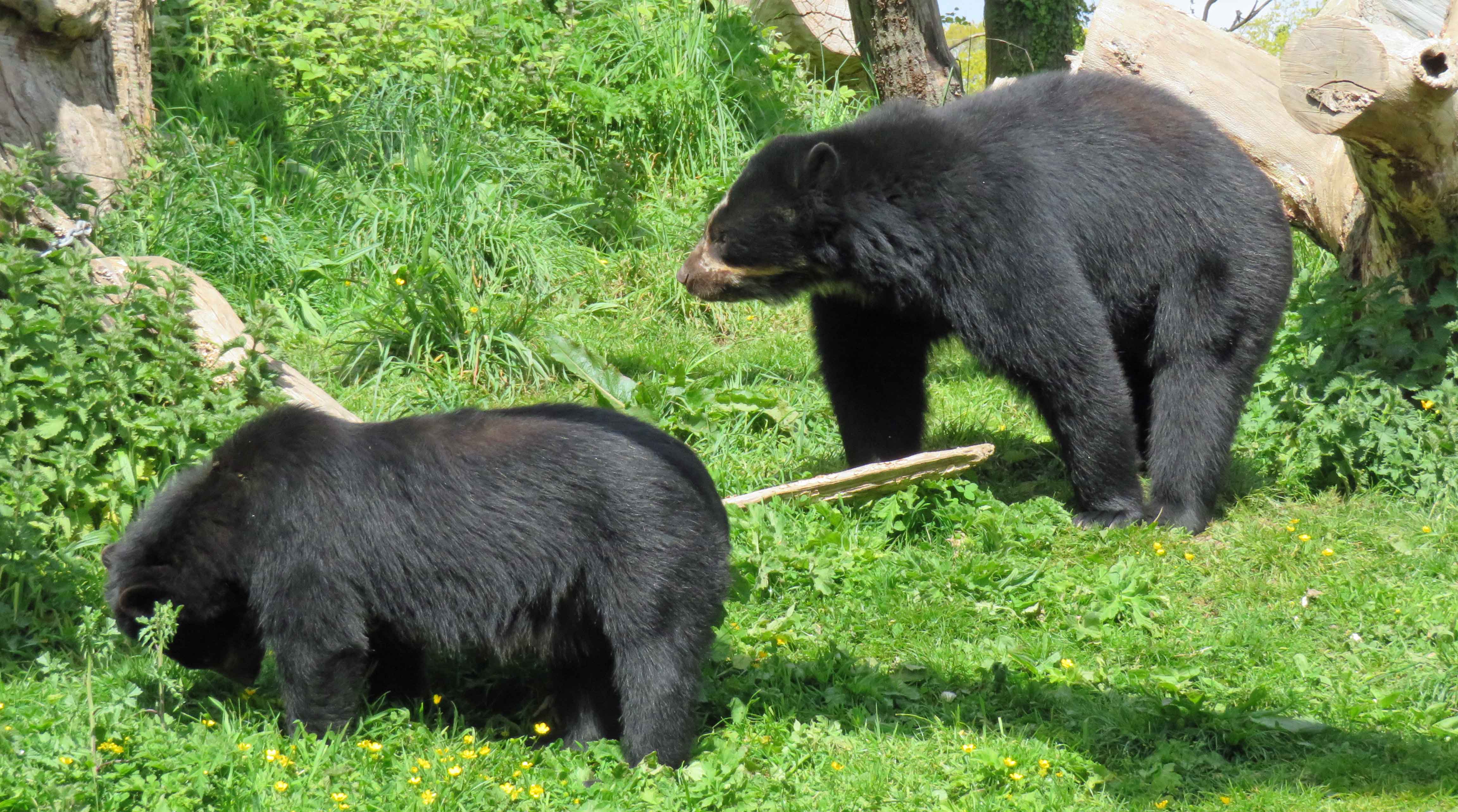
gradually moving away from Raymi. Bahia went indoors and Chui went off round the house out of sight. Raymi watched him
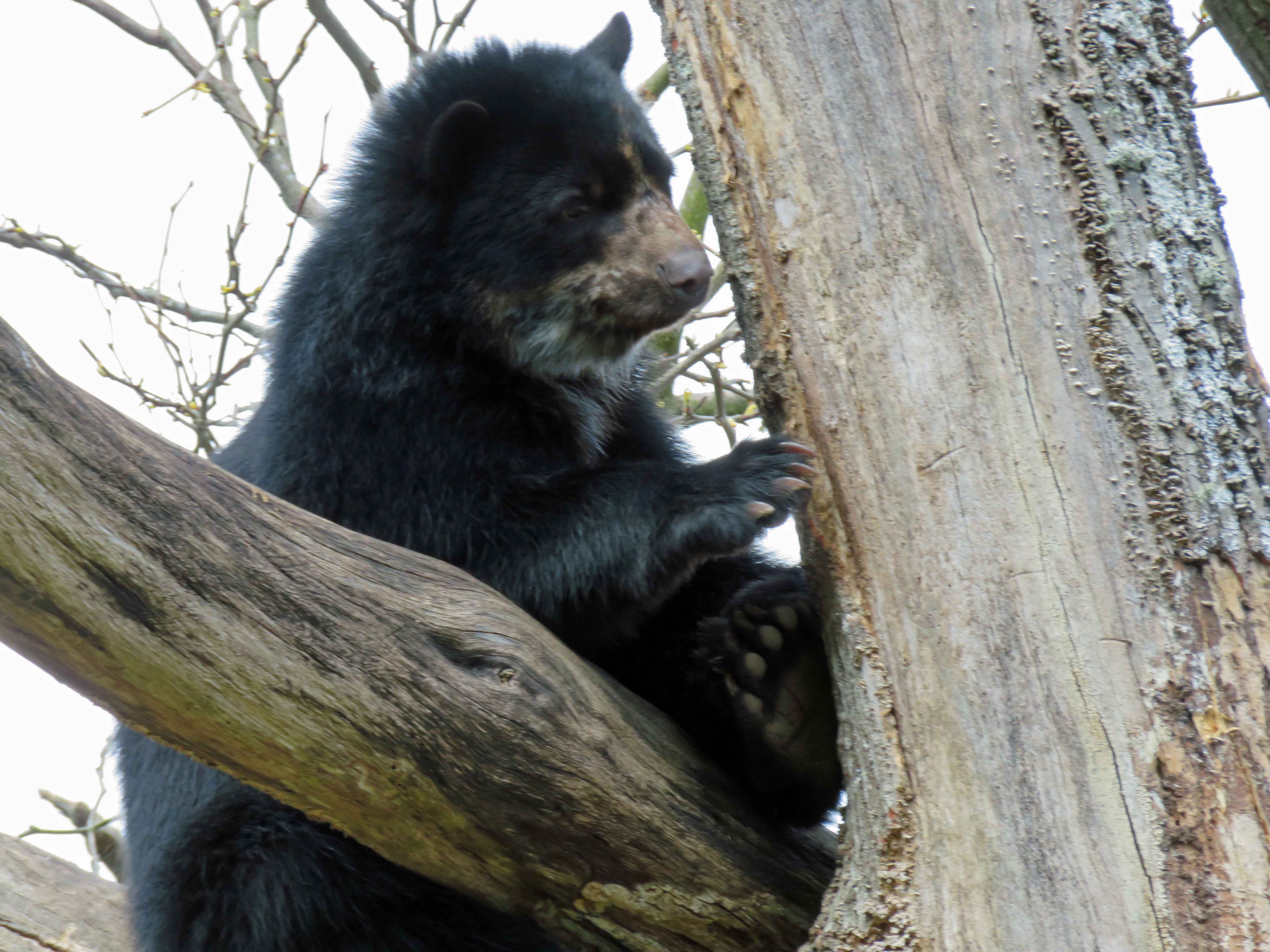
and began to come down. Bahia came out to look for Raymi, and Chui came back just as they went indoors. A little later Bahia and Chui were again settled together inside on the floor in front of the door cage, but there was no sign of Raymi indoors.
10 Yet another afternoon up a tree
26 April 2017 continued
By late afternoon, Raymi was up a tree on the far side of the island,
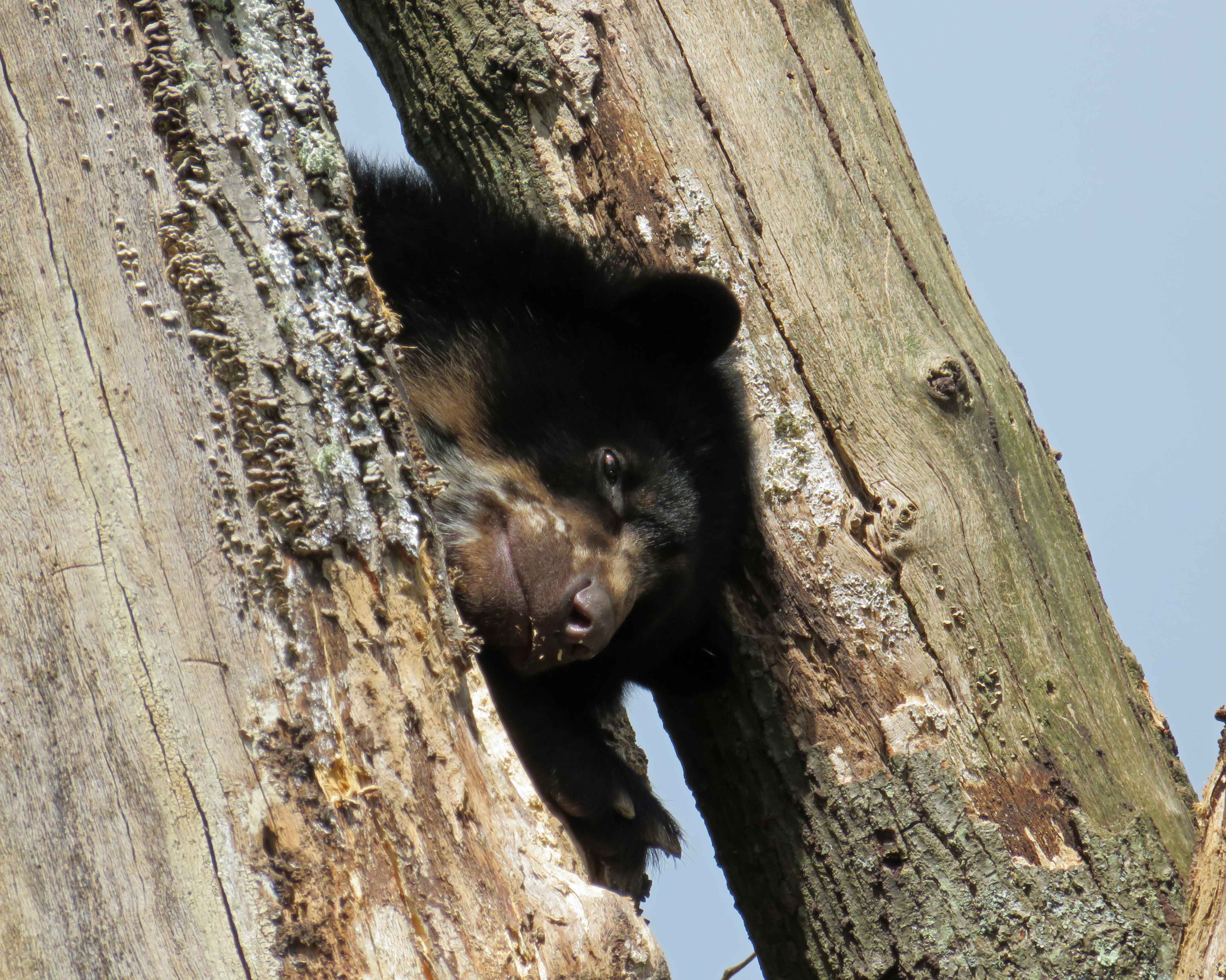
while Chui was again very firmly mounting Bahia nearby. After some time, she squealed loudly and wriggled away. When he followed and persistently pestered her she reared up snarling. He responded, from behind a branch, and this was between them as they waved their paws at each other. Above their heads, Raymi dithered, not sure what to do. 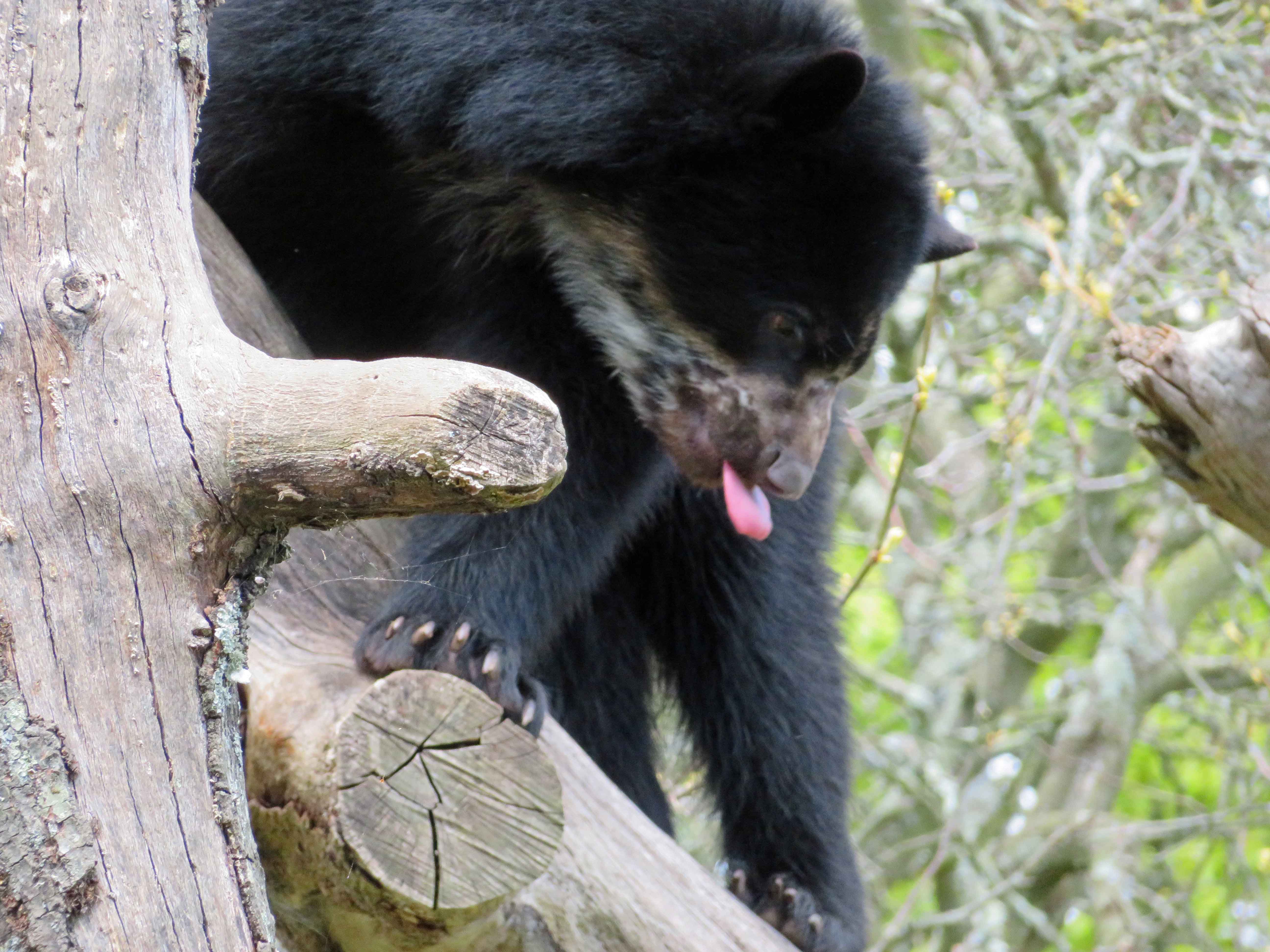
Whenever Bahia turned away, Chui sniffed closely at her bottom and she turned angrily on him. He backed away reluctantly, and soon they were touching noses. When she went to lie on a rock he lay below her, but virtually in touching distance.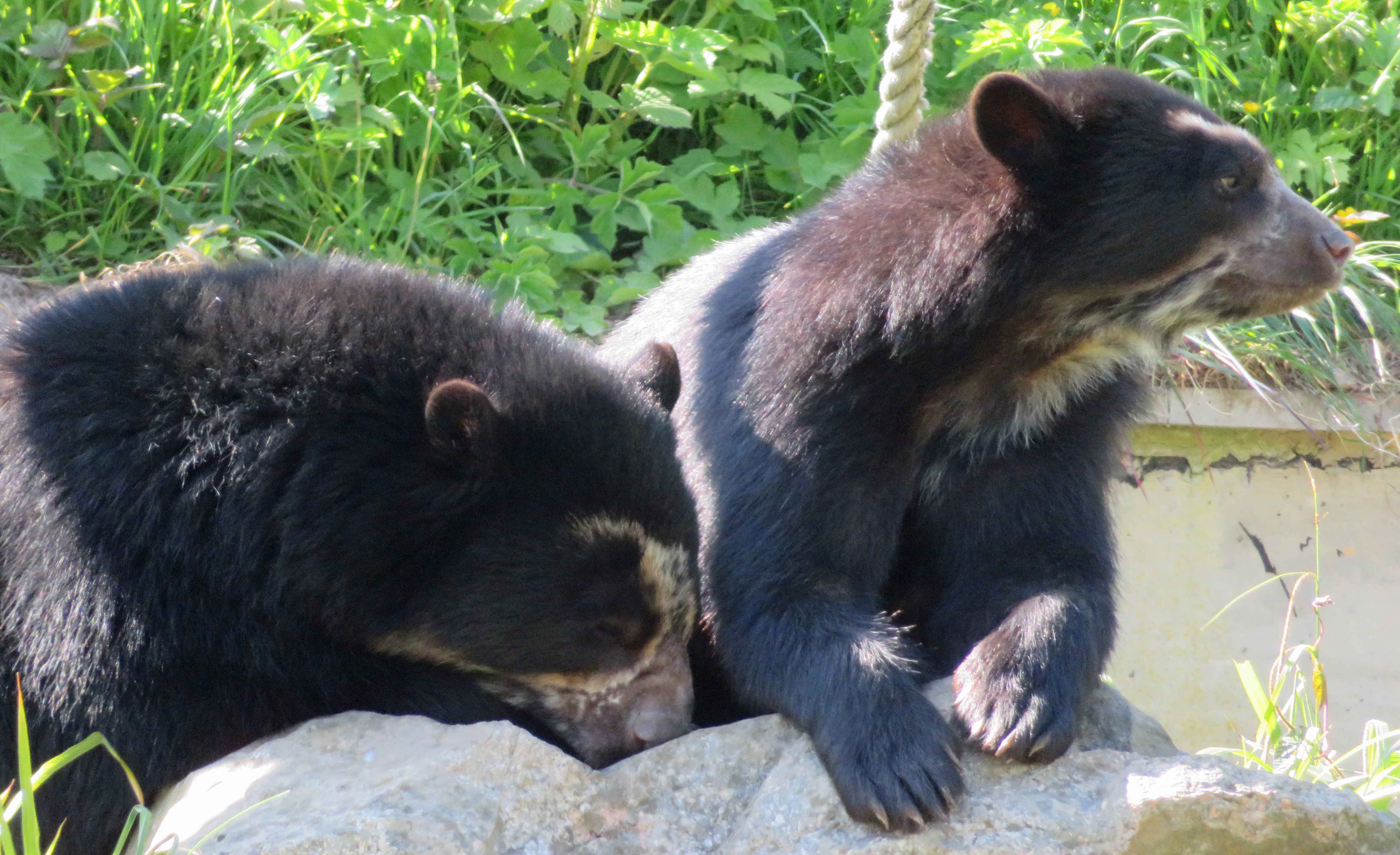
It was peaceful for a while, with Bahia from time to time touching Chui.
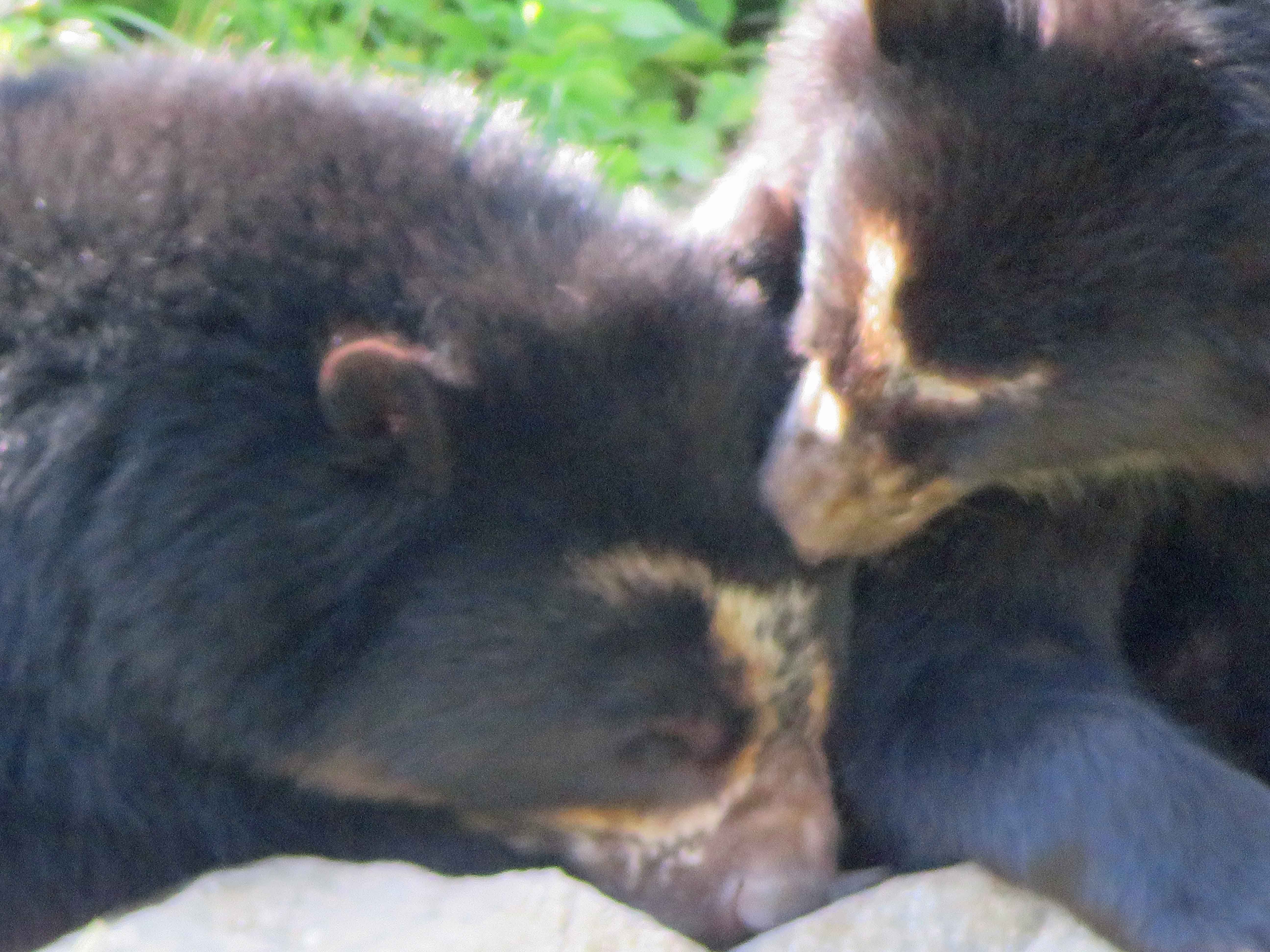
But as soon as she got up there was more trouble, and this only stopped when they went indoors. Even then, from time to time, there was loud female snarling.
Raymi badly wanted to come down when Bahia disappeared from his sight, but he didn't dare to risk meeting Chui. The situation only improved for him when Bahia and Chui were called for their evening snack. It was some time before they emerged, and their approach was heralded by more snarling. They disappeared around the back of the house, and again Raymi considered descending. He did eventually begin to do so,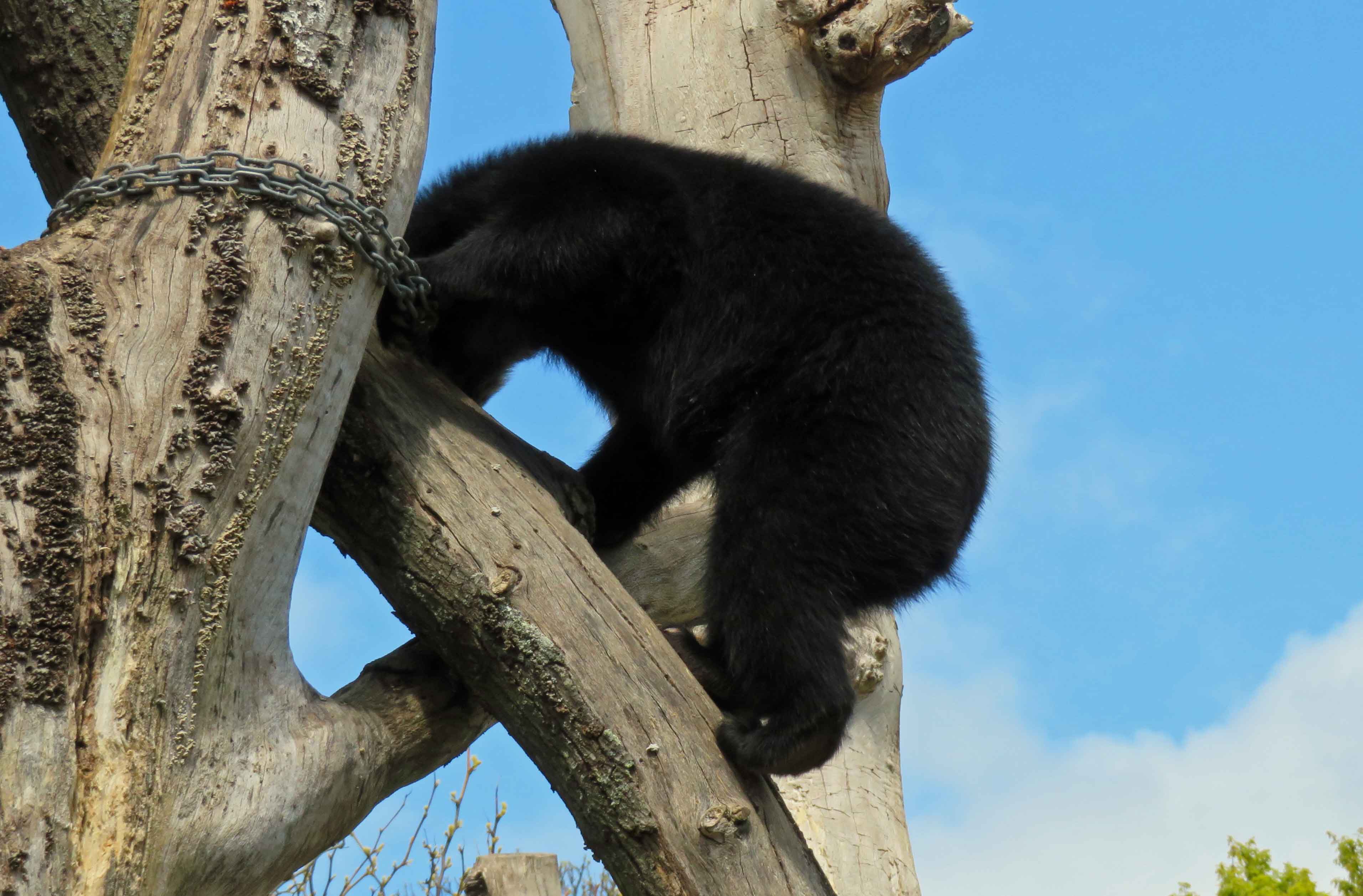 and about then the keepers encouraged Bahia to come back round.
and about then the keepers encouraged Bahia to come back round.
As soon as Raymi was sure his mother was alone he came down and approached her, pausing on the way to sample some bread. Then it was their time to range around the enclosure. First though, Raymi went under the bridge, presumably to stare in safety at Chui on the other side of the barrier. He did this twice, each time waiting for his mother to go first, and always scampering away when Chui approached. Bahia though went right up to the barrier to sniff Chui, and reared up to watch him go when he left.
Raymi gambolled up and down by the moat, occasionally splashing into it when he misjudged his footing. I thought he wanted to have a drink but at last he stepped down into the water and swam quite a distance towards the bridge. At the end of his stretch of swimming he stopped and stood up to wade out into deeper water,
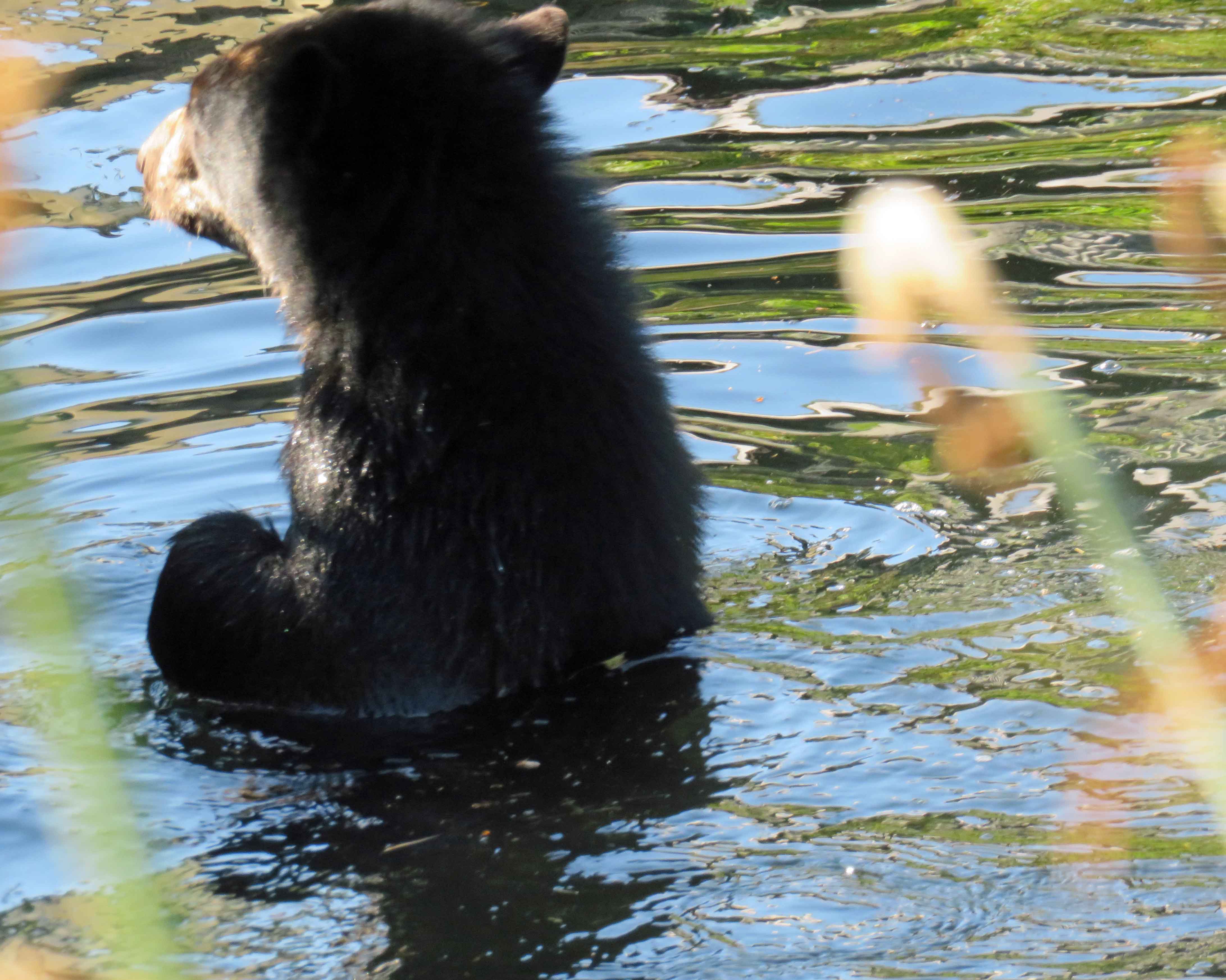
then came back to the edge of the moat and wallowed along it until he climbed out and gambolled away.
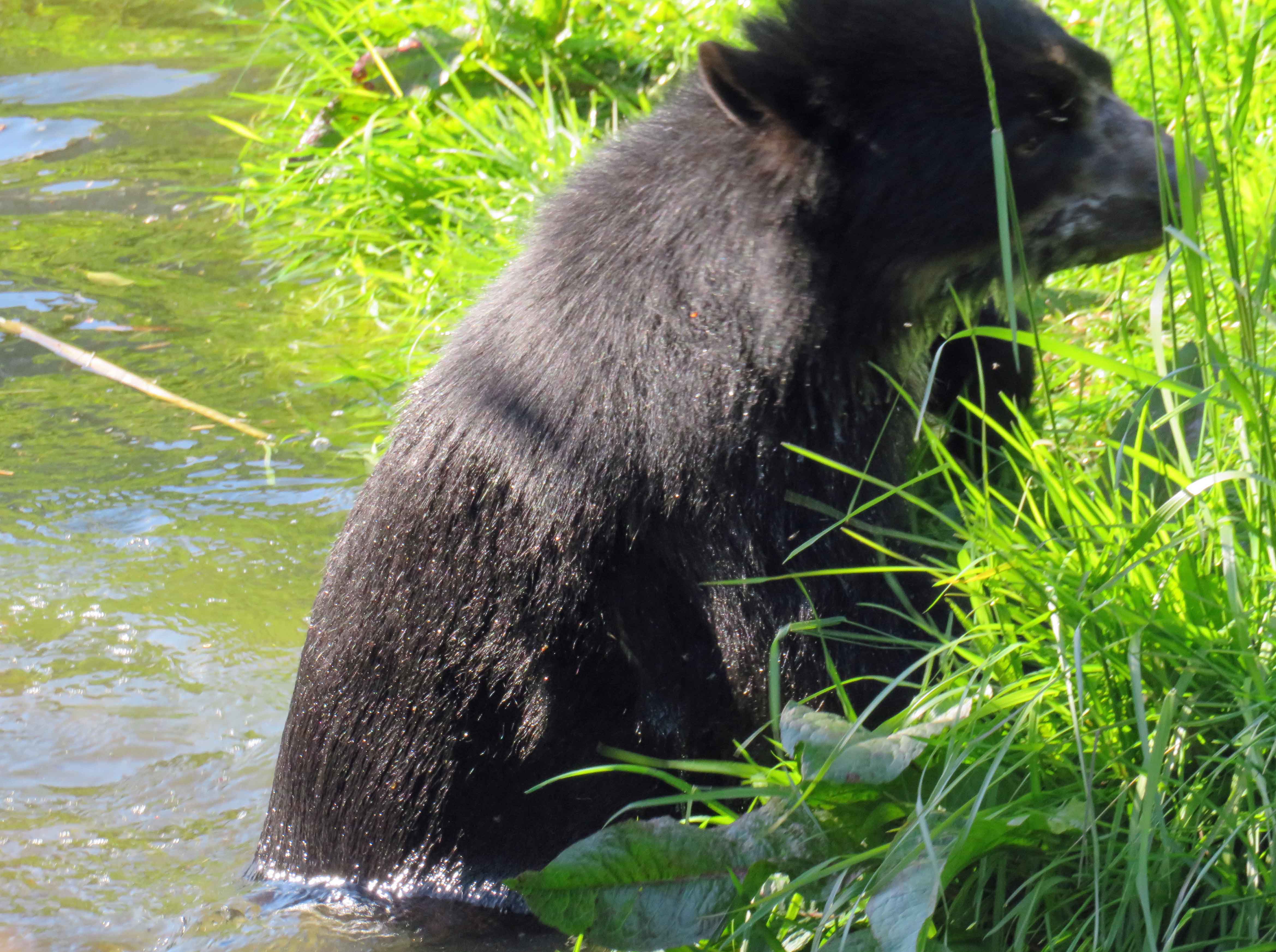
He clearly so much enjoyed the freedom to run around, after yet another afternoon up in a tree. Whenever his father is out, that's where he has to be.
11 Waiting for action
27 April 2017
First thing this morning the bears were each was in their own space in the front enclosure, each at one point of the triangle created by the trunk matrix.
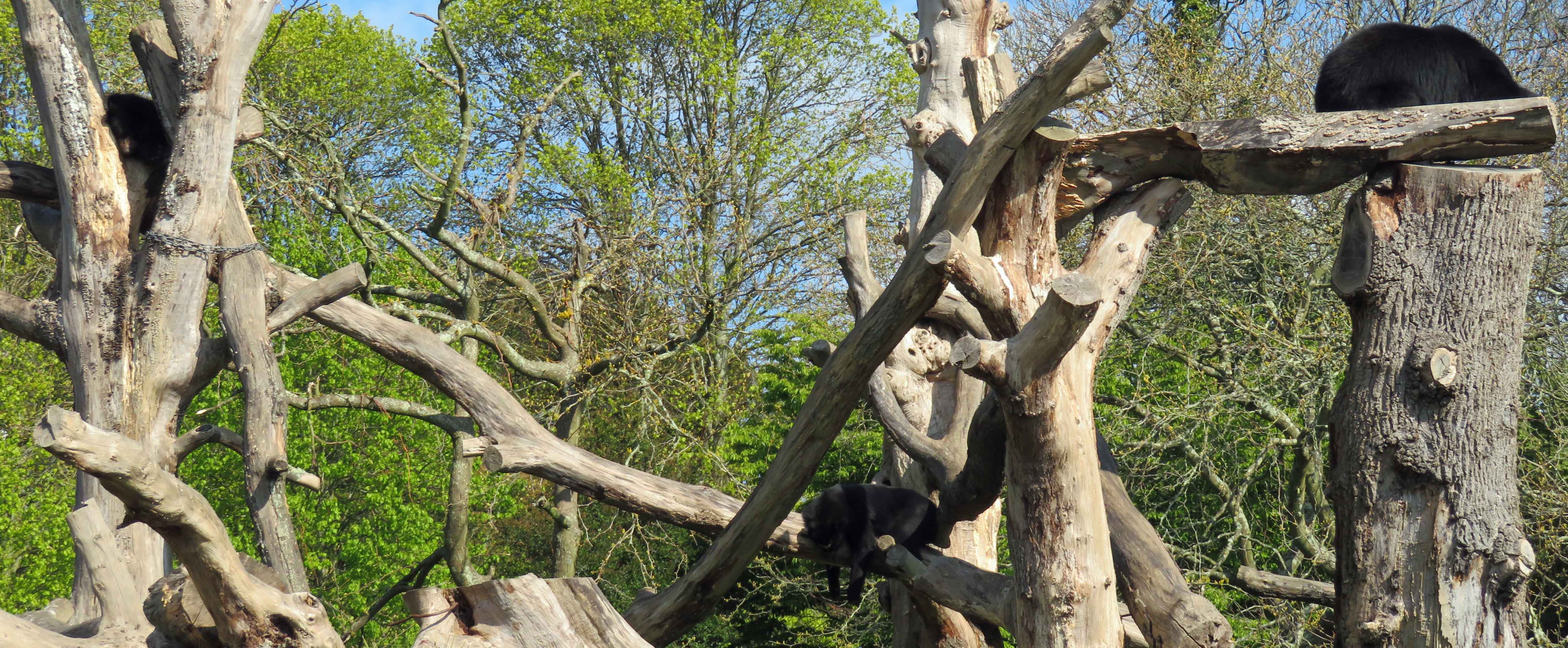
This seems to be the positioning they like at this time of the day, perhaps soaking up sun after a night indoors.
Bahia was draped limply over her favourite trunk.
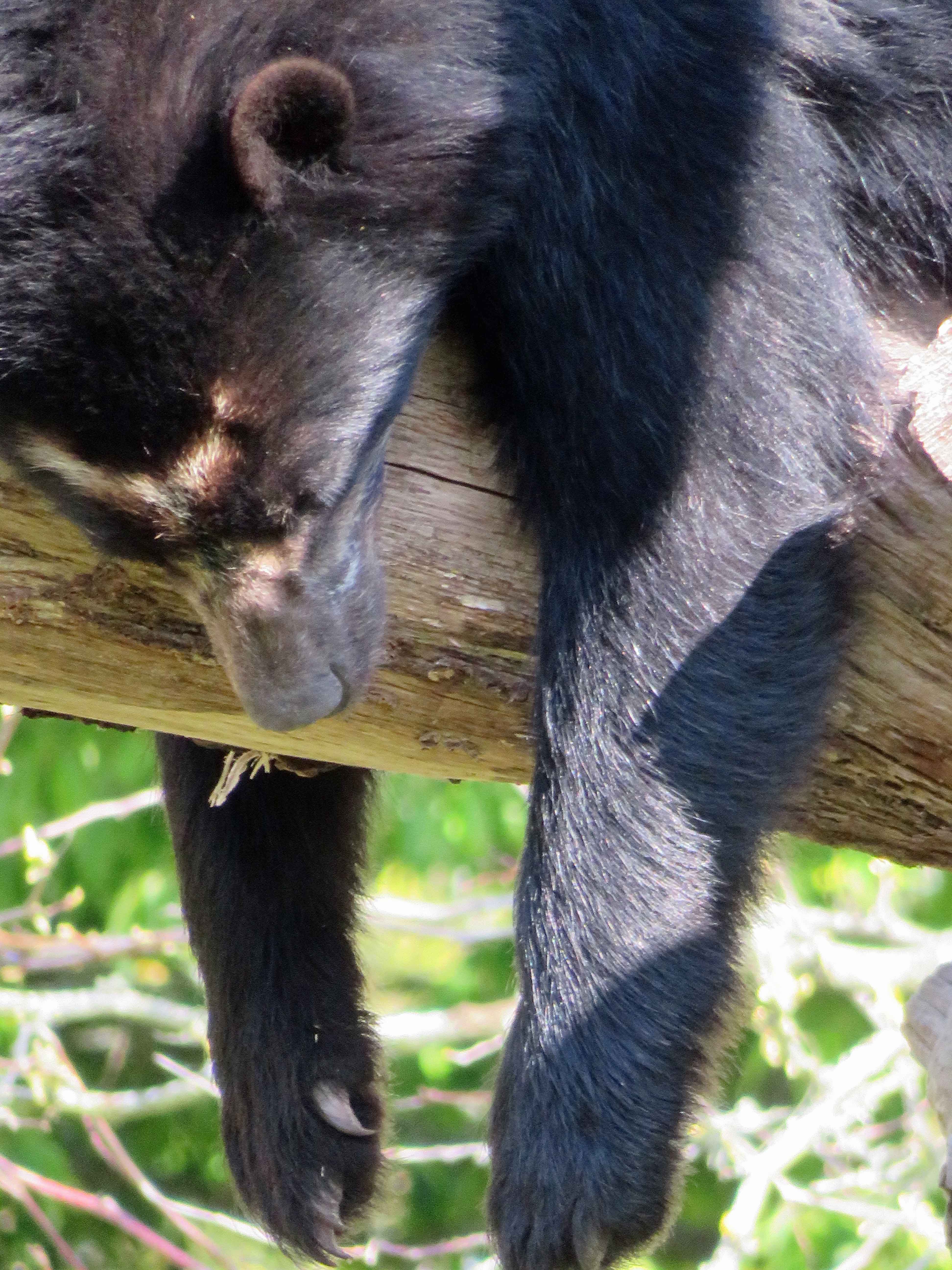
Chui was hunched on a high platform close to the bear house. Raymi was wedged even higher, in his preferred crook close to the approach from the cafe. Both the adults seemed comatose in the sunshine, but Raymi was fidgeting nervously.
Soon the tension was palpable as Chui began moving purposefully from his early morning spot out over the trunks towards Raymi, who was getting very agitated. Bahia was climbing up to Raymi, positioning herself in front of him when she reached him.
Chui halted, and after a little Bahia came down a bit and went across a trunk away from Raymi. Chui hesitated, then climbed down to the ground. He was clearly torn between going after Raymi, or following Bahia. She clinched the matter by coming closer, then passing right in front of him. He couldn't resist and mounted her for a prolonged mating session. Afterwards he kept pulling her back for some time, hugging her tightly from the rear.
Then they both came down to the moat to sit and wait for the keeper, while Raymi hovered anxiously out of reach.
It appears that Chui is now actually less sex driven than he was. There used to be continuous screams of indignant rejection from Bahia, although these can still be heard ringing across the enclosure from time to time. Chui seems to know that Bahia makes herself available to protect Raymi, and capitalises on that.
After lunch, they were altogether indoors. Raymi was up on top of the door cage with Bahia, while Chui lay below at the front of the cage. Raymi couldn't rest, constantly peering over the edge of the cage to see what Chui was doing. Chui seemed peaceful, waiting for action from the kitchen that was out of sight, but not of scenting or hearing. Bahia was also somnolent, her eyes just open as slits, but she came to peer over the edge of the cage at Chui when some kitchen noise caught her attention. Raymi moved behind her, with his back to the wall, and began to chew a stem of leaves.
By late afternoon, they were all in the front outdoor space, with Raymi up a different trunk from his usual one. He was lying, almost sunbathing, for a short time, on the flat trunk that Chui likes. IMG_0325.jpeg
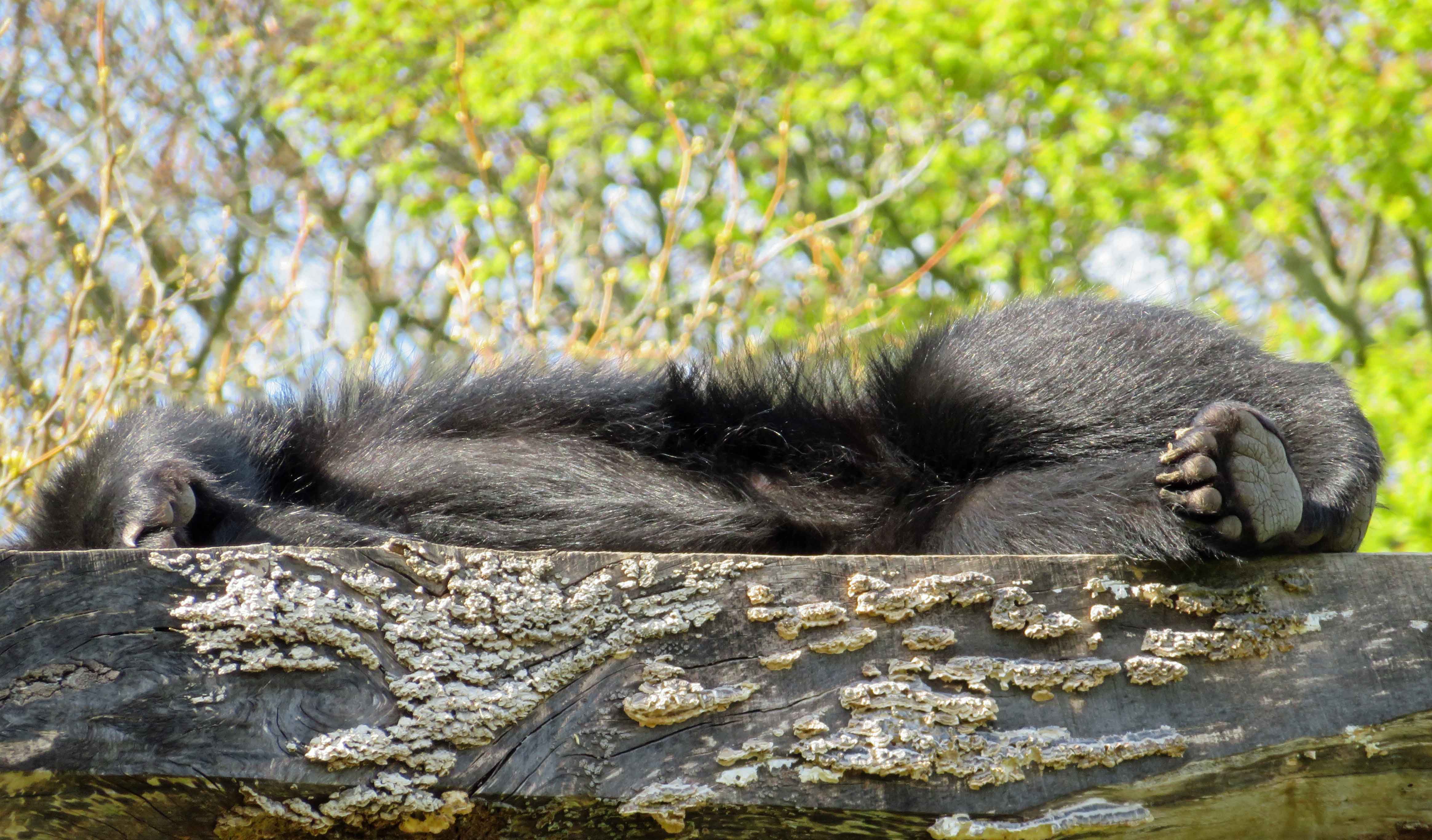
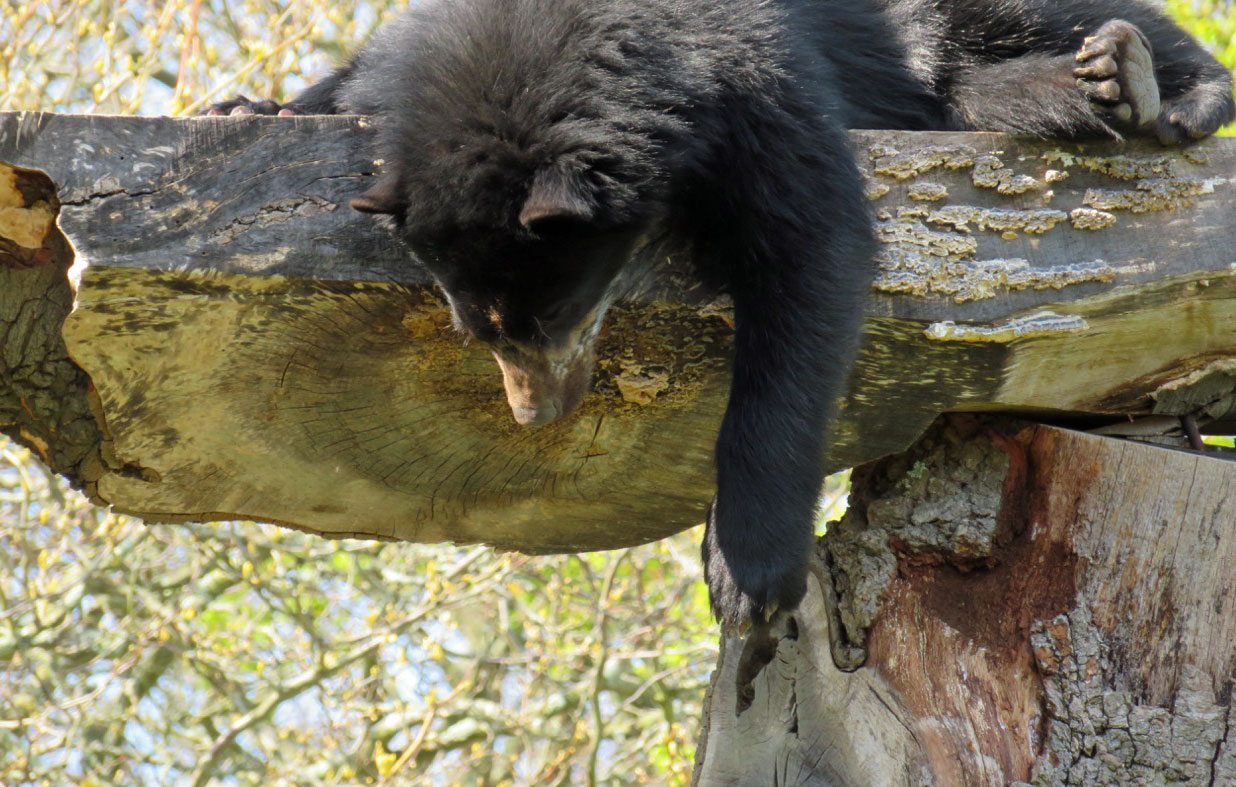
Below, Bahia and Chui were together, Bahia tearing up wood, Chui just staying beside her.
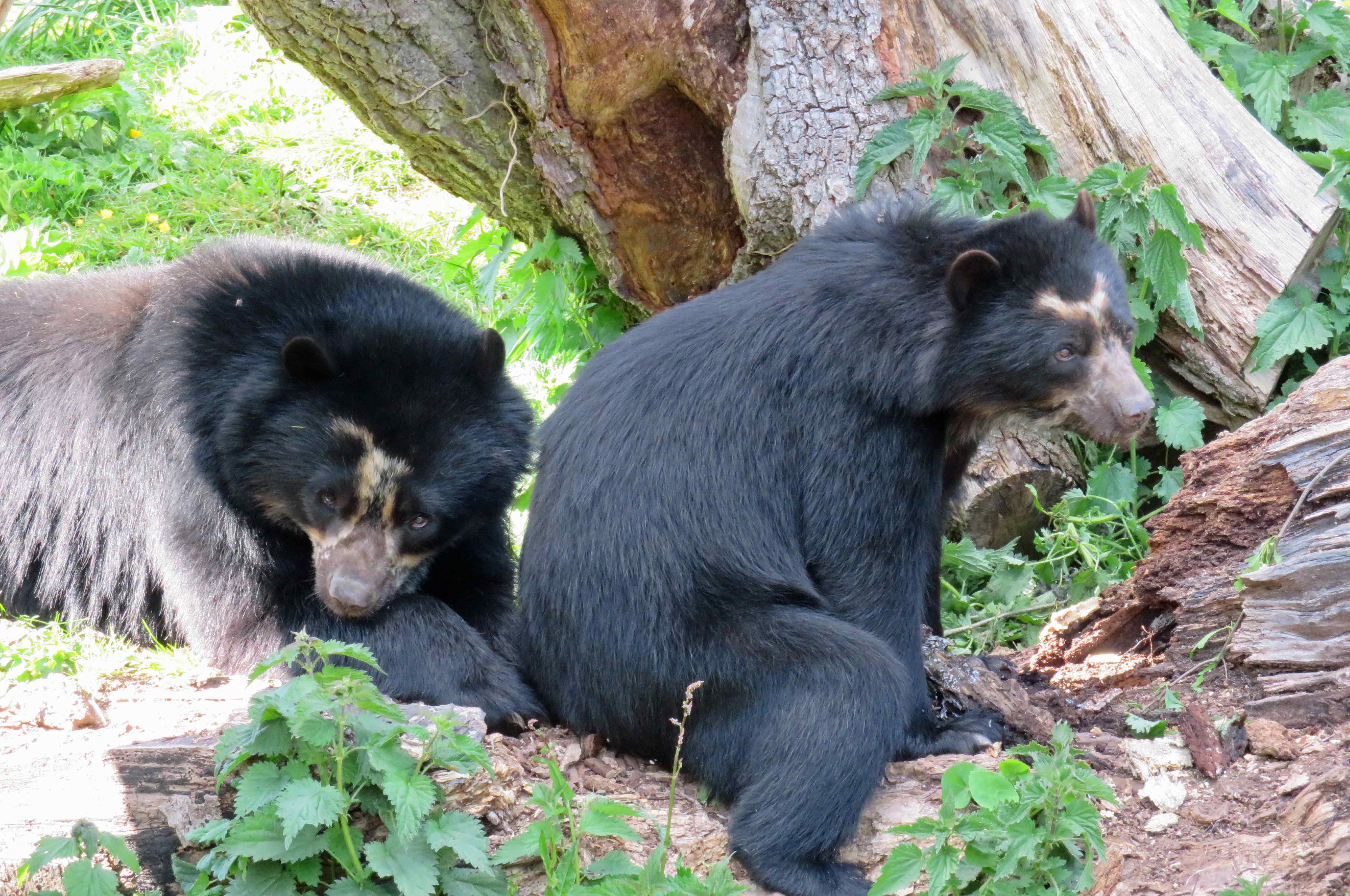
Occasionally they nuzzled each other affectionately.
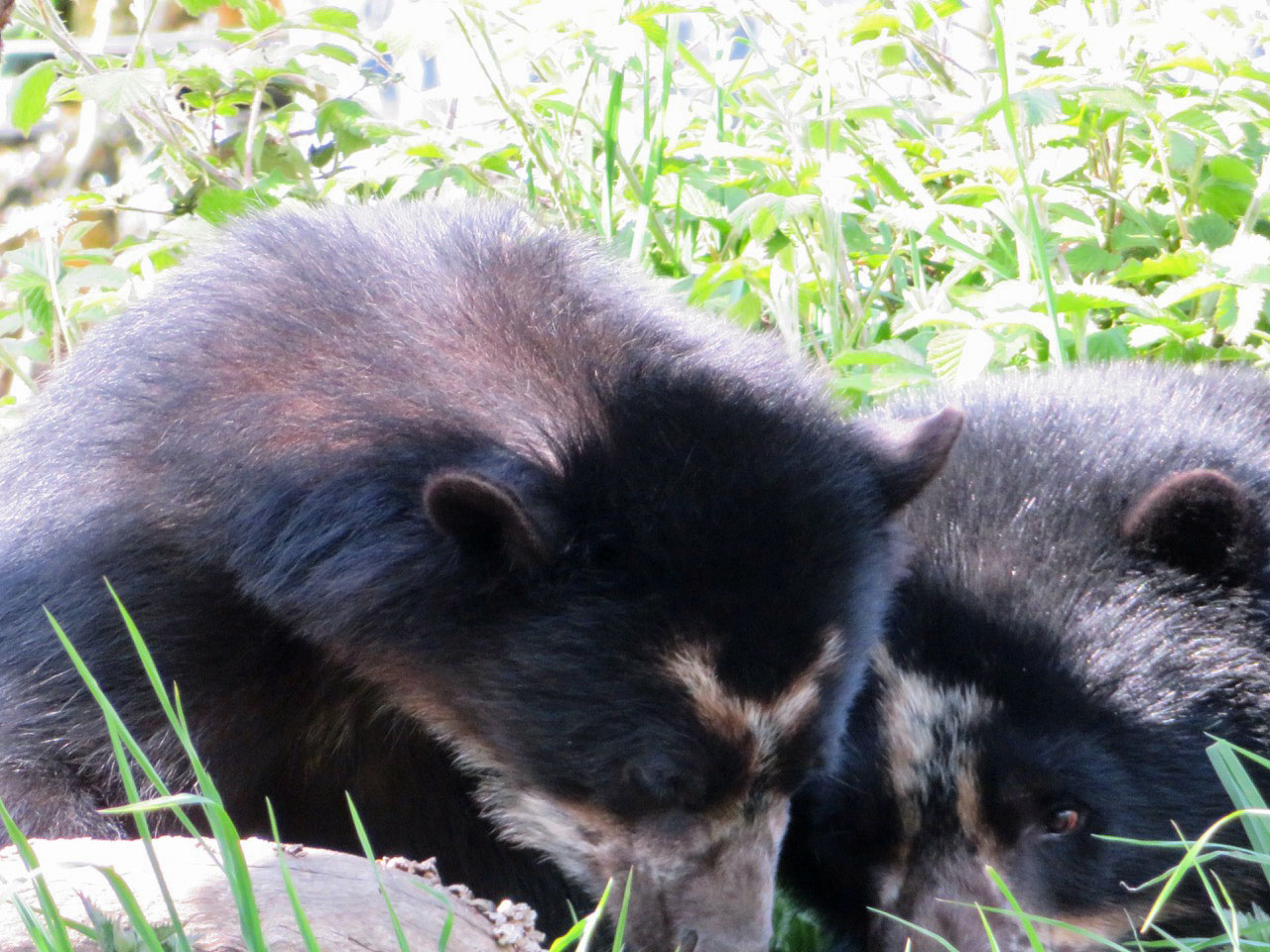
The scene only changed when the adults were called to the rear for feeding, and Chui was separated from Bahia, encouraged into the back outdoor space.
Raymi waited and waited, and at last began to descend when he heard the keeper calling him.
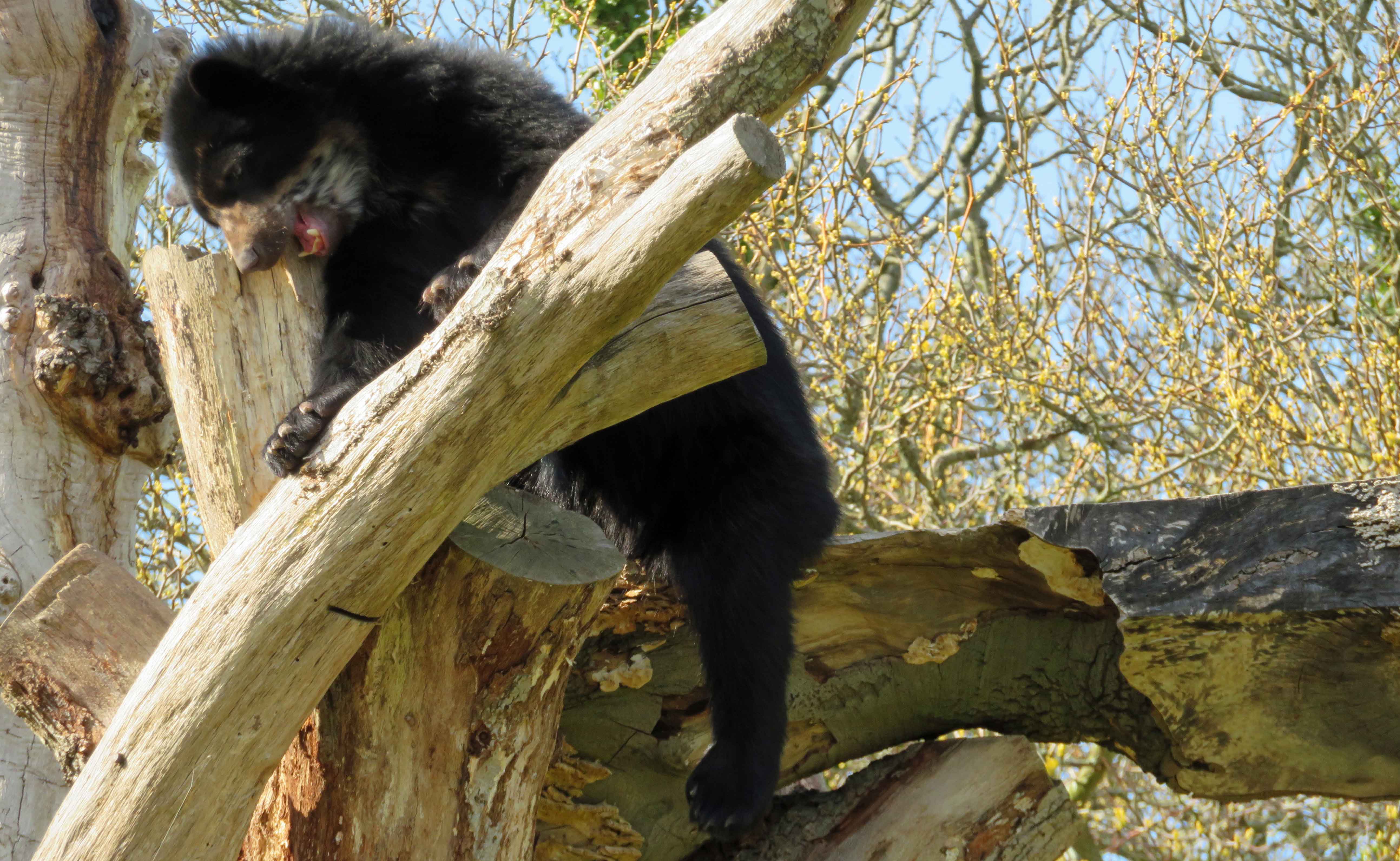
Bahia came back for him at the same time.
They went indoors shortly after they'd eaten, but Chui stayed outside, happily licking at bits of grass.